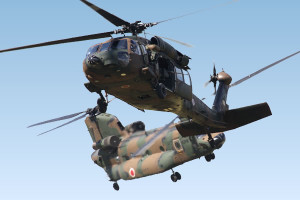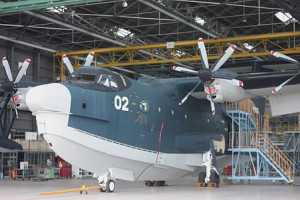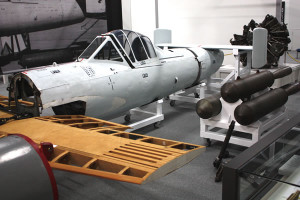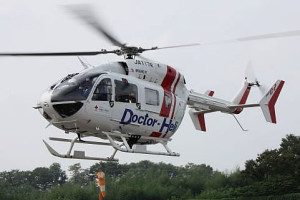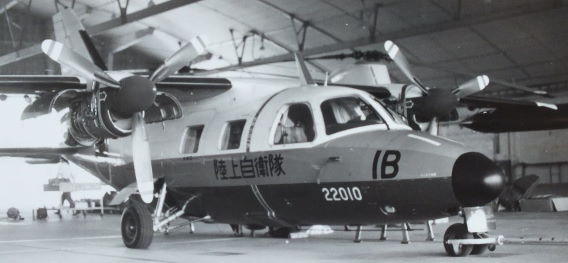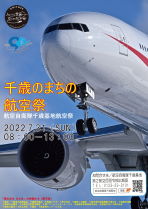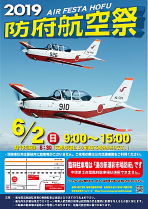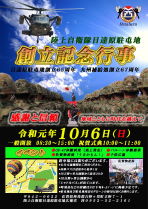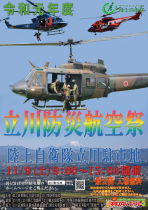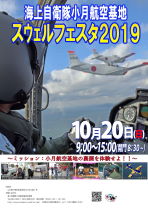JGSDF Squadron Histories & Markings Part 2
The continuation of the JGSDF Squadron Histories listing covers the following units:
| Part 2 | |
| 12th Helicopter Unit | 15th Helicopter Unit (2013-) |
| 13th to 14th Aviation Squadrons | 101st Aviation Squadron (1972-2010) |
| 15th Aviation Squadron (2010-13) | 102nd to 109th Squadrons |
| 1st to 5th Anti-Tank Helicopter Units (3rd ATH renamed 1st Combat Helicopter Sqn Mar. 2021) |
|
| Regional Army Aviation Sqns | Regional Army Helicopter Sqns |
| (North / Northeastern / Eastern / Central / Western) | |
| Special Transport Helicopter Squadron | |
| Transport Aviation Group (2020-) (to eventually command V-22B units) |
|
| Main Aviation School/Branch Schools Training Support Organisation |
|
| Experimental Flying Unit | |
 (Photo: [12th Helicopter Unit, Soumagahara]: Japan Ministry of Defense/JGSDF)
(Photo: [12th Helicopter Unit, Soumagahara]: Japan Ministry of Defense/JGSDF)
|
12th |
Formed | (As 12th AvSqn) January 1962 (Kasumigaura) (As 12th Helicopter Unit) March 27, 2001 (Soumagahara) |
| Current Base | Soumagahara (1st Flt at Kita-Utsunomiya) |
Having newly formed at Kasumigaura in January 1962, the then 12th AvSqn moved to Kita-Utsunomiya the following November.
 A pair of 12th AvSqn L-19 Bird Dogs at Utsunomiya in April 1977. One of the 10 L-19As operated by
A pair of 12th AvSqn L-19 Bird Dogs at Utsunomiya in April 1977. One of the 10 L-19As operated by
the National Security Force in the 1950s, the L-19A nearest the camera was written off in a
crash on December 10, 1978. (Photo: Akira Watanabe)
Eastern Army Aviation Group command was supplanted by direct divisional command on March 28, 1994, and remained so for the next seven years.
The 12th Helicopter Unit came into existence on March 27, 2001, the day after the former 12th Division was reorganized as the 12th Brigade and uniquely incorporated a heavy-lift capability following the JGSDF’s adoption of the integrated air mobile brigade concept. Aside from an HQ Flight and a 1st Flight now equipped with the UH-60JA, which remained at Kita-Utsunomiya, a new 2nd Flight was formed, flying the Chinook from the then newly established airfield facilities at Camp Soumagahara.
 A pair of ski-equipped UH-60JAs from the 1st Flight, 12th Helicopter Unit fly over the
A pair of ski-equipped UH-60JAs from the 1st Flight, 12th Helicopter Unit fly over the
Jomo-Sanzan region of Gunma Prefecture. (Photo: JGSDF/12th Brigade)
Strategically based in Japan’s centre for rapid-reaction deployment to any corner of the four mainland islands, the 12th Helicopter Unit’s primary area of responsibility covers Gunma and Tochigi prefectures and two in the Koshinetsu sub-region, namely Nagano and Niigata. As can be seen in the snapshots of operations on this page, when the disaster relief need arises, there is mutual reinforcement of the 1st Transport Helicopter Group at Kisarazu and the Tachikawa-based Eastern Army Aviation Group.
 A 2nd Flight CH-47JA bathed in autumn sunshine at Tachikawa in November 2013.
A 2nd Flight CH-47JA bathed in autumn sunshine at Tachikawa in November 2013.
According to feature article in the March 2016 issue of a PR magazine published by the JGSDF Kanto Regional Bureau, in July 2014 a representative helicopter was bestowed with an award for the unit having achieved 2,400 accident-free flight hours since its formation.
| 12th Helicopter Squadron Chronology of Operations | |
| March to June 2011 | Great East Japan Earthquake |
| Nov. 16–25, 2012 | Forest firefighting, Miyakejima, Tokyo |
| Apr. 28, 2013 | Forest firefighting, Mt. Kirigamine, Nagano Prefecture |
| May 7, 2013 | Forest firefighting, Kiryu, Gunma Prefecture |
| May 8–13, 2013 | Forest firefighting, Nirasaki, Yamanashi Prefecture |
| Feb. 15–23, 2014 | Heavy snowfall in Kanto Region |
| Mar. 25–26, 2014 | Forest firefighting, Miyadamachi, Hitachi, Ibaraki Prefecture |
| Apr. 16–19, 2014 | Forest firefighting, Hishimachi, Kiryu, Gunma Prefecture |
| Apr. 23–24, 2014 | Forest firefighting, Ashikaga, Tochigi Prefecture |
| May 8–9, 2014 | Forest firefighting, Nishitama, Tokyo |
| Sept. to Oct. 2014 | Volcanic eruption, Mt. Ontake, Nagano Prefecture (Full account later on this page) |
| Mar. 31 to Apr. 2, 2015 | Forest firefighting, Okaya, Nagano Prefecture |
| July 3–Aug. 7, 2015 | Resumed search for missing persons, Mt. Ontake, Nagano Prefecture |
| Sept. 10–19, 2015 | Kanto/Tohoku torrential rainfall (Ibaraki Prefecture) |
| April to May 2016 | Kumamoto Earthquakes |
| Jan. 10–11, 2018 | Forest firefighting, Kanra, Gunma Prefecture |
| July to Aug. 2018 | Torrential rainfall in western Japan |
| early April 2019 | Forest firefighting, Nagano Prefecture |
| Sept. 6 to Oct. 14, 2018 | Hokkaido Eastern Iburi Earthquake |
| October 2019 | Typhoon No. 19 |
| Mar. 6, 2020 | End of OH-6D era |
| Mar. 27–28, 2020 | Forest firefighting, Kuji District, Ibaraki Prefecture |
Snapshots of 12th Helicopter Unit Operations
 (Photo [circa 2014]: Japan Ministry of Defense/JGSDF)
(Photo [circa 2014]: Japan Ministry of Defense/JGSDF)
April 28, 2013 / Forest Firefighting, Mt. Kirigamine, Nagano Prefecture
 April showers (Photo: Japan Ministry of Defense/JGSDF)
April showers (Photo: Japan Ministry of Defense/JGSDF)
Having broken out on a plateau high on this 1,925-metre (6,316ft) peak at around 09:40, this fire met with a rapid coordinated response. The Nagano Prefecture governor made a request to the 13th Infantry Regiment in Matsumoto for JGSDF assistance in combatting the blaze at 13:00. This triggered the involvement of a total of 30 service personnel, 10 vehicles and five helicopters.
An eyewitness provided photos to a blog (link) account of events, which provides a good overview of the standard operating procedures. The scene of the fire being in Nagano Prefecture, the crew of that prefecture’s aviation unit helicopter (Bell 412EP*) received support from aircraft sent by four neighbouring prefectures: Gifu (BK-117), Gunma (another Bell 412EP*), Saitama (AS365N3) and Yamanashi (S-76B). In this case, use was made of facilities, including a specially provided windsock, belonging to the Kirigamine Gliding Society, which operates from a runway at an elevation of 1,680 metres, and the wide expanse of a ski slope in what was the off season. The water supply was drawn from the lake in nearby Tatenoumi Park in Suwa.
While awaiting the JGSDF, the local fire services and five prefectural helicopters had worked to at least contain the blaze. The load-carrying capacity of the bucket-wielding Gifu Prefecture BK-117 had left a lot to be desired, but both Bell 412EPs and the AS365N3 were equipped with belly-mounted Fire Attacker water release systems.
 (Photo [Soumagahara, April 2019]: WANI via Twitter @wanikon428)
(Photo [Soumagahara, April 2019]: WANI via Twitter @wanikon428)
In the form of a 12th Helicopter Unit OH-6D, the JGSDF advanced guard departed Soumagahara at around 14:45 and sped to the scene to gather information. After a flight lasting around 30 minutes, a pair of 12th Helicopter Unit Chinooks arrived at 16:00, set down on a flat area in front of a winch shed and disgorged a jeep prior to the arrival of another OH-6D from the same unit. A TV camera-equipped Eastern Army Helicopter Squadron UH-1J departed Tachikawa at around 16:10.
Three-man ground crews attached the fire buckets, and the Chinook pilots literally swung into action. Making short work of dousing the flames—they dropped 47.3 tonnes in nine runs—the Chinooks and the other JGSDF helicopters were all stood down at around 17:00. Five vehicles and 30 men from the Matsumoto garrison, which had departed at around 15:10, had only just arrived at around 16:45.
The cause of the fire had been a strong wind that had blown sparks—from a supposedly controlled burn-off within what is a quasi-national park—outside the prepared safety area and set alight to 154 hectares (380 acres); luckily, no one had been injured.
* Sad to relate, both of the Bell helicopters that participated in this operation were to be lost in fatal accidents: Nagano’s Alps on March 5, 2017, Gunma’s Haruna on August 10, 2018. (See the Bulletin Board pages of this website.)
May 7, 2013 / Forest Firefighting, Kiryu, Gunma Prefecture
 (Photo [Kiryu, May 2013]: Japan Ministry of Defense/JGSDF)
(Photo [Kiryu, May 2013]: Japan Ministry of Defense/JGSDF)
A Gunma Prefecture governor request for assistance sent to the commanding officer of the 12th Brigade at Soumagahara resulted in another prompt response from the co-located 12th Helicopter Unit. A total of nearly 50 personnel and a force of six helicopters had officially completed their mission soon after 15:00, around seven hours later.
May 8–13, 2013 / Forest Firefighting, Nirasaki, Yamanashi Prefecture
 A scene from the major firefighting operation in Nirasaki, May 2013
A scene from the major firefighting operation in Nirasaki, May 2013
(Photo: Japan Ministry of Defense/JGSDF via Wikimedia Commons)
The day after the mission in Kiryu, the 12th was called into what was to become a protracted six-day firefighting operation that involved 18 helicopters and around 530 personnel. Air support was provided by the Eastern Army Helicopter Squadron.
Feb. 15–23, 2014 / Response to Heavy Snowfall in Kanto Region
Over a nine-day period following excessive snowfall in the Kanto area, a total of around 5,000 JGSDF personnel, 1,000 vehicles and 130 aircraft were engaged in rescue, supply and snow-clearing operations.
Throughout this time, the 12th Helicopter Unit provided its airlift capabilities in support of operations in its home prefecture of Gunma as well as in Nagano and Yamanashi prefectures.
Mar. 25–26, 2014 / Forest Firefighting, Miyadamachi, Hitachi, Ibaraki Prefecture
 Refueling in preparation for the restart of operations the following morning.
Refueling in preparation for the restart of operations the following morning.
(Photo: Japan Ministry of Defense/JGSDF)
A total of 16 helicopters from the 12th Helicopter Unit and the 1st AvSqn, supported by around 110 personnel and 23 vehicles, were sent to deal with this blaze. The Ibaraki Prefecture governor having requested assistance via the local garrison in Katsuta at around 15:00 on March 25, the fire had been brought under control and the JGSDF units withdrawn down 24 hours later.
Apr. 16–19, 2014 / Forest Firefighting, Hishimachi, Kiryu, Gunma Prefecture
 Preparing a 7,600 litre-capacity Bambi Bucket alongside a Chinook.
Preparing a 7,600 litre-capacity Bambi Bucket alongside a Chinook.
(Photo: Japan Ministry of Defense/JGSDF)
A fire having broken out in the vicinity of the Kurokawa Dam on the evening of April 15, the situation was already warranting JGSDF intervention the following morning. A combined force of 43 aircraft, from the 12th Helicopter Unit and 1st Transport Helicopter Group, took part in an operation that lasted until the early evening of April 19.
 Resembling a painting by Kaii Higashiyama (1908–1999), an aerial view of the Hishimachi fire.
Resembling a painting by Kaii Higashiyama (1908–1999), an aerial view of the Hishimachi fire.
(Photo: Japan Ministry of Defense/JGSDF)
Apr. 23–24, 2014 / Forest Firefighting, Ashikaga, Tochigi Prefecture
 Heavy lift operations. An empty Bambi Bucket of the type used by the JGSDF is around
Heavy lift operations. An empty Bambi Bucket of the type used by the JGSDF is around
10 metres long and weighs more than 200 kg. (Photo: Japan Ministry of Defense/JGSDF)
Just four days after the Hishimachi fire, the 12th was this time supported by the Eastern Army Aviation Group in another, thankfully lower key operation. The six helicopters and supporting units could be safely withdrawn at noon the following day.
May 8–9, 2014 / Forest Firefighting, Nishitama District, Tokyo
 More behind the scenes teamwork, this time inside a Chinook
More behind the scenes teamwork, this time inside a Chinook
(Photo: Japan Ministry of Defense/JGSDF)
Only briefly out of the woods, the 12th was back in action when another overnight operation was put in motion early in the afternoon of May 9.
A fire had broken out in the mountains close to the Sakai area of Okutama-machi, the westernmost town under Tokyo’s jurisdiction. Having received a request from the Tokyo governor, the commanding officer of the 1st Division in Nerima initiated a response that involved the 12th operating in concert with the Tachikawa-based 1st AvSqn and Eastern Army Aviation Group.
In all, 50 personnel, 10 vehicles and seven helicopters had been dispatched before operations could be safely wound down at 13:30 the following day.
Sept. 27–Oct. 16, 2014 / Volcanic Eruption, Mt. Ontake, Nagano-Gifu Prefectural Border
 A 12th Helicopter Unit UH-60J hovers above JGSDF and disaster response team personnel
A 12th Helicopter Unit UH-60J hovers above JGSDF and disaster response team personnel
in the initial operation to rescue survivors by hoist from atop Mt. Ontake.
(Photo: Japan Ministry of Defense/JGSDF)
The magnitude of this incident and the 20-day operation that followed warrant more than a cursory “snapshot.” Without warning, a massive eruption of this supposedly dormant volcano occurred shortly before noon on September 27, 2014. A popular destination for hikers and novice climbers, a combination of fine weather and the optimum time for viewing autumn colours fatefully ensured that several hundred people were present on the 3,076-metre peak at the time.
The first fatal eruption in Japan since 1991, when Nagasaki Prefecture’s Mount Unzen killed 43, including news media personnel and two volcanologists, the drama that unfolded here filled the news channels for days and weeks on end. Although, unlike Mount Unzen, there was no lava flow, the explosive mixture of steam, hot ash, rocks and gases claimed the lives of 63 people, five of whom have never been found.
Located 200km west of Tokyo and only 100km northeast of Nagoya, the mountain’s location at least facilitated a full-scale, rapid response, in which the 12th Helicopter Unit naturally played a significant role. The SDF air units that operated in concert with the 12th were the JGSDF’s 1st Transport Helicopter Group (Kisarazu) and Eastern Army Aviation Group (Tachikawa) as well as the JASDF’s Tactical Reconnaissance Group (Hyakuri), Air Rescue Wing (Komaki) at Hamamatsu Air Rescue Squadron.
As seen in the dramatic header photo of this section, the UH-60J was the helicopter of choice in the initial stages, the extraction of survivors and confirmation of fatalities. Although many had already made their own way down, around 40 people had spent that first night sheltering as best they could where they were on the mountain, the roof of a lodge having been destroyed by falling rock, and other buildings covered with ash.
A YouTube video (link) provides more of an idea of the conditions the helicopter crews and rescuers faced, but not of the smell of the high sulphur concentrations that forced back several rescue attempts. On that first day, UH-60J operations from the Nagano Prefecture side of the mountain alone resulted in the rescue of 21 people.
 Nagano Prefectural police officers hurriedly carry away a rescue stretcher from the helicopter
Nagano Prefectural police officers hurriedly carry away a rescue stretcher from the helicopter
that has just brought them to the scene. (Photo: Japan Ministry of Defense/ JGSDF)
On September 29, those high levels of hydrogen sulphide gas emissions caused the complete suspension of operations. With dozens still stranded on the mountain, fears of another eruption amid escalating volcanic activity on September 30 prevented the active participation of a force of 850 rescuers, comprising Nagano and Gifu prefectural police and SDF personnel. Helicopters that had been about to airlift other rescue teams directly to the scene from Matsubara Sports Park in the village of Otaki, on the Nagano Prefecture side of the mountain, were grounded for the same reason.
 Taking advantage of the enforced lull in operations on September 30, a 12th Helicopter Unit
Taking advantage of the enforced lull in operations on September 30, a 12th Helicopter Unit
Chinook is used during a rehearsal conducted to ensure that the transfer of victims to waiting
ambulances would proceed smoothly. (Photo: Japan Ministry of Defense/JGSDF)
The generally fine weather belied the fact that the daytime temperature at the peak was only around 5 deg C, dropping to below freezing at night. As the rescuers were to discover as the days passed, the flight to the peak was the easy part. Demanding conditions were created by the vast amounts of volcanic ash turning heavy and muddy when mixed with rain and becoming like cement when dry; there was also the ever-present risk of rain-induced mudslides.
 A 12th Helicopter Unit CH-47J resting at the temporary heliport set up at the Matsubara Sports
A 12th Helicopter Unit CH-47J resting at the temporary heliport set up at the Matsubara Sports
Park in the village of Otaki, Nagano Prefecture. For protection against foreign object damage
(FOD), this aircraft is fitted with engine inlet screens, which do not affect performance,
rather than filters. (Photo: きたさん [Kitasan] via Twitter @kitaichi_e5)
 Mount Ontake was still venting its anger on the afternoon of September 30, forcing the coordinating
Mount Ontake was still venting its anger on the afternoon of September 30, forcing the coordinating
Nagano Prefecture disaster relief authorities to suspend operations.
(Photo: Japan Ministry of Defense/JGSDF)
During the course of sombre operations on October 1, the death of 35 people was confirmed, and the sad task of airlifting their bodies to Matsubara Sports Park completed. From there, they were transported 20km by road to the former Ueda Elementary School in the town of Kiso.
 October 1. The inscriptions on the helmets of the disaster relief team members nearest the camera
October 1. The inscriptions on the helmets of the disaster relief team members nearest the camera
on board a Chinook reveal that they are from the Nagoya Fire Department, the city being only
100km southwest of the mountain. (Photo: Japan Ministry of Defense/ JGSDF)
Under normal conditions, the UH-60 manual recommends that prolonged rearward flight and downwind hovering be avoided to prevent the accumulation of exhaust fumes in the helicopter and heat damage to windows on open cargo doors. For this rescue operation, pilots and crews were subjected to noxious gases while maneuvering at or near the type’s high-altitude hovering limit. An undated photo in the December 2014 issue of Kōkū Fan magazine shows a UH-60JA after landing on the mountain, buried up to the top of its mainwheels in ash.
Another factor in the use of UH-60Js was the ability to quickly equip these aircraft with Inlet Particle Separator (IPS) units, filters to prevent the ingestion of volcanic ash into their engines. By October 2, at least one (105th Sqn, 1st Transport Helicopter Group) Chinook [link] was operating with its engine inlets covered by Engine Air Particle Separator (EAPS) filter devices. Although this equipment, purchased for possible overseas desert deployments, can reduce the available engine power, guarding the engines against overheating, turbine blade erosion and general corrosion is of more paramount importance.
Nature seemingly adding insult to injury, the approach of a typhoon brought operations to a halt once again on October 5–6. When the search resumed on October 7, there were still around 1,000 JGSDF, police and fire service personnel being brought in to take part in the search operation. That day, the bodies of more victims were brought down from the mountain to Matsubara Sports Park by CH-47.
The following four links are to photos used in Sankei Shimbun news media reports:
Nagano-Gifu Prefectural Border, September 28, 2014, 12:26 (link)
JGSDF and rescue personnel accommodate one of the injured on a 12th Helicopter Unit UH-60J.
Near the summit of Mt. Ontake, October 1, 2014, 15:18 (link)
Their mission to search for missing climbers over for the day, firefighters board a 12th Helicopter Unit Chinook. (Photo taken from Kyodo News helicopter)
Near summit of Mt. Ontake, October 1, 2014 (link)
Firefighters and SDF members head away from the Chinook in which they have landed and head for their search area. (Photo courtesy Nagoya Fire Department)
Otaki Village, Nagano Prefecture, morning of October 7, 2014 (link)
Carrying a large number of search party personnel, a 12th Helicopter Unit Chinook heads toward Mt. Ontake (in background). The skis were fitted as a way to spread the weight and stabilize the aircraft upon landing.
 (Photo [Oct. 4]: Japan Ministry of Defense/JGSDF)
(Photo [Oct. 4]: Japan Ministry of Defense/JGSDF)
Morning Photo Report, Part 1 (October 11, 2014)
A Gifu Prefecture-based Japanese blogger provided a two-part report on operations from the Matsubara Sports Park in Otaki, Nagano Prefecture. The mountain peaks were about due for their first snowfall, and thus he had wished to record some of the final efforts at searching for and recovering the bodies of the, at that time, eight still missing hikers and climbers. He took with him a case of nutritional drinks for the rescue teams and, if asked, just said he was from the news media, who were already in position for live broadcasts. Presumably previously earmarked for use in the event of somewhat lower key mountain rescue operations, three of the parks sports fields served as temporary heliports.
Taken when still dark at 05:30, the first aircraft images in Part 1 (link) record the arrival and departure, with the aid of the crew’s night vision goggles, of a UH-60J for the nearest main airport at Matsumoto. (The map shows the SDF field camp, which is normally a baseball field, at the top and the three heliports as well as, marked in red, the front-line HQ.)
Interspersed among photos of support vehicles are the arrival of a 12th Helicopter Unit UH-60J and distant shots of search teams being deposited on the mountain by Chinook, having likely flown in directly from Matsumoto airport. The first Chinook arrival at the sports field takes place just before 07:00, stopping only for 11 Nagano Prefecture police and 24 SDF members to file on board before departing.
The blogger quotes from a Kyodo News article published that evening. For the first time in three days, more victims had been found; the recovery of two more had brought the total number missing down to six. According to search party members, by this time helicopters were also being used to airlift drilling equipment to the summit to speed up the search process.
According to the Nagano Prefectural Disaster Response Headquarters, the searchable area near the summit amounted to around 26 hectares (64 acres), excluding the areas near the five craters and steep cliffs. The standard search had been completed on October 10, but the 550 people searching on October 11 had been tasked with just making sure nothing had been overlooked.
Morning Photo Report, Part 2 (October 15, 2014)
Compiled by the same blogger, Part 2 (link) records the comings and goings, between around 07:00 and 08:00, of mainly 12th Helicopter Unit CH-47Js; there are 104th Sqn, 1st Transport Helicopter Group CH-47JA interlopers at 7:21, 7:25, 7:47 and 7:54. The two-minute embedded video, recorded at the same sports park location on the windy morning of October 10, shows the arrival and departure of a 12th Helicopter Unit CH-47J on a day when three Chinooks were in operation.)
A YouTube video also exists of a 12th Helicopter Unit CH-47J at Matsumoto airport, also on October 15 (link).
 A 12th Helicopter Unit Chinook drops off troops at the Ni no Ike crater on Mt. Ontake
A 12th Helicopter Unit Chinook drops off troops at the Ni no Ike crater on Mt. Ontake
on October 15th, 2014, the day before operations had to be brought to a halt.
(Photo: Japan Ministry of Defense/JGSDF)
In the end, due to snowfall and freezing conditions, the search for the bodies of the then six victims still unaccounted for had to be wound up on October 16. (See July 3–Aug. 7, 2015)
According a Japan Ministry of Defense press release dated October 16, 2014, over the course of the operation, the SDF provided around 600 of a total of 7,150 rescue personnel, 130 of 1,835 vehicles and 17 of 298 aircraft.
A six-minute video on the 20-day operation that the JGSDF uploaded to its YouTube channel provides a summary of the daunting task coupled with vivid images of the atrocious conditions under which the rescue and recovery phases were conducted. If nothing else, visitors to this website section should watch the sequence from 3:35–4:10, and not just for the aviation content.
JGSDF YouTube video of Mt. Ontake disaster (link); translation below. (The video has an instrumental accompaniment of Oh, Shenandoah and reverential classical music pieces.)
| JGSDF Video Disaster Relief Deployment Following Eruption on Mt. Ontake | ||
| 11:52, September 27, 2014. Volcanic eruption occurs on Mt. Ontake At 14:31 that day, the CO of the JGSDF’s 13th Infantry Brigade receives a request from the Nagano Prefecture governor for a deployment involving the saving of human lives. |
||
| Selected Titling/Subtitles (video run time) | ||
| (0:18) Sept. 27 Troops from the 13th Infantry Regiment making preparations. | ||
| September 28 | ||
| (0:43) Using downwash to remove the accumulation of ash at the landing point. | ||
| (0:53) UH-60JA winch hoist rescue | ||
| (1:11) 23 people rescued by winch hoist or when helicopters touched down | ||
|
(1:16) Sept. 29 Bodies of eight victims airlifted (total of 12 since previous day) Sept. 30 14:20 Nagano Prefectural Disaster Response HQ personnel take decision to suspend |
||
| October 1 | ||
| (1:24) Mountain huts half demolished by the ash and rocks from the eruption | ||
| (1:37) Ash accumulation at the Kengamine summit [on the Ichi no Ike crater rim] | ||
|
(1:58) Amid the reverberating alarms from gas detectors, JGSDF troops work together with police and |
||
|
(2:07) JASDF UH-60J from Hamamatsu Air Rescue Squadron that had flown in to help airlift victims |
||
| (2:14) Bodies of 35 victims airlifted (total of 47 since Sept. 28) | ||
|
(2:20) Oct. 2 The accumulated ash made conditions underfoot treacherous. |
||
| October 4 | ||
| (2:29) In ash turned into a quagmire by rain, troops head for the summit that still holds missing. | ||
| (2:52) Bodies of four victims airlifted (total of 51 since Sept. 28) | ||
| Nagano Prefectural Disaster Response HQ personnel take decision to suspend SAR operations on Oct. 5–6 due to approaching Typhoon No. 18. |
||
| October 7 | ||
| (2:58) A sliding quagmire of ash | ||
|
(3:06) Bodies of four victims airlifted (total of 54 [55?] since Sept. 28) |
||
| On the summit, icicles were hanging down, something that had not been seen on Oct. 4. | ||
| October 8 | ||
| (3:11) Members of the 12th Logistic Support Troop [at Soumagahara] receive pre-departure health instruction on altitude sickness. |
||
|
(3:17) Amid the sounds of gas detector alarms, troops advance on the ash turned quagmire, only the |
||
|
(3:28) Troops from the 12th Chemical Defense Company use hand-held monitors to check for the |
||
|
(4:08) Body of one more victim airlifted (total of 55 [56?] since Sept. 28) |
||
|
(4:17) Up until Oct. 6, the troops had conducted searches narrowed down to areas based on eyewitness |
||
|
(4:29) Oct. 11 One more victim found [total of 56 (57?) since Sept. 28] |
||
|
Oct. 13–14 As Typhoon No. 19 was due to make landfall, Nagano Prefectural Disaster Response |
||
|
October 15 |
||
|
(4:34) First snow of the year falls on Mt. Ontake |
||
|
(4:52) At 11:00, following a decision made by Nagano Prefectural Disaster Response HQ personnel, |
||
|
October 16 |
||
|
(5:24) As the ash has frozen, troops are by no means able to probe very deeply with their search poles. |
||
|
(5:51) 18:15 Due to the worsening weather conditions in the search area, a request to withdraw |
||
|
(5:59) Oct. 17 Children conveyed their feelings of gratitude with songs at Otaki Elementary School, |
||
|
(6:13) Deployment statistics [in human terms] Number of people rescued: 23 Number of deceased recovered: 56 [later amended to 57, with six missing] |
||
|
(6:20) Roll-call of units deployed |
For its achievements under the most demanding circumstances, the 12th Helicopter Unit was bestowed with a people’s prize award at an event hosted by the Fuji Sankei news media group in October 2015.
Mar. 31 to Apr. 2, 2015 / Forest Firefighting, Okaya, Nagano Prefecture
 A 12th Helicopter Unit Chinook crew prepares to enter the fray.
A 12th Helicopter Unit Chinook crew prepares to enter the fray.
(Photo [Okaya, April 2015]: Japan Ministry of Defense/JGSDF)
The situation in this fire reached the stage where notices to prepare for evacuation were issued to residents living in the riverside districts of Okaya. Thankfully, in the end, the 16 helicopters from the 12th Helicopter Unit and Eastern Army Aviation Group sent in response managed to douse the fire and the impending disaster was averted.
 Scenes from the battle to contain the fire above Okaya, a city of around 50,000 inhabitants.
Scenes from the battle to contain the fire above Okaya, a city of around 50,000 inhabitants.
 (Photos: Japan Ministry of Defense/JGSDF)
(Photos: Japan Ministry of Defense/JGSDF)
July 3–Aug. 7, 2015 / Resumed Search for Missing Persons, Mt. Ontake, Nagano Prefecture
 In a scene reminiscent of the previous year’s mission, a search team that has just been deposited
In a scene reminiscent of the previous year’s mission, a search team that has just been deposited
on the spot courtesy the 12th Helicopter Unit, fans out across Ichi no Ike, one of the
five crater lakes on Mt. Ontake. (Photo: Japan Ministry of Defense/JGSDF)
The summer after the volcanic eruption tragedy, the 12th Helicopter Unit was back on a now tranquil Mt. Ontake as part of a resumption of efforts to recover the six missing victims the mountain had yet to surrender.
As he had been forced to call off the operation with the arrival of winter weather on the peak the previous October, the governor of Nagano Prefecture issued a request for a troop dispatch early in the evening of July 3. Bidding to bring the unfinished business to a successful conclusion, airlift support was again provided by the 12th Helicopter Unit, on this occasion accompanied by the Eastern Army Aviation Squadron. This mission involved not only the airlifting of the police and fire department search parties but also of the materiel, such as shelters, necessary to ensure their safety while in the area.
Viewable via YouTube (link), an Asahi Shimbun news video shot on July 25 shows a Chinook equipped with Engine Air Particle Separator (EAPS) filters landing next to the temporary shelters.
Having sent 1,160 personnel, 210 vehicles and 46 aircraft, all were withdrawn on the evening of August 7.
Sept. 10–19, 2015 / Kanto/Tohoku Torrential Rainfall (Ibaraki Prefecture)
 As floodwaters swirl ominously around a property, the crew of a 12th Helicopter Unit
As floodwaters swirl ominously around a property, the crew of a 12th Helicopter Unit
UH-60J winches a resident to safety. (Photo: Japan Ministry of Defense/JGSDF)
At 07:45 on September 10, 2015, a heavy rainfall warning was issued in Ibaraki Prefecture, and a major river, the Kinugawa, proceeded to burst its banks. As a result, at shortly after 09:00 the prefectural governor formally issued a request with the commanding officer of the JGSDF Engineer School in Katsuta for, initially, a rescue operation to be undertaken and flood prevention measures to be put in place.
Forming the focus of the subsequent intensive tri-service operations were the river cities of Joso and Yuki, which have populations of around 60,000 and 50,000, respectively.
Ground elements had actually been mobilized across the Kanto region since the early hours, but it was to be around 11:40 before four 12th Helicopter Unit UH-60Js became the first of 25 SDF aircraft to participate that day, in this case on SAR missions to assist anybody cut off by the floodwaters.
Viewable on YouTube (link), a short All-Nippon News Network (ANN) report includes dramatic video of one of the UH-60J crews plucking family members from their home, as a raging torrent threatens to sweep everything away. The footage was taken in Joso on that first day, September 10, 2015, following reports that there were around 100 people cut off in the Motoishige district of the city.
The 12th provided three UH-60Js the following day, but as the nature of the mission changed its only involvement thereafter was in the form of three OH-6Ds provided in support on September 14.
Sept. 6 to Oct. 14, 2018 / Hokkaido Eastern Iburi Earthquake
 One of the first tasks assigned to the 12th Helicopter Squadron immediately after the earthquake
One of the first tasks assigned to the 12th Helicopter Squadron immediately after the earthquake
had struck Hokkaido was the airlift to the scene of personnel and equipment from, respectively,
the SoftBank and KDDI mobile communications companies.
(Photo [Tachikawa, Sept. 6]: JGSDF/Eastern Army)
April 5–7, 2019 / Forest Firefighting, Sakuho, Nagano Prefecture
April 6–7, 2019 / Forest Firefighting, Takagimura, Nagano Prefecture
 A 12th HU Chinook in action during the April 2019 firefighting operations in Nagano Prefecture
A 12th HU Chinook in action during the April 2019 firefighting operations in Nagano Prefecture
(Photo: JGSDF/12th Brigade)
For a couple of days early in April 2019, the 12th HU was battling fires at two locations with the Eastern Army Helicopter Squadron and, in the case of the Takagimura operation, with additional assistance from the 1st Transport Helicopter Group.
Both operations involved 12th HU OH-6Ds and UH-60JAs in support roles as well as Chinooks. The Sakuho operation required 525 tonnes of water in 105 drops, that at Takagimura 235 tonnes in 47 drops.
October 2019 / Typhoon No. 19 (Hagibis)
 A Typhoon No. 19 flood victim is carefully brought to safety aboard a hovering UH-60J
A Typhoon No. 19 flood victim is carefully brought to safety aboard a hovering UH-60J
from the 1st Sqn of the 12th Helicopter Unit. (Photo: JGSDF/Eastern Army)
March 6, 2020 / End of the OH-6D Era
 (Photo [Mar. 6, 2020]: JGSDF/12th Brigade Public Relations via Twitter)
(Photo [Mar. 6, 2020]: JGSDF/12th Brigade Public Relations via Twitter)
In scenes repeated at other JGSDF aviation centres during the month, the 12th made mainstream media and aviation magazine headlines early in March 2020 when a ceremony was held to mark the end of its association with the OH-6D. Centre stage for the events surrounding its final flight on March 6, 2020, 31313—the last of the 193 OH-6Ds Kawasaki built for the JGSDF—had notched up around 5,500 flight hours in a career spanning 23 years. Assigned to the HQ Flight of the 12th since 2001, the aircraft had seen service, for example, following the Chūetsu Earthquake of 2007 and during the Typhoon No. 19 relief operations in October 2019.
As recorded for posterity on a YouTube video (link), around 60 base personnel were present to see off the aircraft and its three-man crew, destination the OH-6D collection point at Kasumigaura Army Camp, Ibaraki Prefecture.
Mar. 27–28, 2020 / Forest Firefighting, Kuji District, Ibaraki Prefecture
Two Chinooks from the 12th Helicopter Unit were called in for this brief operation, the location of which was roughly 135 km from Soumagahara.
The Ibaraki Prefecture governor’s request for assistance having been received at around 18:45 on March 27, two 1st AvSqn UH-1Js took off from Tachikawa, 150 km away, the following morning. After these TV camera-equipped aircraft had surveyed the scene, another UH-1J commenced firefighting operations at around 10:50. The two 12th Helicopter Unit Chinooks took over from around 13:15, and the operation was brought to a successful conclusion around 15:00.
 Held in December 2020, the Forest Light joint training exercise in part involved formation
Held in December 2020, the Forest Light joint training exercise in part involved formation
flights comprising 12th HU Chinooks and U.S. Marine Corps MV-22B Ospreys.
(Photo: III Marine Expeditionary Force via Twitter @IIIMEF_jp)
 For the purpose of honing their emergency water landing and takeoff skills, 12th HU Chinook pilots
For the purpose of honing their emergency water landing and takeoff skills, 12th HU Chinook pilots
underwent training in November 2020. (Photo: JGSDF 12th Brigade via Twitter @jgsdf_12b_pr)
 (Above and below) Lest we forget, full-scale disaster relief operations in Japan involve a lot more
(Above and below) Lest we forget, full-scale disaster relief operations in Japan involve a lot more
than JGSDF aviation unit aircraft and personnel. Taken at the rising and long after the going
down of the sun, these photos show rescuers during the relief operations in the city of
Joso, Ibaraki Prefecture, the area worst hit by the typhoon in September 2015.
 (Photos: Japan Ministry of Defense/JGSDF)
(Photos: Japan Ministry of Defense/JGSDF)
12TH HELICOPTER UNIT MARKINGS
12th Helicopter Unit, 2nd Flight Markings/CH-47J
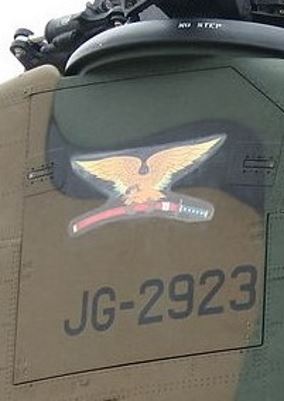 (Photo [Sept. 2007]: Vantey via Wikimedia Commons)
(Photo [Sept. 2007]: Vantey via Wikimedia Commons)
A new unit marking (above) first appeared on tail rotor masts in August 2002. The design comprised a yellow eagle (ostensibly in flight but looking as if balancing) on a red katana (Japanese sword) with a white hilt. Extreme variations are used from time to time, such as this (link) seen at the Soumagahara base event held during the cherry blossom season in April 2008.
 The normally yellow eagle and red sword were white and pink on a
The normally yellow eagle and red sword were white and pink on a
12th Helicopter Unit aircraft at Tachikawa in November 2013.
Also in August 2002, the 2nd Flight adopted the kanji 武飛 (literally meaning “military flight,” the 武 being in a stylized form of red and yellow gradations), which appears low down aft of the cockpit doors.
 The nose markings of a 12th Helicopter Unit, 2nd Flight CH-47JA at Narashino in January 2012.
The nose markings of a 12th Helicopter Unit, 2nd Flight CH-47JA at Narashino in January 2012.
(Photo: Los688 via Wikimedia Commons)
All aircraft carry the unit identifier XII H in black aft of the cockpit windows.
12th Helicopter Unit, 1st Flight Markings/UH-60JA
 (Photo: JGSDF/12th Brigade)
(Photo: JGSDF/12th Brigade)
A 12th Helicopter Unit, 1st Flight UH-60JA pilot’s helmet (above) bears the imposing hiryū (flying dragon) squadron badge. At times, the badge appears on the aircraft, such as this low-visibility version in 2005 (link), on blue-green badges on aircraft displayed at the Yokota AB Friendship Day events in August 2007 (link) and August 2008 (link), with the hiryū on a red background with a yellow diagonal stripe at Tachikawa in 2011 (link) and even in pink (date unknown). Part of the design was also in sticker form for publicity at Yokota in 2012 (link).
One Japanese source included a drawing of a binocular-wielding hornet (?) cartoon design for the 12th Helicopter Unit’s HQ Flt (UH-1J, Soumagahara) with 12th HELICOPTER and HQ-U on its body stripes.
12TH HELICOPTER UNIT SPECIAL MARKINGS
Every spring, the 12th Brigade has been in the habit of specially painting at least one of the 12th Helicopter Unit’s aircraft in a special scheme. The markings commemorate the brigade’s formation in 2001 and the establishment of a garrison at what was originally the tank base of Soumagahara in 1959. Following what were simple banners in the early years, cues have been taken from Japanese culture and the season of the year to “blossom” into more elaborate designs.
2004 (3rd/47th anniversaries) CH-47JA 52966
 (Photo: BANCHOH via Twitter @BANF30)
(Photo: BANCHOH via Twitter @BANF30)
April 2005 (4th/46th anniversaries) CH-47JA 52966 / OH-6D 31313
The CH-47JA (link) sported a simple banner on each sponson and, as used in subsequent years, a slogan along the length of its upper fuselage access panel. The OH-6D (link), which was the last to have been delivered to the JGSDF, had the unit badge on its rotor mast and the wording 4thANNIVERSARY and 本部付隊 (literally unit attached to HQ) on the cabin door.
April 2007 (6th/48th) CH-47JA 52967 / OH-6D 31313
 Some idea of one 2007 design can be gained from these images. They were taken from an ad for a
Some idea of one 2007 design can be gained from these images. They were taken from an ad for a
Tomytec plastic model that could be finished in the markings of either the 2007 or the 2009 aircraft.
In addition to 6TH ANNIVERSARY along the upper fuselage access panel of the CH-47JA (link), artwork on the right sponson depicted 雷神 (raijin, the god of thunder seen in the photo above), that on the left 風神 (fūshin, the god of wind). Somewhat better images of these markings can be found in this event report (link).
2009 (8th/50th) CH-47JA 52957
 Despite 2009 having been the base’s 50th anniversary, the thus far only usable image is again that
Despite 2009 having been the base’s 50th anniversary, the thus far only usable image is again that
from a plastic model sales site that included the Tomytec box lid.
The inspiration for the design was that year’s long-running NHK TV historical drama called Tenchijin (Heaven, Earth and Man). The drama’s central character was Kanetsugu Naoe (1559–1620), a warlord who served the Uesugi samurai clan family during what is known as the Warring States period of Japanese history. He was selected as the 12th Brigade’s area of responsibility mainly covers the lands once owned by the Uesugi clan. The design on the left sponson featured an inscription as well as a helmet inscribed with the kanji 愛 (ai, love) and the Naoe family crest to the right of Naoe. On the right side was a silhouette map of Gunma Prefecture and cherry blossoms.
The tail emblem of the 2nd Flight, the 12th Brigade’s golden eagle clutching a Japanese sword, was also decorated with cherry blossoms.
2010 (9th/51st) CH-47JA 52966 (link) / OH-6D 31279 (link)
Using the by now standard practice, the Chinook’s upper fuselage access panel once again served as a billboard, on this occasion for the ‘9th Anniversary’.
On its left sponson (link) the Chinook featured a banner bearing the inscription ‘12th Brigade 9th Anniversary’, the brigade badge superimposed on a map on of Japan and some flames; the design on the bottom right of the banner is unclear. The banner on the right side (link) had a simple design of more flames and, as Gunma Prefecture is the leading producer of Daruma dolls, an image (with cherry blossom) of Darumataishi, the Japanese name for the Buddhist monk Bodhitharma, who lived in around the 5th century and on whom the doll talisman is based. The Japanese running along the top of the banner proudly proclaimed the 51st anniversary of Camp Soumagahara.
The right-side cockpit window (link) bore the names of the flight crew, and the coloured panel aft of the cockpit window the name of the maintenance crew chief assigned to the aircraft.
The OH-6D bore the 12th Brigade’s golden eagle marking on its rotor mast, as was the unit fashion back then, but its tail (link) had received some one-time-only artistic attention. To appeal to local residents in particular, this took the form of cherry blossoms falling like rain on one of the popular Daruma doll talismans. Note that the tail also sported two 12th Brigade eagle emblems in pink.
2014 (13th/55th) CH-47JA 52961
This aircraft (link) sported a sharkmouth design (see YouTube Videos Featuring 12th Helicopter Unit below)
2015 (14th/56th) CH-47J 52918
 2015 saw another flurry of cherry blossom petals and a bird’s head.
2015 saw another flurry of cherry blossom petals and a bird’s head.
(Photo: Nobu-san via Twitter @MUyio6PFws4ywx2)
2016 (15th/57th) CH-47JA 52975
 (Photo: via Twitter @gabu93)
(Photo: via Twitter @gabu93)
2017 (16th/58th) CH-47JA 52956 (link) / OH-6D 31288
 (Photo: akihiro via Twitter @dragon192)
(Photo: akihiro via Twitter @dragon192)
 (Photo: akihiro via Twitter @dragon192)
(Photo: akihiro via Twitter @dragon192)
 (Photo: Tiger Tiger via Twitter @Tiger_Tiger_TT)
(Photo: Tiger Tiger via Twitter @Tiger_Tiger_TT)
2018 (17th/59th) CH-47J 52930
 (Photo: via Twitter @miriimai)
(Photo: via Twitter @miriimai)
2019 (18th/60th) CH-47J 52918
 (Photo: BANCHOH via Twitter @BANF30)
(Photo: BANCHOH via Twitter @BANF30)
The public event originally planned for April 11, 2020, at which the aircraft prepared for the 19th/61st anniversaries would have been displayed, was cancelled exactly one month before to prevent the spread of coronavirus infections.
 All JGSDF helicopter units give a small number of aircraft snow camouflage if and when engaged
All JGSDF helicopter units give a small number of aircraft snow camouflage if and when engaged
on winter training exercises. Although not special markings as such, J-HangarSpace likes to
assist in bringing great images chanced upon on Japanese Twitter, like this 12th Helicopter
Unit CH-47J, to a wider audience. (Photo [March 2017]: akihiro via Twitter @dragon192)
YouTube Videos Featuring 12th Helicopter Unit
The towing of a “sharkmouth” Chinook from a hangar (link) on the 12th Brigade’s 13th anniversary in April 2014.
The local Gunma Prefecture newspaper, the Jomo Shimbun, recorded the first training flights of the year in January 2016 (link) and 2017 (link). For the former, a total of nine helicopters climbed to an altitude of about 1,000 metres, routed over the cities of Shibukawa, the prefectural capital Maebashi and Takasaki before returning to base around 45 minutes later.
 (Photo: Japan Ministry of Defense/JGSDF)
(Photo: Japan Ministry of Defense/JGSDF)
|
13th AvSqn |
Formed | January 1962 (Yao) |
| Current Base | Hofu |
The 13th AvSqn moved to Hofu in November 1962, the same year in which the unit was formed at Yao.

(Above) A 13th AvSqn L-19A kicks up dust after touching down at Hofu in September 1977. Seen being pushed into its hangar (below), this particular example had been the first aircraft of the type received by the National Security Force in the 1950s. (Photos: Takao Kadokami)

 Against a backdrop provided by the expanse of Hofu airfield, camouflaged 13th AvSqn OH-6D 31127
Against a backdrop provided by the expanse of Hofu airfield, camouflaged 13th AvSqn OH-6D 31127
sits on the tarmac in the summer heat of August 1985. (Photo: Takao Kadokami)
Regional aviation group command was supplanted by direct ground (currently brigade-level) command in March 1994.
The 13th Aviation Squadron thus provides logistic support throughout the 13th Brigade’s area of operations. As shown on a page on the Brigade’s website (link), these cover the five most westerly prefectures on Honshu, from Tottori to Yamaguchi.
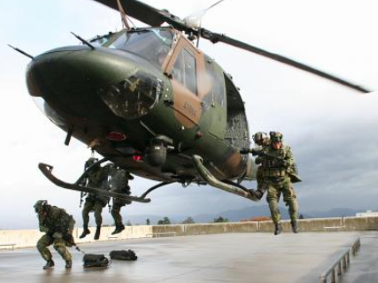 (Photo: JGSDF/13th Brigade)
(Photo: JGSDF/13th Brigade)
In March 2020, the website seemed to have undergone some changes. However, the latest information on the list of the unit’s disaster relief deployments (link [see below]), which dated from the formation of the Brigade in 1999, remained that for the Kumamoto Earthquake of April 2016, the magnitude of which prompted a response from outside Kyushu. A history page on the website that had offered a glimpse back more than 40 years, to river rescue training held in Wakayama and Hiroshima prefectures in 1978, seemed to have been removed.
Snapshots of 13th AvSqn Operations
1999
(May) Mountain forest firefighting in Hiroshima and Shimane prefectures
(June) Flood disaster relief, Kure, Hiroshima Prefecture
(June–July) Flood disaster relief, Saeki Ward, Hiroshima
2000
(Aug.–Sept.) Mountain forest firefighting, Toyota district, Hiroshima Prefecture
(Oct.) Tottori Earthquake, disaster relief operations in west of prefecture
(Dec.) Emergency airlift of patient from Yao, Osaka Prefecture, to Nerima, Tokyo
2001
(Mar.) Landslide disaster relief, Soja, Okayama Prefecture
Geiyo Earthquake disaster relief operations, Kure, Hiroshima Prefecture
 (Photo: JGSDF/13th Brigade)
(Photo: JGSDF/13th Brigade)
2002
Mountain forest firefighting:
(Mar.) Towa, Yamaguchi Prefecture; (Apr.) Soja, Okayama Prefecture;
(June) Yamaguchi Prefecture
2003
(Jan.) Relief water supplies, Shoboku, Okayama Prefecture
2004
(Feb.) Mountain forest firefighting, islands of Innoshima and Setoda (now part of
Onomichi), Hiroshima Prefecture
 (Photo: JGSDF/13th Brigade)
(Photo: JGSDF/13th Brigade)
2005
Mountain forest firefighting:
(Apr.) Tamano, Okayama Prefecture; (May) Ochi District, Ehime Prefecture;
(June) Tokuji, Saba District (now part of Yamaguchi City), Yamaguchi Prefecture
Typhoon disaster relief: (Sept.) Iwakuni, Yamaguchi Prefecture
2006
Mountain forest firefighting:
(Jan.) Fukuyama, Hiroshima Prefecture, and Shuto (now part of Iwakuni),
Yamaguchi Prefecture
Relief water supplies: (Aug.) Kure and Etajima, Hiroshima Prefecture
2007
Mountain forest firefighting:
(Apr.) Masuda, Shimane Prefecture; (May) Yasugi, Shimane Prefecture;
(Sept.) Yanai, Yamaguchi Prefecture
 (Photo: れんし[Renshi] via Twitter @Kirara21YA)
(Photo: れんし[Renshi] via Twitter @Kirara21YA)
2008
(Feb.) SAR mission, Osorokan Snow Park, Akiota, Hiroshima Prefecture
(May) SAR mission, Mt. Mitoku, Misasa, Tottori Prefecture
2009
(July) Flood disaster relief, cities of Yamaguchi and Hofu, Yamaguchi Prefecture
2010
(July) Flood disaster relief, Sanyo-Onoda, Yamaguchi Prefecture, and
Shobara, Hiroshima Prefecture
(Sept.) Mountain forest firefighting, Iwakuni, Yamaguchi Prefecture and
Hamada, Shimane Prefecture
2011
(Mar.) Great East Japan Earthquake
(Aug.) Mountain forest firefighting, Tamano, Okayama Prefecture
 A 13th AvSqn OH-6D during a reconnaissance flight over an area affected by the
A 13th AvSqn OH-6D during a reconnaissance flight over an area affected by the
Great East Japan Earthquake. (Photo: JGSDF/13th Brigade)
2012
(May) SAR mission, Daisen, Tottori Prefecture
(Oct.) Mountain forest firefighting, Mihara, Hiroshima Prefecture
 (Photo: JGSDF/13th Brigade)
(Photo: JGSDF/13th Brigade)
2013
(July) Flood disaster relief, Yamaguchi City, Yamaguchi Prefecture
2016
(Apr.) Kumamoto Earthquake
 (Photo [February 2016]: JGSDF/13th Brigade)
(Photo [February 2016]: JGSDF/13th Brigade)
 Early in October 2019, the 13th AvSqn organized an air experience flight for local residents from
Early in October 2019, the 13th AvSqn organized an air experience flight for local residents from
Kaitaichi Army Camp in Hiroshima Prefecture. The 15-minute flight gave the lucky lottery
winners contrasting bird’s-eye views of the areas damaged by the torrential rains in the
summer of 2018 and of the UNESCO World Heritage site at Miyajima.
(Photo: JGSDF/13th Brigade)
 The 13th having accepted delivery of its first OH-6D in March 1980, the type remained in service
The 13th having accepted delivery of its first OH-6D in March 1980, the type remained in service
for 40 years. Shown above, the last example operated was retired at the ceremony pictured below,
which was held at JASDF Hofu-Kita AB on March 19, 2020.  (Photos: JGSDF/13th Brigade)
(Photos: JGSDF/13th Brigade)
 (Above and below) The port-side cabin windows of the two Hofu-based UH-1Js that participated
(Above and below) The port-side cabin windows of the two Hofu-based UH-1Js that participated
in the JASDF Hofu-Kita AB air show in June 2022 carried a combined message:
13th AvSqn – In Partnership with the Local Community.
 (Photos: [Top] AKI via Twitter @shizuka_aki03;
(Photos: [Top] AKI via Twitter @shizuka_aki03;
[above] xash@THEファイター via Twitter @aggressor072)
13TH AVIATION SQUADRON MARKINGS
Bearing the inscription 13th Aviation and the name of its crew chief (C/C Yoshihiko Iwomoto), this 13th AvSqn was a visitor to the Swell Festival event at JMSDF Ozuki in October 2014 (link).
June 2, 2019 / Last local public appearance of 13th AvSqn OH-6D, JASDF Hofu-Kita AB
 (Photo: れんし[Renshi] via Twitter @Kirara21YA)
(Photo: れんし[Renshi] via Twitter @Kirara21YA)
The right side of the helicopter featured the addition of licence-builder Kawasaki Heavy Industries’ logo on the tail boom aft of the serial and, ornately written in white, the crew chief’s name underneath 13th Aviation. A cabin window inscription said 地域と共に (Together with the local community) and 第13飛行隊 (13th Squadron). The small white cross on the tail endplate is actually 十 (the number 10), which together with the three on the other side (see below) makes ‘13’.
 (Photo: れんし[Renshi] via Twitter @Kirara21YA)
(Photo: れんし[Renshi] via Twitter @Kirara21YA)
(Above and below) The left side was comparatively devoid of additional markings. The tail endplate sported 参 (san), which can mean the number three (in this case of ‘13’) and ‘participate’. Taken from the 13th Brigade’s badge, the three arrows on the rotor mast are a reference to the parable of the three arrows (being stronger than one) of Motonari Mōri (1497–1571), the feudal lord who unified what is now Japan’s Chugoku region. Written in white over the arrows, 百万一心 (hyakuman isshin, ‘one million, one heart’) conveys the notion of the unity of purpose of all those who serve or have served with the 13th Brigade. At a time when the making of a human sacrifice would have been the norm, Mori is said to instead have had the slogan carved into a stone of Koriyama Castle, in what is today Nara Prefecture, during its construction.
 (Photo: れんし[Renshi] via Twitter @Kirara21YA)
(Photo: れんし[Renshi] via Twitter @Kirara21YA)
 The inscriptions seen in this head-on shot speak for themselves. With the exception of the unit and
The inscriptions seen in this head-on shot speak for themselves. With the exception of the unit and
crew chief name, all these markings had been removed by the time this aircraft was
displayed at Ozuki in October 2019.
(Photo: れんし[Renshi] via Twitter @Kirara21YA)
|
14th AvSqn |
Formed | March 26, 2010 (Kita-Tokushima) |
| Current Base | Kita-Tokushima |
 All aircraft and personnel were present and correct for a photograph marking the
All aircraft and personnel were present and correct for a photograph marking the
young 14th AvSqn’s second anniversary in 2012. (Photo: JGSDF/14th Brigade)
Its formation stemming from that of the 14th Brigade under the 2nd Composite Brigade, the 14th AvSqn is the first JGSDF aviation unit to be permanently based on Shikoku; previously, the island had been provided with Central Army Aviation Group aircraft from Yao, Osaka Prefecture. It was there that a preparatory unit was formed within Central Army Aviation Group in March 2009.
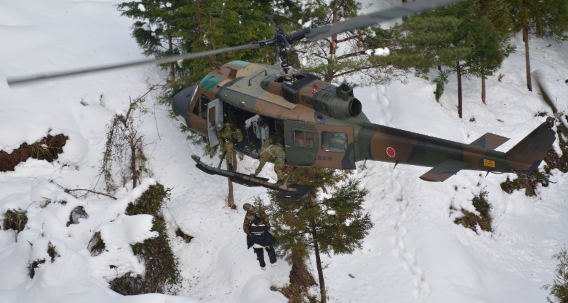 The unit was involved in relief operations during the period of heavy snowfall Shikoku
The unit was involved in relief operations during the period of heavy snowfall Shikoku
suffered in December 2014. (Photo: JGSDF/14th Brigade)
The unit’s first major disaster response operation came on August 30, 2010, five months after its formation. The 14th AvSqn was called upon to assist in evacuating residents and bringing under control a forest fire on Shodo Island on the Inland Sea.
The 14th AvSqn would be a contender for any future J-HangarSpace Best JGSDF Website award. Unlike most of its longer established sister units, the 14th AvSqn (or rather its parent 14th Brigade) makes full use of its website to provide news and show snapshots of life at the unit.
Its homepage (link) serving merely as a contents page, aviation content is primarily to be found on the Gallery page (link), which divides the current fiscal year (from April to March) by month. Images from previous years, which date back to those taken at the unit’s formation ceremony (link), are kept here (link).
Snapshots of 14th AvSqn Operations
January 9–10, 2013 / Forest Firefighting, Takamatsu, Kagawa Prefecture
 14th AvSqn UH-1Js in action during the January 2013 firefighting operation. The capacity of the
14th AvSqn UH-1Js in action during the January 2013 firefighting operation. The capacity of the
buckets carried by UH-1Js is half a tonne, compared with six tonnes by the CH-47J/JAs.
 (Photos: Japan Ministry of Defense/JGSDF)
(Photos: Japan Ministry of Defense/JGSDF)
Supporting a 14th Brigade ground deployment of 55 personnel and eight vehicles, the 14th AvSqn provided some of the reported 10 aircraft that dealt with a fire that broke out in the Kokubunji district of Takamatsu. The operation was initiated at lunchtime on January 9 and successfully completed around 24 hours later.
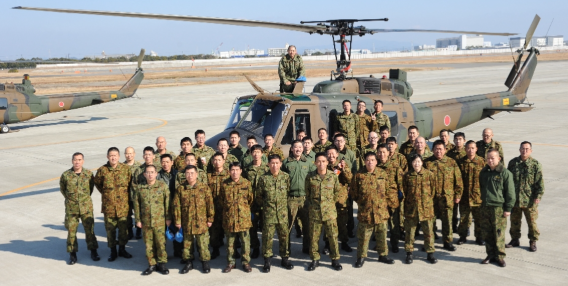 The year at aviation-related SDF bases traditionally begins with the first flight in early January,
The year at aviation-related SDF bases traditionally begins with the first flight in early January,
where speeches express wishes for ongoing safe operations. This group photo was taken
after the 2013 ceremony. (Photo: JGSDF/14th Brigade)
 In November 2014, a ceremony was held for a captain who had reached the 3,000 accident-free
In November 2014, a ceremony was held for a captain who had reached the 3,000 accident-free
flying hours milestone while assigned to the unit. (Photo: JGSDF/14th Brigade)

Unit members come and go, as do their aircraft.
(Above) A ceremony marking a pilot’s last final flight (in this case of a Captain Kono) followed the
time-honoured tradition in April 2014.
(Below) The OH-6D 254 was given a good send-off on February 12, 2015. The banner
included messages for a job well done from its pilot and/or crew chief.
(Photos: JGSDF/14th Brigade)

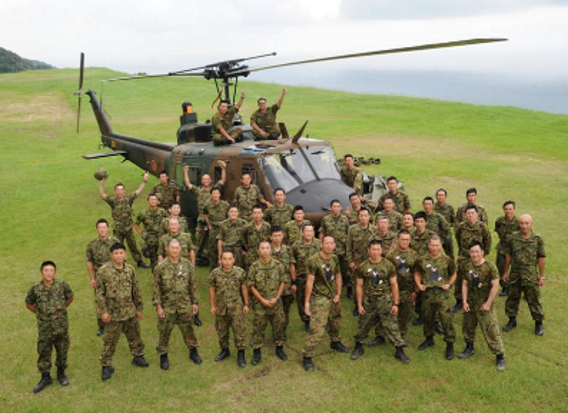
Training exercises make up a high proportion of the unit’s operations.
(Above) Another photo opportunity followed the end of door gun firing training in July 2013, which
involved the use of targets placed in the sea off Cape Sata, the southernmost point of mainland Japan.
(Below) A 14th AvSqn UH-1J sits on the rain-swept deck of the JMSDF helicopter carrier Hyuga
(DDH-181) during a joint U.S.-Japan exercise held in February 2014.
(Photos: JGSDF/14th Brigade)
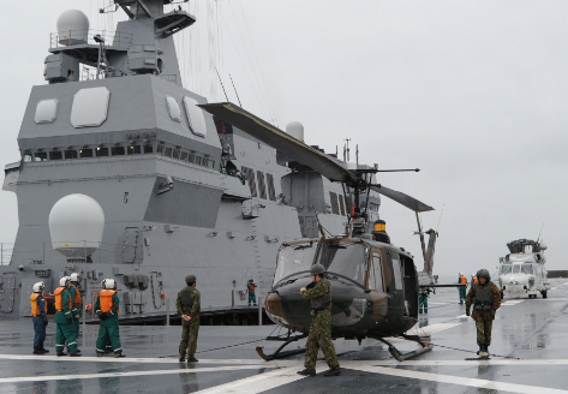
 April 2017 (Photo: JGSDF/14th Brigade)
April 2017 (Photo: JGSDF/14th Brigade)
(From website page [link], accessed Oct. 18, 2017)
 A 14th AvSqn UH-1J crew provides a demonstration flight at an event held at neighbouring
A 14th AvSqn UH-1J crew provides a demonstration flight at an event held at neighbouring
JMSDF Tokushima in September 2017. (Photo: Hunini via Wikimedia Commons)
A report on the forest firefighting operations near Kitagawamura, Kochi Prefecture, from June 7–11, 2019, can be found in the Snapshots of Central Army Helicopter Squadron Operations later on this page.
 A 14th AvSqn UH-1J departs Zentsuji Army Camp at the start of a 15-minute air experience
A 14th AvSqn UH-1J departs Zentsuji Army Camp at the start of a 15-minute air experience
flight, which took in local landmarks, for some lucky lottery-winning local residents.
(Photo [Nov. 2020]: Kagawa SDF Provincial Cooperation Office via Twitter @KagawaPco)
|
15th AvSqn |
Formed | March 26, 2010 (Naha) |
| Disbanded | March 25, 2013 (Naha) |
Formed from the disbanded 101st AvSqn (see below) on March 26, 2010, and trading in its last LR-1 (22019) for an LR-2 two months later, the 15th AvSqn was in existence for only three years, disbanding on March 25, 2013.
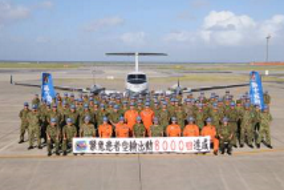 During the course of its brief existence, the 15th AvSqn passed the milestone of the 8,000th
During the course of its brief existence, the 15th AvSqn passed the milestone of the 8,000th
medevac mission undertaken from Naha on Aug. 10, 2011. (Photo: JGSDF/15th Brigade)
Within that time, the 15th AvSqn had increased the cumulative total of medical evacuation missions by 555 to 8,313 and the number of people airlifted in the course of those missions by 560 to 8,673.
|
15th Helicopter Unit |
Formed | March 26, 2013 (Naha) |
| Current Base | Naha |
 (Photo: JGSDF/15th Brigade)
(Photo: JGSDF/15th Brigade)
Following the ceremonial handing over of a unit flag from the 15th Brigade, to which it reports, the 15th Helicopter Unit officially came into existence on March 26, 2013 (above).
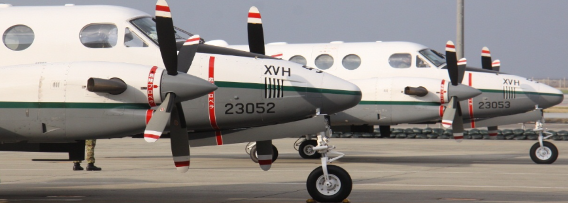 (Photo: JGSDF/15th Brigade)
(Photo: JGSDF/15th Brigade)
The 15th is organized into an HQ Flight with two LR-2s (above) and the 1st Sqn (UH-60JA) and 2nd Sqn (CH-47JA).
The unit’s homepage (link) has four subpages. These provide an introduction to its roles/organization and aircraft as well as an overview of its medical evacuation (medevac) operations and a chronology that dates back to the beginnings of the 101st AvSqn in 1972 (see below).
The unit’s medevac area of responsibility covers all of Okinawa and Kagoshima Prefecture’s Amami archipelago, a distance of roughly 1,000 km east to west and 500 km north to south. As noted in the predecessor 101st AvSqn’s entry, two accidents in the course of these operations have sadly cost the lives of seven JGSDF service personnel and an accompanying doctor.
 (Photo: JGSDF/15th Brigade)
(Photo: JGSDF/15th Brigade)
Maintained on the parent 15th Brigade homepage (link), a running total of the unit’s medical evacuation missions and the number of people airlifted in the course of those missions stood at 9,658 and 10,020, respectively, as at April 20, 2020. The 10,000 mark for the latter had been achieved on the 9,639th mission on March 13, 2020, when a baby was airlifted by LR-2 from Miyakojima to Naha. The medical evacuation mission counter reached 10,000 on April 6, 2022. As at October 23, 2024, the figures had increased to 10,540 missions and 10,917 people.
 (Above and below) Following a flight from Naha to Miyako Island, the 15th HU achieved the
(Above and below) Following a flight from Naha to Miyako Island, the 15th HU achieved the
milestone of the JGSDF’s 9,000th medical evacuation mission in Okinawa on October 4, 2016.
 (Photos: JGSDF/15th Brigade)
(Photos: JGSDF/15th Brigade)
 A sign (dated March 23, 2023) at the Naha garrison’s main gate gives (left) the running tally of
A sign (dated March 23, 2023) at the Naha garrison’s main gate gives (left) the running tally of
the 15th’s medical evacuation missions (10,173) and the number of people (10,539) airlifted
next to the figures that record the number (39,404) and weight of unexploded shells
from the war that the 15th Brigade has rendered harmless.
(Photo: ボギーてどこんvia Twitter @fm21wannuumui)
15TH HELICOPTER UNIT MARKINGS
Incorporating the Roman numeral for ‘15’, the 15th Helicopter Unit’s aircraft bear the alphanumeric code XVH.
The unit has retained the tail marking of its predecessor, the 15th AvSqn. In white, the marking combines a map of the main island of Okinawa with a crested serpent eagle that inhabits islands in Japan’s westernmost extremities.

The background of the full version of the unit marking (above) incorporates in yellow the family crest of the Ryukyu dynasty, to convey Okinawa’s origins as a separate empire, and the blue of the sea. Depicted in red is a local Naha landmark, the Shurei (Follow Courtesy) Gate, which also features on a 15th Brigade service medal.
In January 2017, one of the LR-2s was sporting a bird over Okinawa tail marking design (link).
|
101st AvSqn |
Formed | (Provisional 101st AvSqn) Mar, 1, 1972 (Kengun Army Camp, Kumamoto) Nov. 21, 1972 (Naha) |
| Disbanded | Mar. 26, 2010 (Naha, reformed as 15th AvSqn) |
A continuous thread running through the JGSDF presence on Okinawa has been its role in medical evacuation across the scattered islands of the island chain; the 101st recorded its first mission (to Aguni Island) on December 6, 1972, only five days after assuming responsibility for the role on December 1, 1972. The 1,000th mission milestone was achieved on July 27, 1979, the 2,000th on November 28, 1984, and the 3,000th on October 7, 1989.
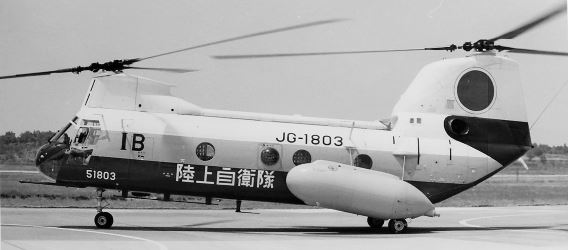 A 101st AvSqn KV-107-IIA-4 visits the JGSDF base at Takayubaru, Kumamoto Prefecture,
A 101st AvSqn KV-107-IIA-4 visits the JGSDF base at Takayubaru, Kumamoto Prefecture,
in May 1979. (Photo: Takao Kadokami)
A low point in the unit’s history came on the 3,080th mission on February 17, 1990, when an LR-1 crew was tragically killed when their aircraft crashed into the sea off Miyako Island at night in poor weather conditions when arriving to collect a patient.
 A cluster of six photos shows (clockwise from top right): the 101st’s initial brightly painted aircraft
A cluster of six photos shows (clockwise from top right): the 101st’s initial brightly painted aircraft
fleet; a UH-1B on a medevac training exercise; a formation of three different aircraft types; a
camouflaged CH-47J assigned to the unit; a pair of KV-107s; and the former hangar that
was replaced in March 2005. (Photos: JGSDF/15th Brigade)
JGSDF Naha Hangar Visit, May 1990
In May 1990, now 30 years ago and roughly the halfway point in the 101st Aviation Squadron’s history, the JGSDF personnel in Okinawa would still have been coming to terms with the loss of the LR-1 three months before. Nevertheless, photographer Takao Kadokami was granted access to the unit’s hangar to record its residents for posterity. All were sporting the unit’s signature olive drab, dark yellow and white with dayglow orange areas “tropical” colour scheme. In the case of the KV-107IIs this was often retained on aircraft when they were transferred back to mainland Japan-based units, as will be seen later.
The standard-camouflaged 22015 (not shown) was also present undergoing maintenance at the time of this Naha visit. After ending its service career days with the 1st Helicopter Brigade, 22010 aircraft ended up in storage at Kasumigaura by May 2009 and was last heard of at the Shizuoka Institute of Science and Technology in Fukuroi, Shizuoka Prefecture, in March 2016.
All three of the KV-107IIA-4 helicopters present that day remain in existence. The first of the 18 examples of this variant the JGSDF acquired between 1972 and 1981, 51801 now resides at JGSDF Nihonbara in Okayama Prefecture.
One of those that later had weather radar fitted for overwater missions, 51804 remains on outdoor display at the Gifu-Kakamigahara Air and Space Museum. (The page of this website dedicated to the museum includes the aircraft’s history.)
This aircraft (above) is now at JGSDF Shinmachi in Takasaki, Gunma Prefecture. Although not seen very clearly in black and white, the UH-1H (below) does appear to have the same three-tone colour scheme as that seen in the collection of six colour photos included above.
Re-equipment of the 101st in the form of the CH-47J—actually 52901, the first example the JGSDF had received in 1986—and UH-60JA (43107) came on February 7, 1996, and October 6, 1999, respectively. The first LR-2 (23053) arrived on December 15, 2000. The last example of the KV-107 (51818), a type long associated with the 101st, left Okinawa on March 17, 1998; the veteran UH-1H (41684, pictured above) followed suit on November 26, 2002.
An LR-1 flight to Yoronjima in Kagoshima Prefecture on August 14, 1998, marked the accomplishment of the 5,000th medical evacuation mission. In July 2000, the 101st was naturally involved in supporting the G8 Kyushu-Okinawa Summit.
During the approach phase on another medical evacuation operation, tragedy struck once again on the night of March 30, 2007, when the unit’s CH-47JA crashed on Mt. Amagi on Tokunoshima in Kagoshima Prefecture in poor weather conditions. Many local dignitaries paid their respects at the funeral service held for the four men who had lost their lives on April 15.
The curtain came down on the 101st’s long-standing presence in Okinawa on March 25, 2010, when the 1st Composite Brigade disbanded. The 15th AvSqn assumed the mantle the following day. At the end of its tenure, the 101st’s cumulative totals of medical evacuation missions and the number of people airlifted in the course of those missions had reached 7,758 and 8,113, respectively.
The Kisarazu-based 1st Transport Helicopter Group hosted an event to mark the end of an era on February 15, 2016, when the last LR-1 (22019) made its final flight. Up until May 20, 2008, the same aircraft had been the last of its type to be based with the 101st Aviation Squadron on Okinawa. Such was the aircraft’s close association, another aircraft was painted to masquerade as 22019 and be put on display.
|
102nd Sqn |
Formed | March 28, 2008 (Kisarazu) |
| Current Base | Kisarazu |
Reporting directly to the 1st Helicopter Brigade rather than the 1st Transport Helicopter Group, the 102nd AvSqn newly formed in March 2008. The unit is charged with maintaining close cooperation with ground forces and would, if called upon, assume combat support roles, such as air mobility and reconnaissance.
 Kisarazu, October 2012. Ground crew members make preparations prior to pushing a recently
Kisarazu, October 2012. Ground crew members make preparations prior to pushing a recently
returned 102nd Sqn OH-6D away from its landing point.
 March 6, 2020, saw the end of an era in 102nd Sqn history with the final departure, witnessed by
March 6, 2020, saw the end of an era in 102nd Sqn history with the final departure, witnessed by
personnel from the parent 1st Helicopter Brigade, of the unit’s last OH-6D. Exactly 43 years had
passed since the arrival of the brigade’s first example in March 1977. Fittingly, a long-serving
102nd Sqn pilot was given the honour of being at the controls one last time to deliver the
aircraft from Kisarazu to Kasumigaura. (Photo: 1st Helicopter Brigade via Twitter)
102ND SQUADRON MARKINGS
Otherwise devoid of markings, aircraft assigned to the 102nd Sqn carry the 1st Helicopter Brigade’s identifier, IHB.
 Normally painted in the standard camouflage scheme with no colourful distinguishing marks, an
Normally painted in the standard camouflage scheme with no colourful distinguishing marks, an
exception was made for a 102nd Sqn UH-60JA at Kisarazu’s 40th anniversary show in October 2012.
 At the moment of takeoff, a 102nd Sqn UH-60JA stands on tippy-toe prior to participating
At the moment of takeoff, a 102nd Sqn UH-60JA stands on tippy-toe prior to participating
in the opening ceremony flypast at the Kisarazu airshow in February 2017.
(Photo: AKIHIRO via Twitter @dragon192)
|
103rd Sqn |
Formed | Mar. 28, 2008 (1st Transport Helicopter Group, Kisarazu) |
| Current Base | Kisarazu |
Previously the 1st Helicopter Brigade’s 1st Flight, what has been the 103rd Squadron since March 2008 has retained the name Katori Flight first adopted in 1999.
 Tucked away inside a hangar at Kisarazu in September 2017 was this 103rd Sqn CH-47JA.
Tucked away inside a hangar at Kisarazu in September 2017 was this 103rd Sqn CH-47JA.
 Even on a sunny day like this, at JMSDF Tateyama in October 2013, this 103rd Sqn aircraft’s
Even on a sunny day like this, at JMSDF Tateyama in October 2013, this 103rd Sqn aircraft’s
marking (below) is barely discernible against the inconveniently placed patch of black camouflage.

 This 103rd Sqn CH-47J was one of four SDF aircraft drafted in to assist in forest firefighting
This 103rd Sqn CH-47J was one of four SDF aircraft drafted in to assist in forest firefighting
operations near Omu, Hokkaido Prefecture, in May 2019.
More details can be found in the 2nd AvSqn squadron history. (Photo: JGSDF/2nd Division)
103RD SQUADRON MARKINGS
The unit’s aircraft bear a low-visibility black, smaller version of the predecessor 1st Helicopter Brigade, 1st Flight’s “1” wrapped in a black lightning flash on the rear rotor mast. No longer sporting single unit identification stripes, HGPIII appears in black aft of the cockpit windows.
Both taken at Kisarazu in early June 2010, the last two photos here (link) show the tail markings from two 103rd Sqn aircraft.
From the top, the first three photos show the predecessor 1st Helicopter Group’s 1st Flight markings: the former black and white as well as colour versions from September 1993 and October 1998, respectively, and the final marking photographed in October 2003.
 Three CH-47JA Chinooks, the nearest from the 103rd Sqn, take off during the Kisarazu
Three CH-47JA Chinooks, the nearest from the 103rd Sqn, take off during the Kisarazu
airshow in December 2019. (Photo: kawa via Twitter @NonbiriYaroze)
|
104th Sqn |
Formed | Mar. 28, 2008 (1st Transport Helicopter Group, Kisarazu) |
| Current base | Kisarazu |
Previously the 1st Helicopter Group’s 2nd Flight, what has been the 104th Squadron since March 2008 has retained the Owl Squadron Azuma name first adopted in November 2002.
 A 104th Sqn CH-47J seen taxying at Kisarazu in mid-October 2012.
A 104th Sqn CH-47J seen taxying at Kisarazu in mid-October 2012.
 Two photos showing a 104th Sqn CH-47JA being (above) made secure on and (below) departing
Two photos showing a 104th Sqn CH-47JA being (above) made secure on and (below) departing
from the deck of the amphibious dock landing ship USS Germantown (LSD 42) in Buckner Bay,
Okinawa. The occasion was a personnel transfer during Exercise Keen Sword, the bilateral
field training exercise that has been conducted biennially since 1986.
(Photos [Nov. 11, 2014]: U.S. Navy/Mass Communication Specialist 2nd Class Amanda R. Gray)

104TH SQUADRON MARKINGS
The top four Chinook tail markings on this website page (link) date back to when the current 104th “Owl” Sqn was the 1st Helicopter Group’s 2nd Flight. All taken at Kisarazu, the photos show, from the top: the 1st Helicopter Group, 2nd Flight’s former marking, October 1998; the final marking (with red background), February 2006; the final marking (with blue background), February 2006; and the final marking (again with blue background), October 2003.

Dropping its predecessor’s shield marking, the unit went back to the original idea of an owl alone, which was made more elaborate and embellished with a white-outlined black/red 104AVN above AZUMA. No longer sporting the twin unit identification stripes, HGPIV appears in black aft of the cockpit windows.
 (Photo [Kisarazu airshow, Feb. 2017]: わたる (Wataru) via Twitter @harawata5050)
(Photo [Kisarazu airshow, Feb. 2017]: わたる (Wataru) via Twitter @harawata5050)
|
105th Sqn |
Formed | Mar. 28, 2008 (1st Transport Helicopter Group, Kisarazu) |
| Current Base | Kisarazu |
Previously the 2nd Helicopter Brigade’s 1st Flight, what has been the 105th Squadron since March 2008 has retained the Akagi name first adopted in October 1998.
 A 105th Sqn pilot holds CH-47J 52915 at the hover at Kasumigaura in May 2014.
A 105th Sqn pilot holds CH-47J 52915 at the hover at Kasumigaura in May 2014.
In 2014, 105th Sqn Capt. Masahiro Sakai wrote a short piece on the subject of aerial firefighting operations for the JGSDF website. The basic idea sounds simple: filling an underslung bucket with water from a nearby source, be it a lake, river or reservoir, even from the sea, and dropping the load at the scene of the fire. In reality, forest fires are not that easy to extinguish and, as will be noticed from the snapshots of operations included on these squadron history pages, tend to break out in Japan’s mountainous regions. Even after bombarding them with water from sunrise to sunset, on the ground and from the air, in the worst cases they can take days to bring under control.
Added to operating a Chinook with a six-tonne weight dangling beneath the aircraft in the turbulence of mountain passes, pilots and crew members have to concentrate for extended periods of time in a potentially dangerous environment. Major firefighting operations involve an orchestrated aerial ballet—in effect an aerial bucket brigade, but one in which they keep hold of their buckets—of helicopters from the JASDF, prefectural aviation units as well as the JGSDF, with news agency helicopters occasionally hovering on the periphery. Sakai also mentioned the added hazard of the many high-voltage lines around dams and forest fire sites and the extreme caution that has to be exercised when landing at or taking off from temporary bases where the unwieldy buckets are attached and the aircraft refueled.
105TH SQUADRON MARKINGS

 (Photos taken at Tachikawa, November 2000)
(Photos taken at Tachikawa, November 2000)
The unit retains its predecessor’s marking that features the long-nosed goblin and famed swordsman Tengu, who is currently also gracing the tails of JASDF 304th Squadron F-15J/DJs. Coloured to signify the aircraft’s maintenance crew—as was the practice in the predecessor 2nd Helicopter Group’s 1st Flight (see JGSDF Squadron Histories Part 1 for details from [link])—a maple leaf appears behind Tengu’s red and black face, 105Avn to the right and the unit’s radio call-sign AKAGI in black below. (Tengu statues can be found on Mt. Akagi in Gunma Prefecture.) HGPV appears in black aft of the cockpit windows, the previous single yellow identification stripes having been removed from the nose and the front of the fuselage-side sponsons.
 A 105th Sqn CH-47JA participates in a disaster relief training exercise held by the Ministry of Land,
A 105th Sqn CH-47JA participates in a disaster relief training exercise held by the Ministry of Land,
Infrastructure, Transport and Tourism at one of Tokyo’s main waterfront disaster relief areas at
Higashi-Ogishima and on the banks of the Tama River. (Photo [December 2019]: Ministry of
Land, Infrastructure, Transport and Tourism via Twitter @mlit_kanto_port)
|
106th Sqn |
Formed | Mar. 28, 2008 (1st Transport Helicopter Group, Kisarazu) |
| Current Base | Kisarazu |
Previously the 2nd Helicopter Brigade’s 2nd Flight, what has been the 106th Squadron since March 2008 has retained the Kazusa Flight name and marking first adopted in 1993.
 A 106th Sqn CH-47J carries an underslung armoured car at the New Year paratroop drop exercise
A 106th Sqn CH-47J carries an underslung armoured car at the New Year paratroop drop exercise
held at Narashino, Chiba Prefecture, in January 2009, the year after the squadron’s formation
as part of the 1st Transport Helicopter Group under the 1st Helicopter Brigade.
(Photo: Los688 via Wikimedia Commons)
 The crossed main rotors of this 106th Sqn Kawasaki-built CH-47J Chinook mimic the crossed
The crossed main rotors of this 106th Sqn Kawasaki-built CH-47J Chinook mimic the crossed
arrows incorporated in its tail marking (see below). The unit’s name (and radio call-sign)
Kazusa is the old name for modern-day Chiba Prefecture, where the unit is based.
 Travelin’ light. Members with the JGSDF’s Amphibious Rapid Deployment Brigade (ARDB), which
Travelin’ light. Members with the JGSDF’s Amphibious Rapid Deployment Brigade (ARDB), which
was formed in March 2018, board a 106th Sqn CH-47J on the deck of the dock landing ship
USS Germantown in the Philippine Sea. Elements from the U. S. Marines and other JGSDF
units participated alongside the ARDB during a two-week amphibious training exercise.
(Photo [Feb. 13, 2020]: U.S. Marine Corps/Lance Cpl. Joshua Sechser)
 A welcome party was ready and waiting when 106th Sqn pilot Capt. Takahashi returned from the
A welcome party was ready and waiting when 106th Sqn pilot Capt. Takahashi returned from the
flight in which he clocked up his 1,500th accident-free flying hour.
(Photo [Kisarazu, Sept. 14, 2020]: JGSDF 1st Helicopter Brigade via Twitter @1st_helb)
106TH SQUADRON MARKINGS
 A close-up of the marking on a 106th Sqn CH-47JA at JMSDF Shimofusa, September 2012
A close-up of the marking on a 106th Sqn CH-47JA at JMSDF Shimofusa, September 2012
To fall into line with its sister units, the distinctive marking adopted by the predecessor unit—the head of a native American/American Indian with a black, white, red and yellow feather headdress in front of crossed arrows—was moved from either side of the nose to the tail rotor mast. The warrior still faces forward on both sides of the aircraft above the call-sign Kazusa; to the right is stencilled 106Avn. This website page (link) shows, firstly, a unit marking carried by an aircraft in October 1998, in the days of the predecessor, the 2nd Helicopter Group, 2nd Flight (see JGSDF Squadron Histories Part 1). The other two were on 106th Sqn aircraft photographed in October 2008 and (freshly painted) in December 2019.
HGPVI appears in black aft of the cockpit windows, the previous double yellow identification stripes having been removed from the nose and the front of the fuselage-side sponsons.
106TH SQUADRON SPECIAL MARKING
May 2013 Kazusa Flight 45th Anniversary CH-47JA 52960 (link)
 (Photo: JGSDF Kisarazu)
(Photo: JGSDF Kisarazu)
Not generally overly given to decorating its aircraft for special occasions, the 1st Transport Helicopter Group’s 106th Sqn did take a leaf (or rather several cherry blossoms) from the “12th Helicopter Unit Special Marking Manual” in 2013. One of its Chinooks was decked out in a suitably high-visibility scheme to mark the Kazusa Flight’s 45th anniversary at that year’s Kisarazu open day event. Although only formed in 2008, the 106th can trace its ancestry back to the 1st Helicopter Brigade of 1968.
 (Photo taken at Kisarazu, September 2017)
(Photo taken at Kisarazu, September 2017)
|
107th Sqn |
Formed | Mar. 26, 2020 (1st Helicopter Brigade, Kisarazu) |
| Current Base | Kisarazu |
The 107th forms part of the three-squadron Transport Aviation Group that will ultimately provide airlift support for the JGSDF’s Amphibious Rapid Deployment Brigade (ARDB), which has been in existence since March 2018. Initially formed under the 1st Helicopter Brigade in anticipation of the arrival of the first pair of V-22 Ospreys, the 107th is set to remain at Kisarazu and work up on the V-22 until such time as a move to its more forward-located base at Saga Airport proves possible.
Those first aircraft having been flown from Iwakuni to Kisarazu in July 2020, training flights were initially confined to within the airfield perimeter, and it was November 3 that year when a ceremony was held to mark full-fledged Osprey operations. The next five aircraft to be shared between the units were on their way by ship in late January 2021.
 In August 2020, V-22 flights were still being confined to within the perimeter of Kisarazu airfield.
In August 2020, V-22 flights were still being confined to within the perimeter of Kisarazu airfield.
(Photo: JGSDF 1st Helicopter Brigade via Twitter @1st_helb)
107TH SQUADRON MARKINGS
Following the format adopted by the 109th Sqn (q.v.), it can be expected that the aircraft will carry the identifier ‘T VII’ (short for Transport Aviation Group, 107th Sqn) in black aft of the cockpit.
|
108th Sqn |
Formed | Mar. 26, 2020 (1st Helicopter Brigade, Kisarazu) |
| Current Base | Kisarazu |
(See 107th Sqn)
 (Photo: JGSDF 1st Helicopter Brigade via Twitter @1st_helb)
(Photo: JGSDF 1st Helicopter Brigade via Twitter @1st_helb)
108TH SQUADRON MARKINGS
Following the format adopted by the 109th Sqn (q.v.), it can be expected that the aircraft will carry the identifier ‘T VIII’ (short for Transport Aviation Group, 108th Sqn) in black aft of the cockpit.
|
109th Sqn |
Formed | Mar. 26, 2020 (1st Helicopter Brigade, Kisarazu) |
| Current Base | Takayubaru |
The 109th likewise forms part of the three-squadron Transport Aviation Group that will ultimately provide airlift support for the JGSDF’s Amphibious Rapid Deployment Brigade, which has been in existence since March 2018. Unlike its two sister squadrons, however, the 109th is operational with CH-47J/JA Chinooks from Takayubaru in Kumamoto Prefecture and is thus in a position to train with elements of the ARDB, which is stationed at Ainoura Army Camp in Sasebo, Nagasaki Prefecture.
 JGSDF troops practice helocasting techniques from a Chinook, provided by the 109th Sqn but at that
JGSDF troops practice helocasting techniques from a Chinook, provided by the 109th Sqn but at that
time devoid of any unit markings, after which they were picked up by an awaiting powered dinghy.
(Photo [Apr. 2020]: RZ Makisse via Twitter @makkisse999)
 The helocasting training was conducted from the site of the old airport on Tanegashima, one of
The helocasting training was conducted from the site of the old airport on Tanegashima, one of
the Osumi Islands in Kagoshima Prefecture.
(Photo [Apr. 2020]: RZ Makisse via Twitter @makkisse999)
 A 109th Sqn Chinook during air mobility training involving the deployment of mortars.
A 109th Sqn Chinook during air mobility training involving the deployment of mortars.
(Photo: JGSDF Ground Component Command/Amphibious Rapid Deployment Brigade via
Twitter @jgsdf_gcc_ardb)
 Also serving to enhance inter-unit cooperation, including with the ARDB, the 109th receives a
Also serving to enhance inter-unit cooperation, including with the ARDB, the 109th receives a
visit from a Transport Aviation Group V-22B Osprey as part of a mobile deployment exercise.
(Photo [July 2022]: 1st Helicopter Brigade via X [formerly Twitter] @1st_helb)
109TH SQUADRON MARKINGS
Not too clearly visible in the above image, the 109th has adopted a marking that comprises a samurai helmet and mask with crossed swords above the word YAGIRI (link), which was photographed when an aircraft visited JMSDF Kanoya in January 2021 (link). Placed on the rear rotor mast, this was a leftover from the 109th seen on an aircraft that had then been only recently assigned to the Kasumigaura Aviation School in mid-December 2020, a photo of which appeared in the March 2021 issue of Kōkū Fan.
According to Kōkū Fan, the inspiration for the marking was provided by Kiyomasa Katō (1562–1611), a feudal lord during the Warring States period of Japanese history who is buried in an eponymous shrine in Kumamoto, where the 109th is based. The origin and significance of YAGIRI (literally ‘arrow cut’) remains unclear.
The aircraft carry the identifier ‘T IX’ (short for Transport Aviation Group, 109th Sqn) in black aft of the cockpit, so we can probably expect the sister Osprey squadrons to eventually have ‘T VII’ and ‘T VIII’.
 (Photo: JGSDF 1st Helicopter Brigade via Twitter @1st_helb)
(Photo: JGSDF 1st Helicopter Brigade via Twitter @1st_helb)
ANTI-TANK HELICOPTER (ATH) UNITS
 A fine air-to-air study of a JGSDF AH-1S cruising over the sea off Osaka. Unusually, this aircraft
A fine air-to-air study of a JGSDF AH-1S cruising over the sea off Osaka. Unusually, this aircraft
lacks a Roman numeral prefix before the ATH on its fuselage, so was possibly being assigned
to a different unit following maintenance. (Photo: Hunini via Wikimedia Commons)
|
1st ATH |
Formed | March 25, 1986 (Obihiro) |
| Current Base | Obihiro |

The first of the five anti-tank helicopter units that formed at two-yearly intervals was deployed to the Northern Army region in 1986, when the major potential military threat was still a land invasion by the then Soviet Union. Each 18-aircraft unit was planned to comprise two (1st, 2nd) flights and an HQ Flight. In the case of the 1st ATH, the latter was also initially equipped with two OH-6Js, but the HQ flights of all five squadrons have since converted from the later OH-6D to the OH-1.
According to the unit’s single page on the Okadama Army Camp website (link), a 10-man office headed by a colonel was set up in March 1985, five months before a dedicated unit was established on site to oversee the preparations for the 1st ATH’s formation. The first AH-1S arrived in September 1985, the first OH-6J in February 1986.
The installation of an AH-1 simulator was completed at Obihiro in March 1989. The 1st ATH utilized live-fire training facilities in the United States during joint exercises at the Pohakuloa Training Area in Hawaii (November 1992) and at the Yakima Training Center in the state of Washington (September 1998, September 2006). The unit’s turns to participate at the SDF live-fire demonstrations at the Fuji training area came in August 2000 and August 2005.
More recently, the unit was involved in missile launch training with JGSDF AH-64 Apaches in May 2012 and sent to the United States for training again two months later.
Having accepted delivery of its first OH-1 (the 14th built) in November 2002, the construction of a dedicated OH-1 hangar was completed in February 2004. The unit’s OH-1s were involved in the practice firing of an air-to-air missile based on the Type 91 portable anti-aircraft missile in September 2012.
A series of photos taken on March 12, 2016, when the unit held a ceremony to mark its 30th anniversary can be found here (link). That January, one of the AH-1Ss had been painted in winter camouflage (see photo below), a practice that had reportedly not been seen since 2011. (A photo from way back in January 1997 [link] shows a 1st ATH OH-6D in snow camouflage.)
 The snow-camouflaged AH-1S undergoes pre-flight checks before joining four other
The snow-camouflaged AH-1S undergoes pre-flight checks before joining four other
1st ATH aircraft in the 14-aircraft formation with which the Northern Army
Aviation Group performed its first flight of the New Year ritual in 2016.
(Photo: Japan Ministry of Defense/JGSDF Northern Army)
In October 2017, the website still featured a group of photos recording AH-1S training in the United States in July 2014 and a launch of the air-to-air missile from an OH-1 in September the same year.
The 1st ATH provided reconnaissance support during relief operations in the aftermath of the Mt. Usu eruption in Hokkaido Prefecture in April 2000 and provided support for the G8 summit held at Lake Toya, also in Hokkaido Prefecture, in July 2008.
1st ATH Unit Marking
Seen on the nose of an aircraft in September 2005 (link), the triangular marking of the ‘1st Attack Helicopter Unit’ consisted of a coiled red cobra snake and a white, head-on silhouette of a Cobra helicopter superimposed on a black ‘1’.
1st ATH Unit Special Markings
August 2006 1st ATH Unit 20th Anniversary AH-1S 73405
To mark this milestone at that year’s Obihiro open day, the unit added a fang-bearing cobra design and inscription to the nose of a Cobra (link).
2006 to 2007 Retirement of First Fuji-Built AH-1S 73403
In what must be the longest inscription ever written on an SDF aircraft, Fuji Heavy Industries personnel wrote a message of gratitude on AH-1S 73403’s behalf to all the personnel at the 1st ATH Unit at the time of its last scheduled maintenance (link). This photo was taken at JGSDF Kasuminome in mid-January 2007, when what had been the first Cobra built by Fuji was staging through on its way to the Kasumigaura “retirement home”.
March 2016 1st ATH Unit 30th Anniversary AH-1S 73442
Displayed in a hangar, this AH-1S had a section of “camouflage” forward, below and aft of its cockpit, including some of the cockpit framing, painted an orange-red. A simple black and brown snake, above which was a gold 30th, extended along the fuselage beneath the cockpit; IATH was also gold. The only photo reference found thus far was on page 63 of the photo collection that carries the sloppy English title Wings of Japan Ground Self Defence Force, published by Hobby Japan early in 2020.
|
2nd ATH |
Formed | March 25, 1988 (Hachinohe) |
| Current Base | Hachinohe |
Lacking its own homepage and with no detailed information on its Hachinohe Army Camp base page, this unit at one stage seemed to be unusually media shy. (Unlike other JGSDF units, only two of the five ATH units, the 1st and the 3rd, have some form of web page, and even these provide only basic information that is not updated.)
A search of Japanese Google in October 2017 unearthed only one reference, dated July 2014, when the Aomori Prefectural Government requested to know what had led to a rubber seal falling off an aircraft in flight and also that measures be taken to prevent a recurrence. When time permits, J-HangarSpace will add any information found in the aviation press, for example a JWings report, albeit from mid-2006, on the unit’s OH-1 operations.
In the meantime, a selection of photos from Japanese aviation websites that feature aircraft from this “mystery” unit.
One site offers a collection of photos, posted during the course of 2017, of 2nd ATH AH-1S aircraft during displays at JASDF Matsushima in August 2006 and at the JMSDF Hachinohe base open days in September 2006 and September 2009 (link).
The same site contains images (link) of 2nd ATH OH-1s that were present at the JGSDF Kita-Utsunomiya air show in May 2006, the same JMSDF Hachinohe event in 2006 as well as in 2007. One shot at the latter (link) shows the 21st and last OH-1 built, hence the ‘Omega 621’ on the nose. Below the kanji 祝 (iwai, meaning ‘congratulations’), the Japanese written under the cockpit reads ‘2007 Hachinohe Air Base Show’. The marking above the stub wing is too difficult to identify.
All taken at Kasuminome, the first photo from another site (link) shows one of two 2nd ATH aircraft that, along with an OH-1, debuted in winter camouflage in January 2010. Taken a month later, in February 2010, the second photo (link) shows the second aircraft from the right-hand side, its garish camouflage looking incongruous and hardly effective against the backdrop formed by the city of Sendai.
More information was forthcoming with the advent of Twitter (now X). In June 2024, this coverage even included short videos showing an AH-1S undergoing maintenance (link) (link).
 An OH-1 in 2nd ATH Unit markings being put through its paces at Kasumigaura in May 2014.
An OH-1 in 2nd ATH Unit markings being put through its paces at Kasumigaura in May 2014.
Each anti-tank helicopter squadron aircraft carries the identification code letters ATH
prefixed by a Roman numeral.
JGSDF helicopters often sport unit badges and, on occasion, nose art. Comprising a missile-straddling mascot, wearing a helmet equipped with a sight and bamboo dragonfly toy-like rotor, this example (link) was seen on a 2nd ATH Unit AH-1S at JASDF Misawa in September 2003.
|
3rd ATH |
Formed | March 26, 1990 (Metabaru) |
| Disbanded | March 18, 2021 (Redesignated 1st Combat Helicopter Sqn, Metabaru, AH-64D/OH-1) |
According to the unit’s subsequently removed website page, an office to oversee the formation of what was to become the 3rd ATH Unit was set up on March 24, 1989. The office was upgraded to unit status in preparation for squadron formation on August 11 that year, exactly a week after the completion of an AH-1 hangar. The squadron inauguration formalities took place on March 26, 1990.
On June 6, 1991, the unit was sent to assist in the disaster relief operations following the eruption of Mt. Unzen/Fugendake in Nagasaki Prefecture.
The installation of an AH-1 simulator at Metabaru was completed on October 14, 1993, and live-fire training conducted in the United States in September of each of 1994, 2000 and 2002 as well as in August 2007. The 3rd ATH made its debut at the Fuji live-fire demonstration in August 1995.
 (Photo [OH-6D, JASDF Tsuiki, November 1992] Takao Kadokami)
(Photo [OH-6D, JASDF Tsuiki, November 1992] Takao Kadokami)
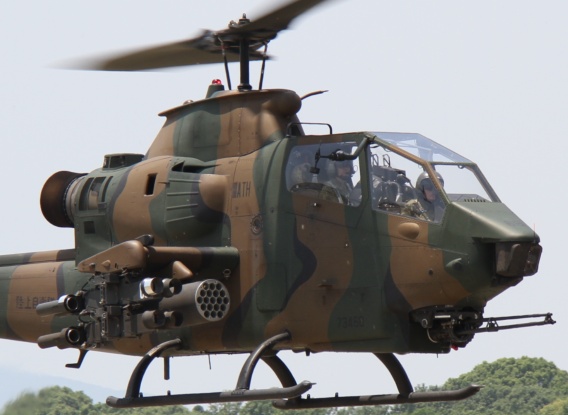 The crew members of a 3rd ATH Unit AH-1S are a study in concentration as they manoeuvre
The crew members of a 3rd ATH Unit AH-1S are a study in concentration as they manoeuvre
close to the ground at Takayubaru, Kumamoto Prefecture, on May 30, 2010.
(Luck-one via Wikimedia Commons)
Having received its first OH-1 on February 9, 2006, the unit was declared at full strength with four aircraft on February 15, 2008; a hangar to house the OH-1s had been completed on April 5, 2006. An AH-64 first joined the ranks in 2009, the year before the unit’s 20th anniversary.
 A photo call in front of the hangars at Metabaru on March 13, 2010, one of the events that
A photo call in front of the hangars at Metabaru on March 13, 2010, one of the events that
marked the 3rd ATH’s 20th anniversary. (Photo: Recon2006, three others at [link])
With little fanfare, AH-1S operations at Metabaru came to an end in March 2021, at which time the 3rd ATH Unit as such ceased to exist.
The base PR office had supplied photos to JWings, which duly published them in the June 2021 issue. The last flight AH-1S having taken place on March 17, they showed the commemorative ceremony held the following day, featuring a long banner expressing gratitude to the AH-1S’s 30 years of service, and the replacement of the unit’s wooden 3rd Anti-Tank Helicopter Unit sign with one showing its new designation, the 1st Combat Helicopter Squadron. The latter change did rate a mention on the history page of the Metabaru Army Camp website (link), but unfortunately one of the first mentions in external media was during a Saga TV news interview with the unit’s CO, Lt. Col. Katsuhiro Tsuchiya, following the disciplinary dismissal of a unit member who had caused a serious road traffic incident.
3rd ATH Unit Markings
Like its sister units, 3rd ATH aircraft carry an alphanumeric identification code, in this case IIIATH.
Another possibly only ad hoc marking carried on a 3rd ATH aircraft was this griffon-like creature (link). The marking was seen on the tail boom of the aircraft that attended an event held in November 2001 to mark the 48th anniversary of the hosting JGSDF Ogori Army Camp in Fukuoka Prefecture and the 40th anniversary of the 5th Engineer Brigade.
Seen in the photo above, an AH-1S was painted in a suitably serpentine marking on the occasion of the unit’s 20th anniversary in 2010 (link).
The previous year, a similar but winged serpent design had been adopted by the 3rd ATH for the 48th anniversary of the Western Region Army (link). Wording to that effect appeared on a snake tail-framed plaque, more clearly seen in this image (link), on both sides of the engine. It was presumably the same aircraft that was present at the Air Memorial event at JMSDF Kanoya in May 2009.
Seen at JASDF Nyutabaru in December 2013, this 3rd ATH Unit Cobra (link) carried a badge bearing the words Raijin 2013 in Yakima—raijin being the god of thunder—and the kanji fūshin (the god of wind) in white on top of the nose (link). The aircraft had been one of those that had taken part in that year’s Rising Thunder training exercise with U.S. elements at the Yakima Training Center in Washington state.
An OH-6D assigned to the 3rd ATH was at the JASDF Nyutabaru air show in November 1993 (link).
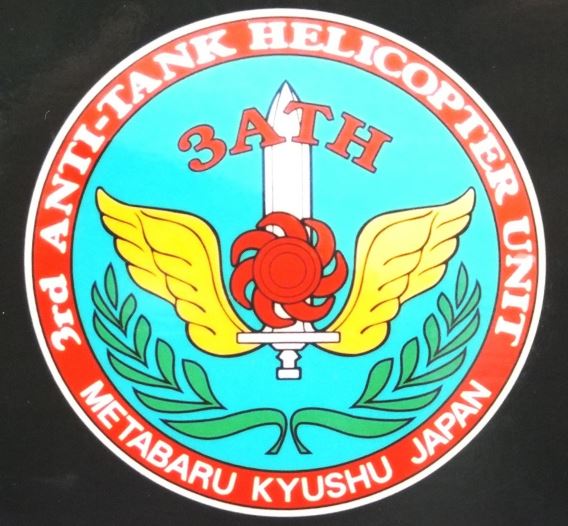 The Metabaru-based 3rd ATH marking seen on the nose of an AH-1S visiting Takuyubaru
The Metabaru-based 3rd ATH marking seen on the nose of an AH-1S visiting Takuyubaru
in April 2003. (Photo: Takao Kadokami)
|
4th ATH |
Formed | March 27, 1992 (Kisarazu) |
| Current Base | Kisarazu |
Assigned to the Eastern Region Army upon its formation in March 1992, the 4th ATH Unit notched up its 25th anniversary as a Kisarazu resident in 2017. Despite being assigned to the capital region, this unit has no dedicated web page.
 (Photo taken at Tachikawa, November 2000)
(Photo taken at Tachikawa, November 2000)
A photo report in Japan Self-Defense Force Squadron (sic) (Ikaros Publications, Summer 1996), showed elements of the unit during two weeks of training at the U.S. Army’s Yakima Training Center in the state of Washington in November 1994, when three AH-1Ss and one of the unit’s two OH-6Ds were deployed.
At the time of the Kisarazu visit to gather material for JSDF Squadron in late April 1996, the 2nd Sqn was away on deployment training, leaving the 1st Sqn to man the fort. The report covered a training mission by the three-aircraft 1st Flight, which at that time was commanded by a Major Hiratsuka, at 35 already referred to as a veteran pilot.
The report describes, from the pre-flight briefing, a standard six-hour training mission, involving heading south and following the Tanba Highway for a refueling stop at Takigahara Army Camp in Shizuoka Prefecture before undertaking training at the North Fuji Maneuver Area. Night training was taken on the return flight to Kisarazu, where the aircraft landed at 21:00.
The head of the flight section who had given the pre-flight briefing, Major Nakamura said that, aside from its combat training, the squadron had assumed responsibilities for post-disaster reconnaissance missions since the Great Hanshin-Awaji Earthquake of January 1995. In the event of an earthquake in the Tokyo metropolitan area, 4th ATHS aircraft would be rapidly launched on damage assessment and information gathering missions.
Helicopters are regularly used for PR and recruitment purposes at events held at JGSDF garrisons. Filmed in April 2017, YouTube footage (link) records the arrival and setting up for static display of a 4th ATH Unit AH-1S at Shibata Army Camp, Niigata Prefecture, which was marking the 62nd anniversary of its establishment.
 A pair of 1st ATH Unit AH-1Ss at the Kisarazu airshow in September 2017
A pair of 1st ATH Unit AH-1Ss at the Kisarazu airshow in September 2017
(Photo: ゆうさん [Yū-san] via Twitter @akubicyandesu)
In a process started by the 2nd and 5th ATH units in the 2010s, the 4th ATH is scheduled to be reduced to a single flight by the end of March 2022.
4th ATH Unit Marking
Like its sister units, the 4th ATH carries an alphanumeric identification code, IVATH. The 1st Flight and HQ Flight are devoid of other identifying marks, but 2nd Flight aircraft have a short white diagonal stripe beneath their rotor masts.
An OH-6D of the 4th ATH Unit’s HQ Flight, which is now equipped with the OH-1, was at Gifu for overhaul in October 1997 (link).
 Aircraft assigned to the 1st Flight of each of the JGSDF AH-1S units are devoid of subunit-specific
Aircraft assigned to the 1st Flight of each of the JGSDF AH-1S units are devoid of subunit-specific
identifying markings. Those of the 4th ATH’s 2nd Flight, however, are distinguished by
a white stripe angled forward on the rotor mast.
(Photo [Higashi-Fuji Training Ground, Aug. 2015]: Toshinori Baba via Wikimedia Commons
4th ATH Unit Special Markings
Taken at the traditional Culture Day show at JASDF Iruma in November 1983, way back in the days of film photography, this photo (link) possibly shows a 4th ATH Unit Cobra sporting an experimental camouflage scheme. In the static display that day was an Eastern Army Squadron OH-6J (31107) that had been finished in a water-based pale green and brown combined with pink sand paint scheme.
October 2011 Kisarazu Airshow AH-1S 73467, OH-1 32628
 (Photo: fuu via Twitter @jboy)
(Photo: fuu via Twitter @jboy)
For three years from 2011, the 4th ATH Unit was in the habit of decorating one side of an aircraft with stickers of progressively gaudy manga-type designs in time for the Kisarazu airshow. These formed the unofficial “Kisarazu Four Sisters” publicity/recruitment campaign.
In late October 2011, the nation was still recovering from the effects of the Great East Japan Earthquake the previous March. For that month’s event, a 4th ATH AH-1S (above and link) was painted in a design that mixed a sharkmouth with a cutout sticker of a character named Aoi-chan, devised by members of the 4th ATH Unit, cherry blossoms and a slogan of encouragement in a show of support for those in the tsunami-affected areas: With One Heart, Let’s Do Our Best Japan! The names of the unit’s eight crew chiefs were listed on the sides of the engine cowlings. Although an original design, its internet popularity reportedly increased due to its likeness to another manga character, after which that particular style of decorated AH-1S loosely came to be named.
The OH-1 on display that day (link) had a more subdued some might say depressing design comprising a ninja, the aircraft’s unofficial and ill-suited nickname—the distinctive noise of its engine hardly enables a stealthy approach—some ninja stars and the Japanese for ‘Kisarazu Air Show 2011’ in black on the nose.
October 2012 4th ATH Unit 20th Anniversary AH-1S 73414
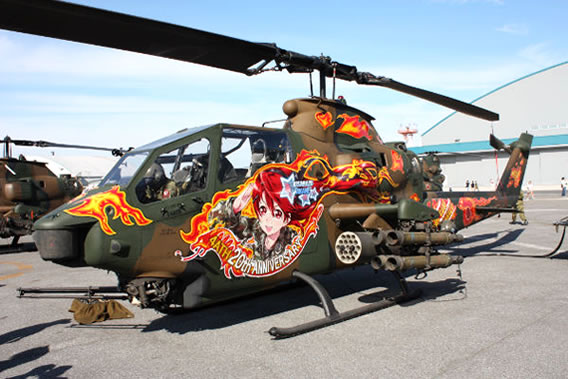
To mark the two decades of the 4th ATH Unit’s existence in 2012, the task was thrown open to professional manga artists, reportedly at the unit members’ expense, via a publishing company. This resulted in “1st Lt. Pilot Kisarazu Akane” design, which followed on from the previous year’s theme and likewise was for static display purposes only. The only marking on the right side was this design (link) on the tail.
May 2013 Kisarazu 45th Anniversary AH-1S 73427, OH-1 32637
 (Photo: fuu via Twitter @jboy)
(Photo: fuu via Twitter @jboy)
Possibly due to the unit’s number, the decision was at some stage made to limit the manga series to four sisters. To show that there are other options open to new recruits, the profession of third sister “Capt. Kisarazu Wakana”, displayed on the AH-1S at the 2013 event, was communications specialist. The design incorporated the event slogan, “Rotors clattering into the future from Kazusa,” the latter being the old name for the part of Chiba Prefecture in which Kisarazu is located (and the name carried on 106th Sqn Chinooks).
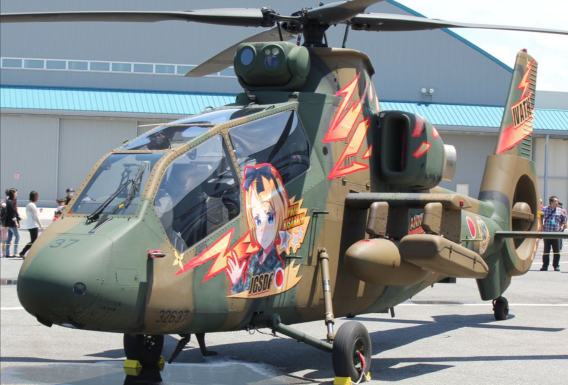 (Photo: fuu via Twitter @jboy)
(Photo: fuu via Twitter @jboy)
As up until that time only the 1st Flight’s Cobras had been used, the design for fourth sister “Kisarazu Yuzu” was applied to an OH-1.

(Above and two below) Also present for the May 2013 event were four 4th ATH Unit AH-1S
helicopters that had been painted in a special scheme for the 45th anniversary of the
establishment of a JGSDF camp at Kisarazu and its 41st air show. The aircraft
featured a large version of the unit badge (see marking below) emblazoned
on their fuselage sides. (Photos: JGSDF Kisarazu)



One of the above aircraft was apparently still wearing the large design under its cockpit in October 2015 together with a nose sticker (link), the manga-like design of which was flanked by the kanji for raijin (the god of thunder).
October 2014 Kisarazu Open Day AH-1S 73467
The aircraft displayed at this rain-soaked event (link) had the previous year’s slogan repeated in a sticker on the rotor mast. A large design beneath the cockpit once again featured the kanji for raijin, the god of thunder.
 September 4, 2014. A 4th ATH Unit AH-1S takes off from a forward aircraft refuelling point to
September 4, 2014. A 4th ATH Unit AH-1S takes off from a forward aircraft refuelling point to
engage targets during training at the Yakima Training Center in the state of Washington. The
training was part of Rising Thunder, a long-established U.S.-Japanese operation designed to
increase interoperability between elements of the two nations’ forces. Just visible is the nose
marking seen here (link) at the Matsudo Army Camp, Chiba Prefecture, in October 2012.
(Photo: U.S. Army/28th Public Affairs Detachment Sgt. Cody Quinn via Wikimedia Commons)
|
5th ATH |
Formed | June 1994 (Akeno) |
| Current Base | Akeno |
[Text pending]
 A fine study of an AH-1S and (in background) OH-6D from the 5th ATH Unit at
A fine study of an AH-1S and (in background) OH-6D from the 5th ATH Unit at
JASDF Komaki in November 1995. (Photo: Akira Watanabe)
 Its cockpit door open to provide much-needed ventilation, a 5th ATH Unit AH-1S was parked on
Its cockpit door open to provide much-needed ventilation, a 5th ATH Unit AH-1S was parked on
static display at JASDF Komatsu AB, Ishikawa Prefecture, on Sept. 18, 2005.
(Uncredited photo via Wikimedia Commons)
Posted in July 2012, a YouTube video (link) shot at Akeno (and in need of editing) includes footage (at the 2:27 mark) of a 5th ATH AH-1S.
 September 28, 2014. A 5th ATH AH-1S participates at an event marking the 52nd anniversary of the
September 28, 2014. A 5th ATH AH-1S participates at an event marking the 52nd anniversary of the
founding of the JGSDF army camp in the city of Toyama.
(Photo: i北陸 [i-Hokuriku] / Hokuriku region official event and tourist destination blog [link])
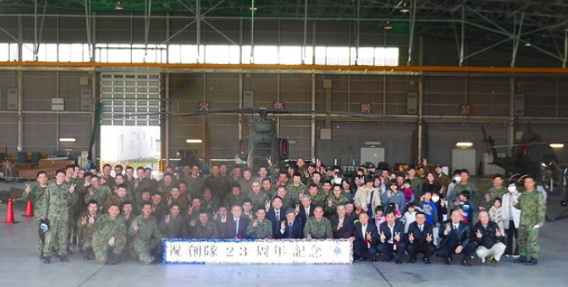 A photo of unit members and their families was taken in March 2017 to mark the
A photo of unit members and their families was taken in March 2017 to mark the
5th ATH’s 23rd anniversary. (Photo: JGSDF/Akeno)
A video showing the takeoff and display of a 5th ATH AH-1S at the Crossland Oyabe Helicopter and Fire/Crime Prevention Festival in Toyama Prefecture in August 2017 can be found here (link). Mentioned elsewhere on this website (link), the event offers the unique opportunity to take photos from above helicopters in flight (link).
Pilot Profile
On September 21, 2016, The Sankei Shimbun ran a website story on the career of a highly experienced 5th ATH Unit pilot, Maj. Yōichi Maeda (54).
In 1978, when he was in his first year of Ube Technical High School in the city of Ube, Yamaguchi Prefecture, Maeda was invited by a friend to the JGSDF’s Youth Technical School (YTS), today known as the High Technical School (HTS) at Camp Takeyama in Yokosuka, Kanagawa Prefecture. His first encounter with a helicopter came five years later in 1983, after he had become a non-commissioned student pilot. His association with the AH-1S Cobra dates back to 1989.
When a Cobra’s fuel tanks are full, the aircraft is already close to its maximum takeoff weight, and so the aircraft is unable to carry a full array of armament. Conversely, fully armed means less fuel and limited range. The Cobra is not the easiest helicopter to fly.
Maeda had suffered a sudden engine failure at 1,000 meters when assigned to the 1st ATH Unit at Obihiro airfield in Hokkaido. From that altitude, with only about a minute to spare, attempting to restart the engine was not an option. Calmly repeating in a real emergency situation the often-practiced autorotation technique brought the aircraft and its occupants down safely.
5th ATH Unit Markings
Like its sister units, the 5th ATH carries an alphanumeric identification code, VATH. This photo (link) shows an OH-6D assigned to the 5th ATH at Akeno in March 1999.
In September 2005, a 5th ATH-assigned OH-6D featured this sinister black motif on its tail (link).
Possibly not an official marking, this Cobra entwined in a cobra motif (link) was seen on an aircraft assigned to the 5th ATH’s 2nd Avn (in other words 2nd Flight) in November 2009.
By 2010, however, the 2nd Flight seems to have adopted a small coloured, disc-shaped nose badge with a white surround, as seen on one of its aircraft at Akeno in March 2010, with an inset photo from October 2012 added (link).
In the mid-2010s, 5th ATH Unit AH-1Ss were to be seen carrying a tail marking combining the word orochi (meaning ‘monster serpent’) with a suitably fearsome design. Both seen at Yao, for some reason this one in November 2014 (link) sported one yellow eye, this in October 2015 (link) had one red eye. These seem to have been variations of a design that had appeared on top of the nose of the aircraft that had participated at the helicopter event held at Crossland Oyabe, Toyama Prefecture, in August 2013 (link).
5th ATH Unit Special Markings
In 2004, the Akeno open day was confined to indoor displays due to a passing typhoon. The following day, aircraft that had been “confined to barracks” were pulled out from their hangars in the fine weather that usually follows. The aircraft included an AH-1S with a fuselage-length white snake marking, bearing the words MA AVIATION 50th Anniversary, MA referring to the founding of the “middle army” (officially the Central Region Army) of the JGSDF (link).
For the JGSDF’s 60th anniversary in 2014, an AH-1S in standard camouflage (link) sported two unit nose markings (link), one of which was a colour sticker (link).
October 2015 Aviation School Akeno 60th Anniversary AH-1S 73462 (link)
 (Photos: JGSDF/Akeno)
(Photos: JGSDF/Akeno)
Sporting two white cobra markings, the aircraft had the first letters of Laser Augmented Airborne Tow (anti-tank missile), written on the nose (link), in red. The rest of the words were in yellow. One other aircraft at the event sported an additional cobra marking.
November 2018 5th ATH 25th Anniversary OH-1 32629
 In November 2018, the 5th ATH sent an OH-1 to a wet Akeno to prematurely proclaim
In November 2018, the 5th ATH sent an OH-1 to a wet Akeno to prematurely proclaim
the unit’s 25th anniversary, also seen in here (link) and here in March 2019 (link).
(Photo: カリス[は休暇を続けたい] via Twitter @TeamCaris)
November 2019 Akeno Army Camp’s 64th Anniversary / Aviation School’s 67th Anniversary OH-1 32629
 A year later, the same aircraft was decked out with a samurai helmet sticker on either side of
A year later, the same aircraft was decked out with a samurai helmet sticker on either side of
the cockpit for the Akeno dual event. The pink kanji on the nose is ornate Japanese for
Air Show 2019, the grey kanji reads hayate, as in World War II fighter, meaning gale.
(Photo: むいむい via Twitter @R1ffP1w1aX1b7BA)
 Note that on the right side the script on the rotor mast read 5th Anti Tank Helicopter Avnspt. The
Note that on the right side the script on the rotor mast read 5th Anti Tank Helicopter Avnspt. The
pink fuselage kanji reads hien, and the aircraft retains the HIEN figure on its tail, worn when
prepared for the 5th ATH’s 25th anniversary the year before. Although difficult to read, the
red script on the missile launcher appears to be a slogan alluding to the JGSDF operating
fixed- and rotor-wing aircraft. (Photo: ふににvia Twitter @hunini181202)
 (Photo: ふににvia Twitter @hunini181202)
(Photo: ふににvia Twitter @hunini181202)
REGIONAL ARMY AVIATION SQUADRONS / HQ FLIGHTS
(UNIT CODES)
|
Northern (N) |
Formed | (NSF) January 10, 1954 (Okadama) (JGSDF Northern Army Aviation Corps) July 1, 1954 (Okadama) (Northern Army Aviation Sqn) Jan. 18, 1962 (Okadama) |
| Disbanded | March 28, 1994 (Okadama) |
Dating back to the NSF’s short-lived Northern District organization, what had become the JGSDF’s Northern Army Aviation Corps on July 1, 1954, was reformed into the Northern Army Aviation Squadron on January 18, 1962. The unit then incorporated three former NSF/JGSDF District Aviation Corps as hikōtai (aviation squadrons) —the 2nd (at Asahikawa), 5th (Obihiro) and 7th (Okadama)—plus the newly formed 11th at Kita-Chitose and the Northern Army Aviation Squadron itself at Okadama. An aviation corps that had been attached to an artillery brigade was disbanded at that time.
 The first of three Fuji LM-2s built when assigned to the Northern Army Aviation Squadron.
The first of three Fuji LM-2s built when assigned to the Northern Army Aviation Squadron.
(Photo: JGSDF Camp Okadama via Twitter @camp_okadama)
 A Northern Army Aviation Squadron L-19A arrives back at Okadama in August 1973.
A Northern Army Aviation Squadron L-19A arrives back at Okadama in August 1973.
(Photo: Akira Watanabe)
 (Above) A pair of Northern Army Aviation Squadron H-19s airborne from Okadama, circa 1961.
(Above) A pair of Northern Army Aviation Squadron H-19s airborne from Okadama, circa 1961.
(Below) An N-marked Kawasaki-built H-13H is one of those receiving attention in front of the
tower at Okadama in the 1960s. In 1961, the airfield passed from military to civil control.
 (Photos: JGSDF Camp Okadama via Twitter @camp_okadama)
(Photos: JGSDF Camp Okadama via Twitter @camp_okadama)
The formation of the Northern Army Helicopter Squadron on March 1, 1968, was followed by that of the 1st Anti-Tank Helicopter Unit at Obihiro on March 25, 1986.
In early 1980, the Northern Army’s own aviation squadron was operating a mixed-bag fleet of LR-1s, LMs and L-19s alongside OH-6Js. Taken at the Chitose airshow in August 1985, this unusual photo (link) shows a Northern Army OH-6J that had for some reason been overpainted in what appeared to be a temporary, water-based lighter green paint.
On March 28, 1994, all four aviation squadrons were passed to division-level command, and the Northern Army’s own aviation squadron disbanded. However, its OH-6 flight was incorporated into the Northern Army Helicopter Squadron, while its LR-1 remained for operation by the newly re-designated Northern Army HQ Flight. The organization in overall command was designated the Northern Army Aviation Group.
Snapshots of Northern Army Aviation Squadron Operations
A page on the Northern Army’s website (link) provides details of selected operations. The earliest coverage of a major disaster relief operation is that following the earthquake that occurred off the coast of southwest Hokkaido in July 1993.
July 1993 / Hokkaido Nansei-Oki Earthquake
 Fires caused by the earthquake rage in the town of Okushiri, and Northern Army helicopter crews
Fires caused by the earthquake rage in the town of Okushiri, and Northern Army helicopter crews
during the disaster response operation. (Photos: Japan Ministry of Defense/JGSDF Northern Army)
A major earthquake that struck off the southwest coast of Hokkaido at 22:17 on July 12, 1993, triggered a tsunami that in a matter of minutes had devastated vast tracts of the island town of Okushiri.
Northern Army utility helicopter elements were naturally the first to answer the calls for assistance. The mission included the airlifting of troops to the scene at dawn on July 13 and then shuttling back and forth to bring in 100 troops from the garrison in Kutchan, close to the Niseko ski resort area, to help with firefighting and casualty evacuations as well as searches for missing persons. While an operational coordination center was set up at Okushiri’s town hall, the next wave saw another 110 JGSDF personnel airlifted direct to a disaster-affected district of the town. About 30 minutes away by air from Hakodate, Okushiri’s airport was used as a forward medical centre with both civilian and military hospital staff flown in actually from the JGSDF Makomanai garrison in Sapporo.
|
Northern Army |
Formed | March 28, 1994 (LR-1, Okadama) |
| Current Base | Okadama (LR-2) |

The Northern Army LR-1 (above) and LR-2 were both present at a wet Okadama on
October 14, 2007. (Photos: 100yen via Wikimedia Commons)

A handful of other photos can be found on the Okadama Army Camp website (link).
 (Photo: Japan Ministry of Defense/JGSDF Northern Army)
(Photo: Japan Ministry of Defense/JGSDF Northern Army)
A dark day in this unit’s history came on May 15, 2017. Contact with an LR-2 was lost when the crew were making preparations for an instrument approach into Hakodate airport on a mission to pick up an emergency hospital case, strong winds and rain as well as thunder and even fog advisories having ruled out a helicopter operation. The wreckage of the aircraft was found the following morning in a mountain forest near Hokuto, around 30 km northwest of Hakodate; all four on board had perished. As reported in the September 14, 2017, edition of the Mainichi Shimbun, the accident investigation findings attributed the initial cause to the pilot having inadvertently disengaged the autopilot while talking to air traffic control, exacerbated by a loss of special awareness.
 (Photo: Japan Ministry of Defense/JGSDF)
(Photo: Japan Ministry of Defense/JGSDF)
 (Photo: Japan Ministry of Defense/JGSDF Northern Army)
(Photo: Japan Ministry of Defense/JGSDF Northern Army)
|
Northeastern (NE) |
Formed | Jan. 18, 1962 (Kasuminome) |
| Current Base | (Northeastern Army HQ Flight) Kasuminome |
The wholesale reorganization of the JGSDF that took place January 18, 1962, resulted in the Kasuminome-based 6th District’s 6th Aviation Corps being joined by the 9th from Hachinohe and re-designated hikōtai (aviation squadrons) under the command of the newly formed Northeastern Army Aviation Group. The Northeastern Army Aviation Squadron was also newly formed on that day.
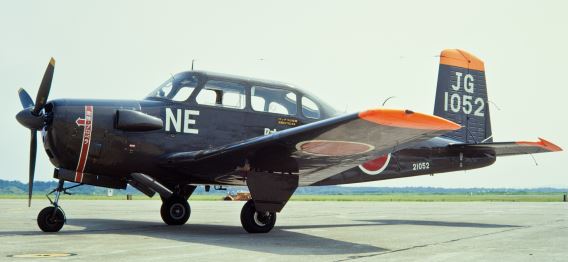 A Northeastern Army Aviation Group LM-2 on a visit to JASDF Matsushima AB in July 1975
A Northeastern Army Aviation Group LM-2 on a visit to JASDF Matsushima AB in July 1975
(Photo: Akira Watanabe)
The Northeastern Army Helicopter Squadron came into being on March 1, 1968, also at Kasuminome, but moved to Jinmachi Army Camp (Yamagata Airport) on March 6, 1969.
Taken in July 1975, this photo (link) of a Northeastern Army Aviation Squadron OH-6J parked in front of the Kasuminome tower has a nice tranquil feel; you can almost hear the twittering of the birds. Come early 1980, and the Northeastern Army’s own squadron was operating the LR-1, L-19, LM and OH-6Js, while the helicopter component was flying UH-1Bs and ’Hs, all from that same airfield. The 2nd Anti-Tank Helicopter Unit formed at Hachinohe on March 25, 1988.
On March 28, 1994, the two aviation squadrons were passed to division-level command, and the fixed-wing element of the Northeastern Army Aviation Squadron reformed as the Northeastern Army HQ Flight.
|
Northeastern Army |
Formed | March 28, 1994 (LR-1, Kasuminome) |
| Disbanded | March 2006 |
This unit ceased flight operations in March 2006, when the LR-2 operations on the Japanese mainland island of Honshu were consolidated under the 1st Helicopter Brigade at Kisarazu as the Liaison/Reconnaissance Flight (aircraft coded LR).
|
Eastern (E) |
Formed | Jan. 18, 1962 (Kasumigaura) |
| Current Base | (Eastern Army HQ Flight) Tachikawa |
On January 18, 1962, the Kasumigaura-based 1st District reorganized its 1st Aviation Corps into the 1st Aviation Squadron under the Eastern Army Aviation Group. In this case, the co-located newly formed sister unit was designated the 12th Aviation Squadron, which was newly formed with the Eastern Army Aviation Squadron.
Only around 10 months were to pass before the Eastern Army Aviation Squadron’s HQ was relocated to Kita-Utsunomiya. Back at Kasumigaura, the Eastern Army Helicopter Squadron was newly formed on August 1, 1969.
It was the regional entity’s turn to move in 1972, an advance guard that formed at Tachikawa in Tokyo on March 7 being joined by the main force on December 27 of that year; the HQ moved from Kita-Utsunomiya on May 3, 1973. In 1980, the Eastern Army Aviation Squadron with its LR-1, LM and OH-6J aircraft was sharing Tachikawa with the Eastern Army Helicopter Squadron, which in its original form was at that time operating a mix of UH-1Bs and ’Hs.
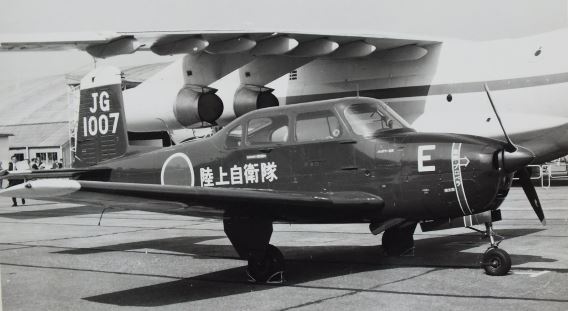 An Eastern Army Aviation Squadron LM-1 at the Asahi Shimbun-sponsored international air show
An Eastern Army Aviation Squadron LM-1 at the Asahi Shimbun-sponsored international air show
held at Iruma in October 1973. (Photo: Takao Kadokami)
 An Eastern Army Aviation Squadron OH-6J at Tachikawa in October 1976 (Photo: Takao Kadokami)
An Eastern Army Aviation Squadron OH-6J at Tachikawa in October 1976 (Photo: Takao Kadokami)
The 1980s were a time for experimental camouflage schemes, and one such in the case of the JGSDF was present in the static display at the traditional Culture Day show at JASDF Iruma in November 1983. Eastern Army Squadron OH-6J (31107) had been finished in a three-tone, water-based paint scheme of pale green and brown combined with pink sand. The only photo reference found was on page 56 of the photo collection that carries the sloppy English title Wings of Japan Ground Self Defence Force, published by Hobby Japan early in 2020.
The region’s 4th Anti-Tank Helicopter Unit joined the ranks at Kisarazu on March 27, 1992. On March 28, 1994, the 1st and 12th aviation squadrons were passed to division-level command, and the fixed-wing element of the Eastern Army Aviation Squadron reformed as the Eastern Army HQ Flight.
According to its Japanese-language website (link), the geographical extent of the Eastern Army’s defense and disaster relief responsibilities encompasses the Tokyo metropolitan area, the 10 prefectures of the Kanto and Koshin’etsu regions (including Sado Island off the coast of Niigata Prefecture) plus Shizuoka Prefecture. The land area covered amounts to around 70,800 sq. km, or nearly 20% of Japan’s total land mass, and its 51.7 million inhabitants represent 40% of Japan’s total population and also 40% of the nation’s gross domestic product. The Sea of Japan and Pacific Ocean coastlines extend for 600km and 1,600km, respectively.
The Tokyo Metropolitan Government-administered area, and with it the Eastern Army’s remit, also includes no less than 481 islands in the Pacific Ocean, 16 of which are inhabited. The latter extend from Izu-Oshima (a mere 100km away to the south), the Ogasawara (Bonin) Island chain (1,000km) and Iwo To (formerly Iwo Jima, 1,200km) to Japan’s most easterly point, Minami-torishima (the Marcus Islands atoll, 1,848km away to the southeast). The latter is actually home to a Self-Defense Force and Japan Coast Guard presence, including a runway that can accept supply flights made by JASDF, JMSDF and JCG transport aircraft.
 Taken at Tachikawa in November 1987, the above photo shows an Eastern Army LR-1 in the then
Taken at Tachikawa in November 1987, the above photo shows an Eastern Army LR-1 in the then
new camouflage scheme with black markings. This remained the standard scheme for the rest of
the type’s service career. (Photo: Akira Watanabe)
|
Eastern Army |
Formed | March 28, 1994 (LR-1, Tachikawa) |
| Disbanded | March 2006 |
This unit ceased flight operations in March 2006, when the LR-2 operations on the Japanese mainland island of Honshu were consolidated under the 1st Helicopter Brigade at Kisarazu as the Liaison/Reconnaissance Flight (aircraft coded LR).
 (Photo taken at Tachikawa, November 2000)
(Photo taken at Tachikawa, November 2000)
|
Central (M) |
Formed | January 18, 1962 (Yao) |
| Current Base | (Central Army Aviation Group, HQ Unit) Yao |
 The JGSDF has historically always referred to its Central Army as its Middle Army,
The JGSDF has historically always referred to its Central Army as its Middle Army,
hence MA Aviation Group appears on the badge shown on the unit’s website (link).
Formed on January 18, 1962, the Central Region Aviation Group comprised the existing 3rd District’s 3rd Aviation Corps at Yao and the 10th District’s 10th Aviation Corps at Akeno, which were made into aviation squadrons. Newly formed on that day were the 13th Aviation Squadron, which moved from Yao to Hofu in November that year, and the Central Army Aviation Squadron. The Central Army Helicopter Squadron was newly formed on March 1, 1968.
In 1980, the Central Army Aviation Squadron was flying LR-1, LM and OH-6J aircraft from Yao alongside the Central Army Helicopter Squadron, which at that time in its original form was operating a mix of UH-1Bs and ’Hs.

Found in a hangar at Yao in March 1980 were the Central Army’s LM-1 (above) and LR-1.
(Photos: Takao Kadokami)

 This Central Army LR-1 was an outdoor guest at the Iwakuni Friendship Day in May 1987.
This Central Army LR-1 was an outdoor guest at the Iwakuni Friendship Day in May 1987.
(Photo: Takao Kadokami)
On March 28, 1994, the 3rd and 10th and 13th aviation squadrons were passed to division-level command, and the fixed-wing element of the Central Army Aviation Squadron reformed as the Central Army HQ Flight. The region’s 5th Anti-Tank Helicopter Unit became the last of its kind to form at that time and was declared fully operational in June that year.
 The wording on the unit’s badge says “Middle Army Aviation Group HQ Unit”
The wording on the unit’s badge says “Middle Army Aviation Group HQ Unit”
In March 2006, operation of the Central Army HQ Flight’s LR-1 was transferred to what was now termed the Liaison/Reconnaissance Flight.
Three years later, in March 2009, a unit charged with preparing for the formation of the 14th Aviation Squadron was set up within the HQ organization; the process was declared complete on March 26, 2010, when the 14th officially joined the ranks under the command of the 14th Division.
The next major re-equipment process, of supplying the Central Army Aviation Squadron with OH-1s, was commenced on February 16 and completed on March 27, 2012.
In 2014, the unit’s 16 aircraft were called upon to assist when major landslides struck parts of the city of Hiroshima in August and during the heavy snowfall in Tokushima Prefecture in December as well as to relay images taken from the air in the aftermath of natural disasters.
Professionally filmed at Yao by SankeiNews on January 13, 2015, this short YouTube video (link) shows the Central Army Aviation Group’s first flight of the year.
|
Central Army |
Formed | March 28, 1994 (LR-1, Yao) |
| Disbanded | March 2006 |
In 2005, a Yao-based LR-1 was given a flamboyant tail marking (link); the whole aircraft is seen here (link) at Yao in September that year.
This unit ceased flight operations in March 2006, when the LR-2 operations on the Japanese mainland island of Honshu were consolidated under the 1st Helicopter Brigade at Kisarazu as the Liaison/Reconnaissance Flight (aircraft coded LR).
|
Western (W) |
Formed | (As Western Region Aviation Group) Jan. 25, 1956 (Ozuki) Jan. 18, 1962 (Takumabaru) |
| Current Base | (Western Army HQ Flight) Takayubaru |
Having already been formed at Ozuki on January 1, 1956, the Western Army Aviation Group moved to the JGSDF’s Takumabaru Army Camp (the location of today’s Kumamoto Airport) on August 20, 1957.
On January 18, 1962, the local JGSDF aviation elements in western Japan followed the example of the other regions by forming aviation squadrons, the 4th from the existing 4th District’s 4th Aviation Corps alongside the newly formed 8th, both at Metabaru. Also newly formed at Metabaru was the Western Army Aviation Squadron.
During the course of 1971, the 8th Aviation Squadron and the Western Army Aviation Squadron moved from Metabaru to Takayubaru.
 An LR-1 wearing the then letters WA for Western Army at Takayubaru in
An LR-1 wearing the then letters WA for Western Army at Takayubaru in
March 1976. (Photo: Takao Kadokami)
In 1980, the Western Army Aviation Squadron was flying LR-1, LM-1, H-13 and OH-6J aircraft from Takayubaru alongside the Central Army Helicopter Squadron, which in its original form was at that time operating a mix of KV-107IIs, UH-1Bs and ’Hs.
 Western Army Aviation Squadron LR-1s at Takayubaru on a wet day in
Western Army Aviation Squadron LR-1s at Takayubaru on a wet day in
April 1981 (above) and taxying in the sun in April 1993.
 (Photos: Takao Kadokami*)
(Photos: Takao Kadokami*)

Among the aircraft present at the April 1989 open day at Takayubaru in Kumamoto Prefecture were
Western Army Aviation Group OH-6D 31208 (above) and LR-1 22014. The latter ended up
dismantled at Kasumigaura in 2009. (Photos: Takao Kadokami)

(*) A long-term resident of Oita City, aviation photographer Takao Kadokami has kindly made a large number of his photos available to J-HangarSpace. Living in Kyushu meant that he was well placed to capture on camera many of the aviation events in that part of Japan, including the comings and goings of JGSDF Western Region aircraft at Oita Airport. One of his earliest photos, a November 1955 image of a school friend standing in front of a JGSDF L-5A Sentinel at Oita, graces this website’s homepage.
On March 28, 1994, the 4th and 8th aviation squadrons were passed to division-level command, and the fixed-wing element of the Western Army Aviation Squadron reformed as the Western Army HQ Flight.
In other rotorcraft developments, the Western Army Helicopter Squadron was newly formed on March 1, 1968, the region’s 3rd Anti-Tank Helicopter Unit on March 26, 1990. Initially equipped with the AH-1S, the latter was also supplied with its first AH-64 on March 12, 2010.
Spanning the years 1959 to 1977, the following is a chronological selection of more photos from Takao Kadokami’s archives.
 At that time normally based at Takumabaru, the site of today’s Kumamoto Airport, Kawasaki-Bell
At that time normally based at Takumabaru, the site of today’s Kumamoto Airport, Kawasaki-Bell
H-13H 30107 paid a visit to Oita Airport in early April 1959. (Photo: Takao Kadokami)

(Above) An unusual view looking down on the glazed cockpit roof of L-19A 11055 at Oita Airport in
February 1959. This aircraft was written off in a crash on May 14, 1973.
(Below) A pair of two-tone olive drab/orange L-19s (L-19A 11098, left, and L-19E-1 11209) at
Oita Airport in November 1960. (Photos: Takao Kadokami)

 In this bucolic scene, taken at Oita Airport in September 1966, it seems that the crew of UH-1B
In this bucolic scene, taken at Oita Airport in September 1966, it seems that the crew of UH-1B
41523 is either selling groceries or has stopped to ask for directions. (Photo: Takao Kadokami)
 While a YS-11 hurtles skyward in the background, LM-1 21023 sits quietly on the Oita Airport tarmac
While a YS-11 hurtles skyward in the background, LM-1 21023 sits quietly on the Oita Airport tarmac
on July 13, 1968. A matter of weeks after this photo was taken, on August 1 that year, this aircraft
crashed in the mountains of Shodo Island when en route from Takayubaru to Yao, an accident that
tragically claimed the lives of all three people on board. (Photo: Takao Kadokami)
 T-34A 60503 about to touch down at Takayubaru in March 1976. (Photo: Takao Kadokami)
T-34A 60503 about to touch down at Takayubaru in March 1976. (Photo: Takao Kadokami)
 The Western Army Region representative OH-6J departs the November 1977 JASDF Nyutabaru air
The Western Army Region representative OH-6J departs the November 1977 JASDF Nyutabaru air
show. After its flying days were over, this particular aircraft was placed on display at the
JGSDF base in Himeji, Hyogo Prefecture. (Photo: Takao Kadokami)
|
Western Army |
Formed | March 28, 1994 (LR-1, Takayubaru) |
| Current Base | Takayubaru |
Operating both the LR-1 and LR-2 in 2003, the Western Army HQ Flight has continued to operate the LR-2 following the retirement of the older type.
Western Army Markings
Taken 24 years apart are these colour photos of W LR-1s: one from the then Western Army Aviation Squadron in the at that time standard scheme at Takayubaru in April 1983 (link), the other, from the now HQ Flight and sporting an eagle tail marking, at Naha in September 2007 (link).
The badge carried on the nose and side door of the W UH-1H (above), seen at Takayubaru in April 1996, appears to be that of the Metabaru-based HQ Flight. At that time its design consisted of a stylized heraldic bear’s head on a three-legged stand above a scroll bearing the city and prefecture name Kumamoto, the kuma of which is from the word for bear.
REGIONAL ARMY HELICOPTER SQUADRONS (UNIT CODES)
|
Northern (NH) |
Formed | March 1, 1968 (Okadama) |
| Current Base | Okadama |
 Aircraft from the Northern Army Aviation Helicopter Squadron during an inaugural flypast,
Aircraft from the Northern Army Aviation Helicopter Squadron during an inaugural flypast,
March 1968. (Photo: JGSDF Camp Okadama via Twitter @camp_okadama)
Having formed with 10 UH-1Bs on March 1, 1968, the Northern Region Helicopter Squadron supported the 1972 Winter Olympics in Sapporo.
On March 28, 1994, the Northern Army’s own aviation squadron disbanded and its OH-6 flight was incorporated into the Northern Army Helicopter Squadron, which came under the command of the Northern Army Aviation Group. The unit surpassed the 51,000 accident-free hours mark in 1996.
Aside from regular training exercises covering every eventuality, domestic disaster relief operations have included the 1993 Hokkaido earthquake and the volcanic eruption of Mt. Usu, Hokkaido Prefecture, in 2000. Overseas, the unit was part of the international earthquake relief operations in Pakistan in 2005 and, in contrast, took part in live-fire missile training in the United States in 2006.
 (Above) Members of the Air Support Unit temporarily formed within the Northern Army Aviation
(Above) Members of the Air Support Unit temporarily formed within the Northern Army Aviation
Helicopter Squadron for the Sapporo Winter Olympics in 1972. The unit’s tasks included
transporting the Olympic flame. (Below) The Northern Army Aviation Helicopter Squadron
took part in its first disaster relief operations in April 1968, the month after its formation.
 (Photos: JGSDF Camp Okadama via Twitter @camp_okadama)
(Photos: JGSDF Camp Okadama via Twitter @camp_okadama)
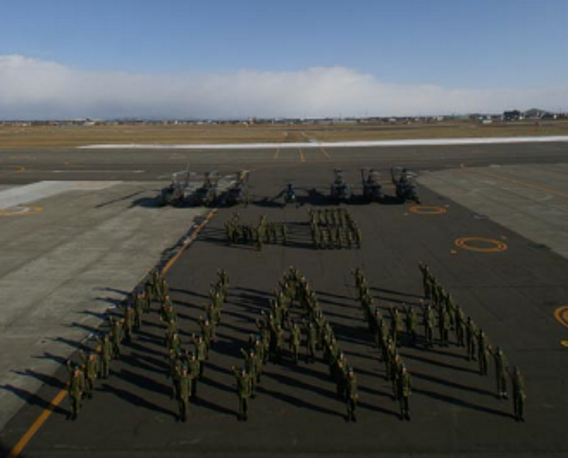 The Northern Army Helicopter (NAH) Squadron celebrated its 40th anniversary at
The Northern Army Helicopter (NAH) Squadron celebrated its 40th anniversary at
Okadama on March 1, 2008. (Photo: JGSDF)
In terms of equipment, the first of the then new OH-6Ds was received in 1994, the first OH-1 in 2011. The unusual sight of one of the Northern Army Helicopter Squadron OH-6Ds fitted with twin loudspeakers was recorded at Okadama in September 2005 (link).
Other photos can be found on the unit’s dedicated page on the Okadama Army Camp website (link). These include a UH-1J close to the Mt. Usu volcano in 2000 and two images of the relief operations in Pakistan in 2005.
 The Northern Army Helicopter Squadron hangar at Okadama
The Northern Army Helicopter Squadron hangar at Okadama
(Photo [undated]: Japan Ministry of Defense/JGSDF)
Snapshots of Northern Army Helicopter Squadron Operations
February 10–17, 1996 / Toyohama Tunnel Disaster
Involving elements from the Northern Army Aviation Group in response operations, a major disaster of a different kind occurred early in 1996.
At around 08:00 on February 10 that year, a rock fall caused a huge boulder to strike a roadway entrance to the Toyohama Tunnel, near the town of Furubira, Hokkaido Prefecture; 20 lives were lost. In freezing conditions, blasting the rock to enable rescue operations was successful only on the fourth attempt. Those operations involved 3,400 JGSDF troops, 760 vehicles and 60 helicopters.
July to December 1999 / International Emergency Support (Japan Disaster Relief Team)
 A Northern Army Aviation Group UH-1H is carefully loaded aboard a JASDF C-130H prior to
A Northern Army Aviation Group UH-1H is carefully loaded aboard a JASDF C-130H prior to
departure for Turkey. (Photo: Japan Ministry of Defense/JGSDF Northern Army)
During this four-month period, it was the Hokkaido-based 11th Brigade’s turn to be the JGSDF unit on standby to respond to international calls for assistance at the behest of the Japan International Cooperation Agency (JICA). As one of the brigade’s component air units in such a situation, the Northern Army Aviation Group was sent in support of Japan Disaster Relief Team efforts following the August 1999 Izmit Earthquake in Turkey.
March 2011 / Great East Japan Earthquake
 A Northern Army Helicopter Squadron UH-1J crew on a reconnaissance mission near the city of
A Northern Army Helicopter Squadron UH-1J crew on a reconnaissance mission near the city of
Kamaishi, Iwate Prefecture, in the aftermath of the earthquake and tsunami of March 2011.
(Photos: Japan Ministry of Defense/JGSDF Northern Army)
 Another Northern Army Helicopter Squadron UH-1J crew talks to a Disaster Medical Assistance
Another Northern Army Helicopter Squadron UH-1J crew talks to a Disaster Medical Assistance
Team (DMAT) member and other first responders during the relief operations in March 2011.
(Photo: Japan Ministry of Defense)
January 31, 2013 / Joint Training with Commercial Communications Providers
 Communications company staff verify the most efficient order in which to load essential
Communications company staff verify the most efficient order in which to load essential
equipment on board a UH-1J. (Photos: Japan Ministry of Defense/JGSDF Northern Army)
Although not the most exciting of insights into JGSDF helicopter operations, this does serve to show another dimension, namely preparation for disaster relief.
One of the first tasks after an event has occurred is to rapidly set up on-the-spot or nearby communications links. As a result of the lessons learned from the Niigata Chuetsu Offshore Earthquake of 2004, the government had contracted the first of two communications providers in 2007, and this was the third time that this training had been conducted in Hokkaido.
 Unloading at the area affected by the “earthquake”.
Unloading at the area affected by the “earthquake”.
(Photos: Japan Ministry of Defense/JGSDF Northern Army)
For this simulated earthquake response, 10 Northeastern Army Aviation Group personnel worked with 20 staff members from the two providers in rehearsing prompt loading, transporting, unloading and setting up of the necessary equipment in winter conditions, using two helicopters.
April 25–28, 2014 / Forest Firefighting, Hokkaido Prefecture
 The April 2014 fire near the town of Shiriuchi, along the coast from Hakodate in
The April 2014 fire near the town of Shiriuchi, along the coast from Hakodate in
southern Hokkaido (Photo: Japan Ministry of Defense/JGSDF Northern Army)
When called upon, the regional army squadrons naturally work in concert with their aviation squadron counterparts, most often in search and rescue missions or in fighting forest fires.
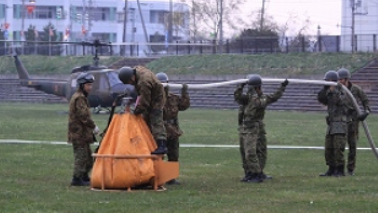 (Above and below) Filling and attaching a bucket ready for the next mission.
(Above and below) Filling and attaching a bucket ready for the next mission.
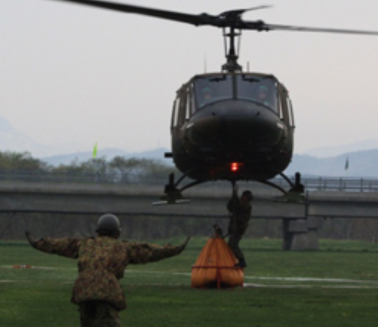 (Photos [Shiriuchi, Hokkaido Prefecture, April 2014]:
(Photos [Shiriuchi, Hokkaido Prefecture, April 2014]:
Japan Ministry of Defense/JGSDF Northern Army)
In this case partnered with the 11th AvSqn and local, prefectural-level firefighting units, NH crews dealt with, unusually, consecutive blazes in the Ofunecho district of Hakodate (April 25–26) and near the town of Shiriuchi (April 26–28). During the former operation, a combined total of 8.1 tonnes of water were released in 12 drops, during the latter 19.6 tonnes in 28 drops.
January 7, 2016 / First Formation Training Flight of Year
 Out on the cold expanse of the Okadama apron, Northern Army Aviation Group personnel listen
Out on the cold expanse of the Okadama apron, Northern Army Aviation Group personnel listen
to the regional inspector general’s New Year address, which traditionally precedes the first
formation training flight. (Photo: Japan Ministry of Defense/JGSDF Northern Army)
January 11 to February 29, 2016 / 7th Ground Troop Winter
Combat Course Training
 (Photos: Japan Ministry of Defense/JGSDF Northern Army)
(Photos: Japan Ministry of Defense/JGSDF Northern Army)
Northern Army Helicopter Squadron crews flew in support of this arduous seven-week course. The participants were 31 soldiers who first completed a basic mountain training course before moving on to the training grounds near the cities of Sapporo, Chitose and Eniwa as well as at Kita-Hiroshima (between Sapporo and Shin-Chitose International Airport) in March.
January 10, 2017 / First Formation Training Flight of Year
 (Photo: Japan Ministry of Defense/JGSDF Northern Army)
(Photo: Japan Ministry of Defense/JGSDF Northern Army)
Having been officially appointed the previous summer, the then inspector general of the Northern Army, Lt. Gen. Kōji Yamazaki (above, right), was present for this annual event. In addition to the New Year address on the ground, he gave the flight crews an in-flight pep talk by radio from on board one of the six UH-1Js in the 14-aircraft Northern Army Aviation Group formation that overflew Sapporo to mark the occasion.
May 9, 2017 / Support for Forest Fire in Tohoku Region
 The live-feed video camera-equipped UH-1J from the Northern Army Helicopter Squadron en
The live-feed video camera-equipped UH-1J from the Northern Army Helicopter Squadron en
route from Hokkaido to Honshu on May 9, 2017. (Photo: JGSDF/Northern Army)
At the request of its counterpart in the northeast (Tohoku) region, a Northern Region Helicopter Squadron UH-1J was sent to provide continuous streaming of video while a major firefighting operation was under way. (A report on the May 8–15, 2017, operation appears under the 1st Transport Helicopter in JGSDF Squadron Histories Part 1.)
January 12, 2018 / First Formation Training Flight of Year
 Seen against a Sapporo backdrop, three of the seven UH-1Js that took part in the Northern Army
Seen against a Sapporo backdrop, three of the seven UH-1Js that took part in the Northern Army
Aviation Group’s 15-aircraft New Year formation, which also comprised five AH-1Ss, two
OH-6Ds and the sole LR-1. (Photo: Japan Ministry of Defense/JGSDF Northern Army)
Sept. 6 to Oct. 14, 2018 / Hokkaido Eastern Iburi Earthquake
 A Northern Army Helicopter Squadron UH-1J about to launch following the earthquake that
A Northern Army Helicopter Squadron UH-1J about to launch following the earthquake that
struck in the early hours of September 6, 2018. (Photo: JGSDF/Northern Army)
The port city of Tomakomai, located in the Iburi district south of Sapporo, bore the brunt of this major earthquake, which struck at 03:08 on September 6, 2018. Felt in the Kanto region far to the south, the earthquake claimed 41 lives, caused widespread damage and left 5.3 million inhabitants without power. The Northern Army Helicopter Squadron was heavily involved from the outset, initially in the rescue and damage assessment phases and later in support of ground units in the airlift of supplies and materiel to the disaster-affected areas.
May 28–30, 2019 / Forest Firefighting, Omu, Hokkaido Prefecture
The Northern Army Helicopter Squadron’s involvement in this operation (also covered in the 2nd AvSqn entry in JGSDF Squadron Histories Part 1) started in the early hours of May 28, the day after the outbreak of the fire.
Continuing the water-bombing initiated by the 2nd AvSqn on the afternoon of the first day, a single UH-1J departed Okadama at around 06:45 on the next three days, and a video-camera equipped UH-1J at 10:35 on May 29 and 06:28 on May 30. These operations were dovetailed with those not only of the 2nd AvSqn but also the 1st Helicopter Brigade at Kisarazu and the JASDF’s Misawa-based Helicopter Airlift Squadron.
 (Photo: Japan Ministry of Defense/JGSDF Northern Army)
(Photo: Japan Ministry of Defense/JGSDF Northern Army)
 (Photos [Kisarazu airshow, Dec. 2019]: Yuji via Twitter @Yuji0610_photo)
(Photos [Kisarazu airshow, Dec. 2019]: Yuji via Twitter @Yuji0610_photo)

 The view from the cockpit of Northern Army Helicopter Squadron UH-1J 41903 on January 9, 2020,
The view from the cockpit of Northern Army Helicopter Squadron UH-1J 41903 on January 9, 2020,
when 12 Northern Army Aviation Group aircraft took part in the first formation training flight
of the New Year. Acquired specially for the occasion on the squadron’s traditional visit
to a local shrine to pray for crew safety, a votive tablet (ema) is attached to the
central cockpit canopy frame directly in front of the pilots.
(Photo: JGSDF Northern Army via Twitter @NorthernArmy_pr)
Northern Ladybirds Display Team
Okadama’s answer to Hofu’s Humming Birds, Utsunomiya’s Sky Hornets and Akeno Rainbow (not to mention Rainbow Cobra and its unappealingly named predecessor Sky Snake), the Northern Ladybirds was an ad hoc team made up of line pilots who also served as display pilots.
In its early days, the team used multicoloured smoke, but probably fell into line and switched to white smoke as a result of the complaints received by the Blue Impulse team about grimy deposits found on cars parked at bases on show days.
Whereas the Sky Hornets have been easily replaced by the TH-480B Blue Hornets team, the retirement of the OH-6D from the JGSDF’s ranks has also brought about the extinction of the Northern Ladybirds.
More details will be added in due course. In the meantime, amateur footage of the team in action, shot at the Okadama airshow in 1999, exists on YouTube (link).
Northern Army Helicopter Squadron Markings

Northern Army Helicopter Squadron UH-1Js normally carry the unit badge (above) on the nose. The text on the ribbon of the badge reads (left) 1st Aviation and (right) Camp Okadama Sapporo Japan. Written at the bottom of the shield are (left) a reference to 1968, the year of the unit’s formation, and C/C.
1st Flight UH-1Js used to have a white fuselage stripe, the 2nd Flight a forward-pointing chevron. The OH-6Ds formerly flown by the HQ Flight were devoid of markings other than the NH unit identification code common to all aircraft.
Northern Army Helicopter Squadron Special Markings
June 2003 Centennial of Powered Flight, Okadama 50th Anniversary OH-6D 31226
 The specially painted aircraft described below leads this Northern Ladybirds formation
The specially painted aircraft described below leads this Northern Ladybirds formation
during the team’s display at Okadama, Hokkaido Prefecture, in June 2003.
(Photo: 402SQC-1 via Wikimedia Commons)
In 2003, a paint shop team was let loose on an NH OH-6D to mark a dual celebration, the centennial of powered flight and the half century that had passed since the establishment of a base at Okadama. Shown here in the static display at the Sky High 2003 airshow in June that year (link), this aircraft performed in a display by the Northern Ladybirds team later that day. As can also be seen on this view of the right side (link), amid the plagiarized U.S. centennial ribbon stripes the design incorporated a “sharkmouth,” a silhouette of a Wright Flyer, a version of the puffin and spanner badge of the Northern Army Field Maintenance Unit (below), and the standard Japanese national flag on the tail.
 (Image from NAFMU website page [link])
(Image from NAFMU website page [link])
July 2022 Okadama 69th Anniversary OH-1 32631
 On this occasion, a specially marked (with stickers) Northern Helicopter Sqn OH-1 was displayed
On this occasion, a specially marked (with stickers) Northern Helicopter Sqn OH-1 was displayed
launching cartoon missiles. The nose appears to have a black ninja (the type’s nickname)
figure within the Greek letter omega, the type’s radio call-sign.
 (Photos: [Top] Official髭曇dism via Twitter @foggy_ja8369;
(Photos: [Top] Official髭曇dism via Twitter @foggy_ja8369;
[above] Takki [たっきー] via Twitter @Takki_Sapporo)
 The Japanese on the left side of the OH-1’s rotor mast stated that it was also the 50th anniversary
The Japanese on the left side of the OH-1’s rotor mast stated that it was also the 50th anniversary
of the Higashi Ward district of Sapporo, where Okadama is located. Displayed in the cockpit
windows on both sides were print-outs of the logo designed to mark the milestone.
 (Photos: Official髭曇dism via Twitter @foggy_ja8369)
(Photos: Official髭曇dism via Twitter @foggy_ja8369)
|
Northeastern (NEH) |
Formed | Mar. 1, 1968 (Kasuminome) |
| Current Base | Kasuminome |
The Northeastern Army Helicopter Squadron came into being at Kasuminome on March 1, 1968, but moved to Jinmachi Army Camp (Yamagata Airport) on March 6, 1969. By early 1980, the unit was flying a mix of UH-1Bs and ’Hs.
 In addition to the 1st Helicopter Corps, which in those days was based at Kasumigaura as part of
In addition to the 1st Helicopter Corps, which in those days was based at Kasumigaura as part of
the Aviation School, the H-19C served with all five regional helicopter units. In service until the
late 1970s, this example was displayed at Kasuminome, where it was seen under the cherry
blossoms for what is thought to have been the last time in April 2004 (link).
(Photo [August 1991]: Takao Kadokami)
 Seen against the seemingly censored backdrop of the vast open space of Misawa AB in June 1989 is
Seen against the seemingly censored backdrop of the vast open space of Misawa AB in June 1989 is
Northeastern Army Helicopter Squadron UH-1H 41630. (Photo: Akira Watanabe)
 A Northeastern Army Helicopter Squadron UH-1J was present at the JASDF Akita Sub-Base
A Northeastern Army Helicopter Squadron UH-1J was present at the JASDF Akita Sub-Base
open day event in October 2017. (Photo: JASDF Akita Sub-Base)
Snapshots of Northeastern Army Helicopter Squadron Operations
 A series of dramatic photos taken during the aerial ballet performed at the scene of the major
A series of dramatic photos taken during the aerial ballet performed at the scene of the major
May 2017 forest fire in Kamaishi, Iwate Prefecture. (Photo: JGSDF/Northern Army)
 April 9, 2019. A Northeastern UH-1J heads off to assist the firefighting operations under way in the
April 9, 2019. A Northeastern UH-1J heads off to assist the firefighting operations under way in the
Tamuramachi district of Koriyama, Fukushima Prefecture. (Photo: JGSDF Northeastern Army)
 The Northeastern crew’s early morning view on a mission to relay live images from the
The Northeastern crew’s early morning view on a mission to relay live images from the
scene of the Tamuramachi fire. (Photo [Apr. 10, 2019]: JGSDF Northeastern Army)
Please see JGSDF Squadron Histories Part 1 for details on the following forest firefighting operations in which the Northeastern Army Helicopter Squadron participated:
(1st Transport Helicopter Group)
Mar. 30 to Apr. 1, 2016 / Date, Fukushima Prefecture
May 8–15, 2017 / Kamaishi, Iwate Prefecture (and 9th AvSqn)
Apr. 12–14, 2018 / Miyako, Iwate Prefecture
Apr. 9–10, 2019 / Koriyama, Fukushima Prefecture
Apr. 30 to May 1, 2019 / Nanyo, Yamagata Prefecture
(6th AvSqn)
April 30 to May 10, 2017 / Fukushima Prefecture
Pilot Profile
A pilot from the 1st Flight of the Northeastern Army Helicopter Squadron was interviewed as one of a series of SDF profiles that appeared on The Sankei News website in October 2019. Major Masayuki Baba (54) started by saying that there was an awareness of mission in your readiness as an officer that he had heard being spoken of by those around him since he had joined the JGSDF. He then joked that he had finally reached the point of understanding what that really meant after a military career that had spanned 35 years.
A native of Fukushima Prefecture, his devotion to the sport of kendo had stayed with him from his elementary to his high school days. The discipline and physical training aspects of the JGSDF had thus appealed and after enlisting had led him to qualify as a pilot in 1989. He had naturally taken part in many a mission that had been fraught with danger.
On March 11, 2011, the day of the Great East Japan Earthquake, he had been on leave to attend his eldest son’s junior high school graduation ceremony. He had hurried back to report for duty at Kasuminome, Sendai being very much on the disaster’s front line. That evening saw him at the controls of a UH-1J, heading for the Arahama Elementary School, where many people had sought refuge on the roof. On the way, he noticed people in dire need of assistance on the roof of their home, and thought that was more pressing than the school, where many helicopters would be in attendance. Having received clearance, he had rushed to the family’s assistance. Etched in his memory is the expression and voice of an old lady he helped to rescue who, when asked if anyone else were in need of help, had said “They’re already dead.”
Baba is now very clearly aware of the mission assigned to him: to pass on his experience and lessons to be learned from the rescue operations at that time to subsequent generations of helicopter pilots.
Northeastern Army Helicopter Squadron Markings
Taken in 1975, a colour photo of the H-19C shown above during its time on active service from Kasuminome can be found here (link).
In the case of the Northeastern Army Helicopter Sqn, an early badge comprised a coiled, serpent-like dragon over a scroll bearing the words NEAH SENDAI. If nothing else the unusual shape can be made out in this photo (link) taken at Hyakuri in October 2002 (see 2nd Flight). In 2017, the same design was appearing on uniforms now accompanied by the abbreviations for Northeastern Army Helicopter, Northeastern Army Aviation Group, to which the helicopter squadron reports (see photo below).
 (Photo: JASDF Matsushima via Twitter @matsushimabase)
(Photo: JASDF Matsushima via Twitter @matsushimabase)
HQ Flight
The later, standard HQ Flight marking is reportedly the upper of the two shown here (link), seen on the same OH-6D present for the event that in October 2005 marked Kasuminome Army Camp’s 45th anniversary. The OH-6Ds formerly flown by the HQ Flight were devoid of markings.
1st Flight
A winged lion (link) was seen on a 1st Flight UH-1J, again at the October 2005 Kasuminome Army Camp 45th anniversary event.
Less prominently, each of the two constituent flights have carried white identifying marks under the chins of their UH-1H/Js: a single vertical bar for the 1st Flight and a double vertical bar for the 2nd Flight.
2nd Flight
The abovementioned website provides images (link) of the large version of the abovementioned serpent-like dragon badge carried on the nose of a UH-1J at the Matsushima airshow in July 2002 and the smaller version carried at the time of the corresponding event in August 2005. The two white identification stripes had been applied to the noses of both aircraft.
 (Image from militaria website)
(Image from militaria website)
Dated April 2004, another source contains a black and white drawing of the circular badge seen in colour in the above image, encircled with the words NORTH EASTERN ARMY HELICOPTER UNIT and showing a UH-1 over a map of northern Honshu. The II AVIATION in the scroll underneath refers to the 2nd Flight.
 The nose of a Northeastern Army Helicopter Squadron UH-1J, showing the
The nose of a Northeastern Army Helicopter Squadron UH-1J, showing the
badge and the three-letter unit identifier code, NEH.
(Photo [May 2019]: JGSDF Sendai Army Camp via Twitter @CampSendaiPR)
 (Photo shared from blog post [link])
(Photo shared from blog post [link])
Scrolling down on the link beneath the badge image will take you to October 2016 posts from a roving blogger, who captured some fine images of a Northeastern Army Helicopter Squadron UH-1J and OH-6D. They were taken at a helipad close to Semine airfield in northern Miyagi Prefecture, which was holding the 11th Kurihara Autumn/Dream Festival. Believing it to be a then new design, the blogger had seen the marking on an aircraft at the Matsushima airshow two months before.
 A Northeastern Army Helicopter Squadron UH-1J in action during the aerial firefighting
A Northeastern Army Helicopter Squadron UH-1J in action during the aerial firefighting
operations in Miyako, Iwate Prefecture, in April 2018. (Photo: JGSDF/Northeastern Army)
|
Eastern (EH) |
Formed | Aug. 1, 1969 (Kasumigaura) |
| Current Base | Tachikawa |
Formed from the 2nd Squadron of the 1st Helicopter Brigade’s 2nd Helicopter Group on August 1, 1969.
Following the decision to move the regional entity to the Tokyo area in 1972, an advance guard that formed at Tachikawa on March 7 was joined by the main force on December 27 of that year; the Eastern Helicopter Squadron, however, was not relocated to its still current base of Tachikawa until May 3, 1973.
 This spick-and-span Eastern Army Helicopter Squadron UH-1B was present when JASDF Iruma
This spick-and-span Eastern Army Helicopter Squadron UH-1B was present when JASDF Iruma
hosted the Asahi Shimbun-sponsored international aerospace show in October 1973.
(Photo: Takao Kadokami)

(Above and below) Same type, same base, but more than seven years apart. Showing the change in
colour schemes, a partially dayglo EH UH-1B at Tachikawa in May 1980 contrasts with a
toned-down camouflaged sister aircraft from November 1987. (Photos: Akira Watanabe)
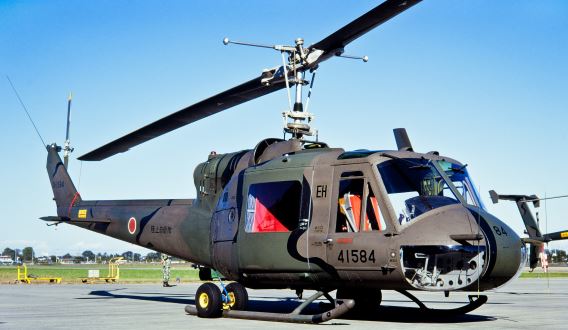
Eastern Army Helicopter Squadron UH-1H (above) and UH-1J
(Photos taken at Tachikawa, November 2000)

On June 21, 2019, the unit made headlines due to an unfortunate incident at Tachikawa, when a UH-1J came to grief during a morning training flight carried out within the airfield perimeter. Fortunately the two pilots escaped injury, but the entire length of the fuselage aft of the cabin was sheared off and the main rotor damaged by having come into contact with the ground, as was clearly seen in media reports (link). The training profile had involved practicing landing following a simulated tail rotor failure within the airfield’s designated autorotation zone. Announced in October that year, the findings of the crash investigation attributed the cause to failings on the part of the instructor pilot.
Snapshots of Eastern Army Helicopter Squadron Operations
September 1, 2019 / Integrated Emergency Response Drill
 (Photo: JGSDF/Eastern Army)
(Photo: JGSDF/Eastern Army)
The city of Mishima and village of Kannami in Shizuoka Prefecture were the venues selected for a one-day training exercise designed to improve disaster response capabilities and coordination.
September 2019 / Typhoon No. 15
 September 2019. In the aftermath of Typhoon No. 15, the Eastern Army deploys a camera-
September 2019. In the aftermath of Typhoon No. 15, the Eastern Army deploys a camera-
equipped UH-1J (above) to assist in damage assessment. In the affected areas of Chiba
Prefecture, a survey was made of those properties with blue tarpaulins covering their roofs.
 (Photos: JGSDF/Eastern Army)
(Photos: JGSDF/Eastern Army)
 On September 25, 2019, an Eastern Army Helicopter Sqn UH-1J was called upon to once again
On September 25, 2019, an Eastern Army Helicopter Sqn UH-1J was called upon to once again
put the camera equipment to use. On this occasion, a two-day search was conducted around the
village of Doshi, Yamanashi Prefecture, where a person was still missing after Typhoon No. 15.
(Photo: JGSDF/Eastern Army)
October 2019 / Typhoon No. 19
Following the 19th typhoon, which passed though in October 2019, elements of the Eastern Region Helicopter Sqn were sent on a disaster relief operation to Nagano Prefecture. Initially, four UH-1Js conducted reconnaissance and rescue operations along part of the Chikuma River on October 13. Out of the six helicopters involved the following day, two were equipped to relay images from the scene in real time. A total of 38 people were airlifted to safety during the course of this operation alone.
 Equipped to relay images from the scenes of natural disasters, an Eastern Army Helicopter Sqn
Equipped to relay images from the scenes of natural disasters, an Eastern Army Helicopter Sqn
UH-1J is prepared (above) and departs for Nagano Prefecture.
(Photos: JGSDF/Eastern Army)

February 28 to March 7, 2020 / Training Review of Helicopter Squadron
 (Photo: JGSDF/Eastern Army)
(Photo: JGSDF/Eastern Army)
Designed to assist in maintaining and improving the squadron’s level of training based on the results of daily evaluations, manoeuvres were conducted at the Soumagahara and Fuji exercise areas, in Gunma and Shizuoka prefectures, respectively. This was the second major training exercise in fiscal year 2019, which ended on March 31. Held over seven days from mid-September 2019, the previous training had also featured the 4th Anti-Tank Helicopter Squadron and thus involved the coordination of the Eastern Region Aviation Group as a whole. In addition to Soumagahara the training had been carried out at the Sekiyama exercise area in Niigata Prefecture.
 The Eastern Army Helicopter Squadron flew the very last flight of a JGSDF OH-6D,
The Eastern Army Helicopter Squadron flew the very last flight of a JGSDF OH-6D,
on March 26, 2020. (Photo: Japan Ministry of Defense/JGSDF Eastern Aviation)
Eastern Army Helicopter Squadron Markings
HQ Flight
 (Photo: Iruma, Nov. 3, 2009)
(Photo: Iruma, Nov. 3, 2009)
Retired early in 2020, the OH-6Ds formerly assigned to the HQ Flight of the Eastern Army Helicopter Squadron carried a white stripe angled rearward on their cabin doors. The OH-1s operated now (below) just have a black EH on each side of their fuselages.
 (Photo: Tachikawa, Nov. 10, 2013)
(Photo: Tachikawa, Nov. 10, 2013)
1st Flight
The 1st Flight’s UH-1Hs and Js are distinguished by a white V nose marking and a single white stripe angled forward on the rear fuselage. Previously, the unit’s badge (above) consisted of a black eagle with outspread wings superimposed on EAH 1 Avn in a yellow, pale blue and white U.S. insignia-shaped design. The motto possibly reads ‘We are keeping the peace and freedom’, the crew chief’s name appeared bottom left, ‘Since 1969’ bottom right.
These photos from an aviation photographer’s website (link) show the white markings in August 2008 and the squadron badge two months later. Along with the white markings, the same badge was on the doors of the UH-1J sent to the Yokota Friendship Day in September 2010.
As can be seen below, the UH-1Js lost their badges at some stage in the early 2010s.
 (Photo: Tachikawa, Nov. 10, 2013)
(Photo: Tachikawa, Nov. 10, 2013)
 (Photo: Tachikawa, November 2000)
(Photo: Tachikawa, November 2000)
In the early 2000s, the 1st Flight of the Eastern Army Helicopter squadron also flew UH-60JAs. As can be seen in the photo above, these also featured chevrons, in this case above rather than below the nose, and a diagonal white stripe on either side of the engine cover.
2nd Flight
 (Photo: Komaki, February 2014)
(Photo: Komaki, February 2014)
Initially carrying just unit badges on the doors, the following markings (seen in the above photo) have reportedly been used together by the 2nd Flight since November 2002.

On the pilots’ doors, ahead of serial number: A circular badge (above) with a blue and red ‘2’ on a yellow blackground. The number incorporates a dragon, and the abbreviation EAH in white-outlined red and Tachikawa in black appear on the top and bottom, respectively, of a green border. (But see link below)
On nose: Green-bordered yellow rectangle beneath the last two digits of the aircraft’s serial number. Black TACHIKAWA TOKYO and red outlined EAH and AVN on either side of blue and red ‘2’ again incorporating a dragon.
However, the top design on this website page (link) was seen on a UH-1J at Kisarazu in October 2003. Note the 2008 versions of the main badge on the same website page have a predominantly green UH-1 silhouette superimposed over the ‘2’.
 (Photo: Tachikawa, November 2000)
(Photo: Tachikawa, November 2000)
|
Central (MH) |
Formed | Mar. 1, 1968 (Yao) |
| Current Base | Yao (3rd Flt: Miho/Camp Yonago) |
The Central Army Helicopter Squadron was newly formed on March 1, 1968.
 A pair of UH-1Bs from the Central Army Helicopter Squadron parked at JMSDF Ozuki in May 1977.
A pair of UH-1Bs from the Central Army Helicopter Squadron parked at JMSDF Ozuki in May 1977.
Having mistranslated chūbu (central) as middle, the JGSDF applies an M as a unit identifier
rather than a C. (Photo: Takao Kadokami)
 An MH-marked Kawasaki OH-1 visiting JMSDF Maizuru in July 2014.
An MH-marked Kawasaki OH-1 visiting JMSDF Maizuru in July 2014.
(Photo: Hunini via Wikimedia Commons)
 In September 2014, a Central Army Helicopter Sqn UH-1J was a guest at the Komatsu airshow.
In September 2014, a Central Army Helicopter Sqn UH-1J was a guest at the Komatsu airshow.
(Photo: i北陸 [i-Hokuriku] / Hokuriku region official event and tourist destination blog [link])
 Central Army Helicopter Squadron OH-6Ds at (above) JGSDF Yao, Osaka Prefecture, in
Central Army Helicopter Squadron OH-6Ds at (above) JGSDF Yao, Osaka Prefecture, in
October 2016, and JGSDF Izumi, Osaka Prefecture, in April 2018.
 (Photos: Hunini via Wikimedia Commons)
(Photos: Hunini via Wikimedia Commons)
 The official handover ceremony for the first UH-2 to enter regional squadron service took place
The official handover ceremony for the first UH-2 to enter regional squadron service took place
in a hangar at the Central Army’s Yao base on April 19, 2024. The aircraft had arrived
the previous month. (Photo: JGSDF Yao via X @JGSDF_YAO)
Snapshots of Central Army Helicopter Squadron Operations
Please see JGSDF Squadron Histories Part 1 for details on the following operations that involved Central Army Helicopter Squadron participation:
(3rd AvSqn)
January 24, 2011 / Mt. Takamikura Forest Fire
June 3, 2014 / Forest Firefighting, Aioi, Hyogo Prefecture
October 13–14, 2018 / Nankai Rescue 30 Training Exercise
June 21–22, 2019 / Forest Firefighting, Kitagawamura, Kochi Prefecture
 The pilot of a Central Army Helicopter Squadron UH-1J gingerly lifts a bucket from the
The pilot of a Central Army Helicopter Squadron UH-1J gingerly lifts a bucket from the
ground during the operation near the village of Kitagawa in June 2019. The official
statistics state that a total of 148 tonnes of water were carried in 44 drops.
(Photo: Japan Ministry of Defense/JGSDF)
Taken from the Japan Ministry of Defense press release dated June 22, 2019, the chronology of the key events in the aviation-related aspects this operation were as follows:
June 21, 2019
05:00 Local fire services having been unable to deal with a fire that had broken out the previous day near the village of Kitagawa in the Aki District, the Kochi Prefecture governor formally requests assistance through the local JGSDF garrison based in the city of Kochi.
06:02 A 14th AvSqn UH-1J departs JGSDF Kita-Tokushima and commences aerial firefighting operations at 07:21.
07:14 Two TV camera-equipped Central Army Helicopter Squadron UH-1Js depart Yao to gather information from the scene of the fire.
 Away from the action, Central Army Helicopter Squadron personnel do the honours
Away from the action, Central Army Helicopter Squadron personnel do the honours
during a refueling stop. (Photo: Japan Ministry of Defense/JGSDF)
10:06 A Central Army Chinook departs JGSDF Camp Yonago/Miho and commences aerial firefighting 12:52.
12:01 Two more Central Army Chinooks depart JGSDF Camp Yonago/Miho and commence aerial firefighting 15:16.
14:50 A 14th AvSqn UH-1J departs JGSDF Kita-Tokushima to join the aerial firefighting effort.
June 22, 2019
06:00 Having received formal request to withdraw from Kochi Prefecture governor, the JGSDF units stand down. The operation had also needed the presence of eight troops and four vehicles on the ground.
 A pair of Central Army Helicopter Squadron UH-1Js depart Yao during the operations conducted
A pair of Central Army Helicopter Squadron UH-1Js depart Yao during the operations conducted
in the aftermath of Typhoon No. 19 in October 2019. The unit was tasked with two missions:
rescuing those affected by floods and landslides and the relaying of live imagery.
(Photo: JGSDF Central Army via Twitter @JGSDF_MA_pr)
February 21–23, 2020 / Nankai Rescue 01 Training Exercise
 (Left) Joint training with All-Japan Hospital Association Medical Assistance Team (AMAT)
(Left) Joint training with All-Japan Hospital Association Medical Assistance Team (AMAT)
members and (right) collaborative training with personnel from Nagoya-based Toho Gas,
both at JGSDF Kasugai Army Camp in Aichi Prefecture.
(Photos: Japan Ministry of Defense/JGSDF 10th Division)
As in previous years, the Central Army Helicopter Squadron actively participated in this major exercise, which tests inter-command cooperation and responses with local governments and related organizations in preparation for a major earthquake in the region. (Numbered following the Japanese year system, the latest exercise, Nankai Rescue 01, was held in February 2020, which is actually in Reiwa 2 but in fiscal year Reiwa 1).
 (Left) Using an in this case ski-equipped Central Army Helicopter Squadron Chinook to utilize air
(Left) Using an in this case ski-equipped Central Army Helicopter Squadron Chinook to utilize air
mobility for rapid deployment to an area, actually the Higashi-Kishu disaster relief base in Mie
Prefecture, where volunteers have been “stranded” and (right) a human chain of JSDF troops
loads relief supplies onto a Chinook at the JGSDF Hisai Army Camp training ground.
(Photos: Japan Ministry of Defense/JGSDF 10th Division)
May 7–11, 2020 / Forest Firefighting, Asago, Hyogo Prefecture
 Having just had a water bucket attached, the Chinook participating in the May 2020 operation
Having just had a water bucket attached, the Chinook participating in the May 2020 operation
gains height above the Minami-Tajima Sports Center. (Photo: Japan Ministry of Defense)
A fire that had broken out on May 7 in the hills above the city of Asago was still ablaze the following day, so at the late hour of 23:00 the Hyogo Prefecture governor issued a formal request for JGSDF assistance.
On May 9, firefighting operations got under way with two 3rd AvSqn UH-1Js from 06:00 while a single Chinook flew in from its base at Miho. The former were 80 km away from the scene, but the latter was 130 km away and used the exercise ground at JGSDF Aonohara, further south in Hyogo Prefecture, as a refueling point. Water collection was facilitated by having each type of helicopter allocated one of two local dams. The UH-1Js were operated locally from the Tajima Livestock Market, the Chinook from the Minami-Tajima Sports Center.
No operations were conducted on May 10, presumably due to bad weather, but May 11 saw the most activity, when a single 3rd AvSqn UH-1J and a Chinook between them dropped 30 of a total of 81 tonnes of water between 09:00 and 13:00. When finally brought under control, the blaze had burned 20 hectares of forest. The governor’s request for the JGSDF’s withdrawal was sent at 14:40.
YouTube Videos
A two-minute YouTube video (link), professionally shot by Sankei News, shows the 13-aircraft formation mounted by the Central Army Aviation Group on January 9, 2019, to mark the first formation training flight of the New Year. After departure from Yao in Osaka, the route followed for the one-hour flight takes the formation north to Kyoto and Uji before heading south towards Nara.
At a running time of more than 30 minutes, this somewhat longer YouTube video (link) shows helicopters from the Central Army Helicopter Squadron and from the 3rd, 10th, 13th and 14th aviation squadrons during operations from Akeno at the time of the Typhoon No. 19 relief operations, October 13–14, 2019.
Central Army Helicopter Squadron Markings
 (Photo: i北陸 [i-Hokuriku] / Hokuriku region official event and tourist destination blog [link])
(Photo: i北陸 [i-Hokuriku] / Hokuriku region official event and tourist destination blog [link])
In August 2013, a Central Army Helicopter Squadron UH-1H participated in the Crossland Oyabe Helicopter and Fire/Crime Prevention Festival, mentioned elsewhere on this website (link), in Toyama Prefecture. Shown in the above photo, the aircraft sported the badge (below) of the squadron’s 2nd Flight on its nose.
 2nd Flight, “Middle” (Central) Army Helicopter Squadron
2nd Flight, “Middle” (Central) Army Helicopter Squadron
(Image from plastic model mail order site [link])
The 3rd Flight formed with two CH-47Js at Camp Yonago/JASDF Miho on March 27, 2018. By July 2018, one of the aircraft was sporting a rear rotor mast marking, seen here in December the same year (link). Positioned on a green part of the standard camouflage, this comprises four black silhouettes of geese in flight, edged in camouflage brown, superimposed on the black letters MA (for Middle Army) and the camouflage brown Roman numerals III for 3rd Flight. GEESE FLIGHT is written in black beneath the marking (link).
 At some stage early in 2023, a now grey unit marking (still comprising four bird shapes flying across
At some stage early in 2023, a now grey unit marking (still comprising four bird shapes flying across
the Roman numeral III) was applied above the words GEESE FLIGHT to CH-47J 52974 of the
Central Army Helicopter Sqn’s 3rd Flight. The photos above and below were taken at Komaki
in September 2023, when the aircraft was lacking its MH unit code. A shot of 52974 on
a somewhat brighter day at Yao in October 2023 can be found here (link).
 (Photos: けーしー via X [formerly Twitter] @kc767_404)
(Photos: けーしー via X [formerly Twitter] @kc767_404)
Central Army Helicopter Squadron Special Markings
October 2012 Central Army 50th Anniversary
 Yao, October 2012. A Central Army Helicopter Squadron OH-1 is used to proclaim the
Yao, October 2012. A Central Army Helicopter Squadron OH-1 is used to proclaim the
50’(sic)Anniversary of the establishment of the JGSDF’s Middle (sic) Army.
The commemorative marking was also carried on AH-1S 73461 (link).
(Photo: Hunini via Wikimedia Commons)
October 2015 Akeno Army Camp 60th Anniversary / OH-1 32622
 (Photo: なすとろ[Nasutoro] via Twitter @geeta2526)
(Photo: なすとろ[Nasutoro] via Twitter @geeta2526)
As seen in the photo (above) taken at Akeno Army Camp’s 60th anniversary in 2015, a Central Army Helicopter Squadron OH-1 sported primarily the kanji 忍 (nin) from ninja on its nose (link) and was covered in a contradictory flurry of red and white blossoms in the shape of shuriken, the weapons more popularly known as a ninja stars (link).
May 2018 Daisen Temple Festival Promotion Tie-in / CH-47J 52926

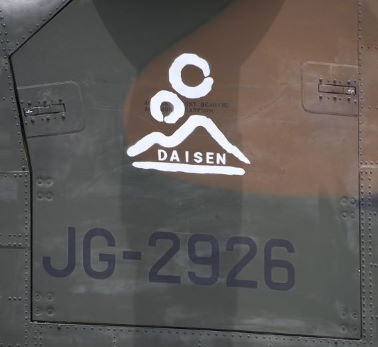 (Photos: Hunini via Wikimedia Commons)
(Photos: Hunini via Wikimedia Commons)
In effect, the Chinook—from the then only recently formed 3rd Flight—pulled double duty as a mobile billboard for a local festival initiative designed to encourage tourism to Tottori Prefecture, where the aircraft is based.
Incorporating the word DAISEN, the tail marking was actually a plain, white version of the logo designed for the promotion, an official version of which was neatly fitted into the crew emergency exit window.
 (Photo: Hunini via Wikimedia Commons)
(Photo: Hunini via Wikimedia Commons)
The script accompanying the official logo provided the information that the festival was marking 1,300 years (with the colours of the mountain landscape logo, when read vertically, forming the number) since the founding of Daisen Temple in 718. The temple sits atop Mt. Daisen, the highest in the Hōkikuni region, the ancient name for modern-day Tottori Prefecture.
|
Western (WH) |
Formed | Mar. 1, 1968 (Metabaru) |
| Current Bases | Metabaru/Takayubaru |
The Western Army Helicopter Squadron was newly formed on March 1, 1968.
While two flights were stationed at Metabaru, the airlift-dedicated 3rd Flight was formed a decade later in March 1978 and was joined at Takayubaru by an HQ Flight initially operating four OH-6Ds and three OH-1s in March 1994.
On March 28, 2000, the 3rd Flight’s KV-107IIA-4s were officially replaced by CH-47JA Chinooks, making the Western Army Helicopter Squadron the only one of its kind in having what its website (link) refers to as the four aircraft-type (CH-47JA, OH-1 [formerly OH-6D], UH-1J, UH-60JA) “B” formation.
Currently at Metabaru the HQ Flight and 2nd Flight are flying the UH-1J alongside the 1st Flight’s UH-60JAs. The OH-1s have been passed to the HQ Flight of the 3rd Anti-tank Helicopter Unit.
WESTERN ARMY HELICOPTER SQUADRON
AIRCRAFT THROUGH THE DECADES
 Fuji-built Western Army Helicopter Squadron UH-1B 41510 was a visitor to JASDF Tsuiki AB in
Fuji-built Western Army Helicopter Squadron UH-1B 41510 was a visitor to JASDF Tsuiki AB in
November 1971. (Photo: Takao Kadokami)
 Two Western Army Helicopter Squadron UH-1Bs were the JGSDF representatives sent to the
Two Western Army Helicopter Squadron UH-1Bs were the JGSDF representatives sent to the
JMSDF Kanoya open day in April 1973. (Photo: Takao Kadokami)
 Children shyly look inside a Western Army Helicopter Squadron KV-107IIA-4 on display at an
Children shyly look inside a Western Army Helicopter Squadron KV-107IIA-4 on display at an
event held at JGSDF Beppu, Oita Prefecture, in August 1979. (Photo: Takao Kadokami)
 A great action shot of the same KV-107IIA-4 at a temporary landing area in Oita City in November
A great action shot of the same KV-107IIA-4 at a temporary landing area in Oita City in November
1979. Delivered factory fresh to the Western Army Helicopter Squadron in October 1978, 51815
served with the 2nd Flight of the 2nd Helicopter Group at Kisarazu and was fitted with a weather
radar before joining the 101st AvSqn in Okinawa. Having in November 1999 ended its active
service career back where it had started, 51815 now resides at the Kasumigaura Army Camp
Public Information Center. (Photo: Takao Kadokami)
 Western Army Helicopter Squadron UH-1H 41636 at JASDF Tsuiki AB in November 1983. Fuji built
Western Army Helicopter Squadron UH-1H 41636 at JASDF Tsuiki AB in November 1983. Fuji built
a total of 133 UH-1Hs that were delivered between 1973 and 1991. The overall olive drab colour
scheme was standard until 1986–87. (Photo: Akira Watanabe)
This Western Army Helicopter Squadron OH-6J was photographed at Nyutabaru in January 1984 (link).
 A lineup of Western Army Helicopter Squadron KV-107II-4s on the ramp at Takayubaru in
A lineup of Western Army Helicopter Squadron KV-107II-4s on the ramp at Takayubaru in
April 1987 (Photo: Takao Kadokami)

(Above and below) Two now pattern-camouflaged, WH-marked helicopters attend an event at
their Takayubaru home base in April 1989; UH-1H 41692 (above) and KV-107II-4 51731.
(Photos: Takao Kadokami)

 Although in a Naha “tropical” colour scheme, this WH KV-107IIA-4 was caught on camera on
Although in a Naha “tropical” colour scheme, this WH KV-107IIA-4 was caught on camera on
pasture land near Mt. Aso, Kumamoto Prefecture (Photo: Takao Kadokami, Oct. 1993)
 As the hot-rod LR-1 bears down on them in the distance, the traditional Those Magnificent Men in
As the hot-rod LR-1 bears down on them in the distance, the traditional Those Magnificent Men in
Their Flying Machines-style mass formation opens an event held at Takayubaru in April 1994.
(Photo: Takao Kadokami)
 A trio of KV-107IIs at the same event at Takayubaru in April 1994 (Photo: Takao Kadokami)
A trio of KV-107IIs at the same event at Takayubaru in April 1994 (Photo: Takao Kadokami)
 A UH-1H parked in front of the Takayubaru admin building, April 1995. (Photo: Takao Kadokami)
A UH-1H parked in front of the Takayubaru admin building, April 1995. (Photo: Takao Kadokami)
 Equipped with nose-mounted weather radar (also shown below), another WH KV-107IIA-4 in
Equipped with nose-mounted weather radar (also shown below), another WH KV-107IIA-4 in
the Naha colour scheme, this time seen against a hangar at Takayubaru in April 1996.
 (Photos: Takao Kadokami)
(Photos: Takao Kadokami)
 (Photo [OH-6D, JASDF Tsuiki, Nov. 1998]: Takao Kadokami)
(Photo [OH-6D, JASDF Tsuiki, Nov. 1998]: Takao Kadokami)
 (Photo [CH-47JA, Takayubaru, Apr. 2002]: Takao Kadokami)
(Photo [CH-47JA, Takayubaru, Apr. 2002]: Takao Kadokami)
 (Photo: [UH-60JA, Takayubaru, Apr. 2003]: Takao Kadokami)
(Photo: [UH-60JA, Takayubaru, Apr. 2003]: Takao Kadokami)
 (Photo [Takayubaru, Apr. 2002]: Takao Kadokami)
(Photo [Takayubaru, Apr. 2002]: Takao Kadokami)
 A trio of helicopters assigned to the Western Army at JASDF Tsuiki in October 2012. Nearest
A trio of helicopters assigned to the Western Army at JASDF Tsuiki in October 2012. Nearest
the camera sits the OH-1 then assigned to the Western Army Helicopter Squadron’s HQ Flight,
standing in front of an AH-64D Apache of the 3rd Anti-Tank Helicopter Sqn. Obscured at
at the rear is a UH-60JA from the Western Army Helicopter Squadron’s 1st Flight.
(Photo: Takao Kadokami)
 Western Army Helicopter Squadron 3rd Flight CH-47JA photographed at Metabaru in
Western Army Helicopter Squadron 3rd Flight CH-47JA photographed at Metabaru in
March 2017. Details of its revised tail marking are given below.
(Photo: グりペン [Gripen] via Twitter @gripendemo)
 A Western Army Helicopter Squadron 2nd Flight UH-1J on static display at JASDF Tsuiki AB
A Western Army Helicopter Squadron 2nd Flight UH-1J on static display at JASDF Tsuiki AB
in November 2017. (Photo: Hunini via Wikimedia Commons)
 CO of the Western Helicopter Squadron’s 2nd Flight Lt. Col. Kōji Kurachi (left) presents a photo
CO of the Western Helicopter Squadron’s 2nd Flight Lt. Col. Kōji Kurachi (left) presents a photo
showing the arrival of the unit’s first UH-2 to the aircraft’s crew chief Staff Sgt. Tsuyoshi
Tokunaga, July 12, 2024. Following the Central Army Helicopter Squadron, the unit
at Metabaru became the second regional recipient of a UH-2.
(Photo: JGSDF Western Army via X @JGSDF_WA_pr)
Snapshots of Western Army Helicopter Squadron Operations
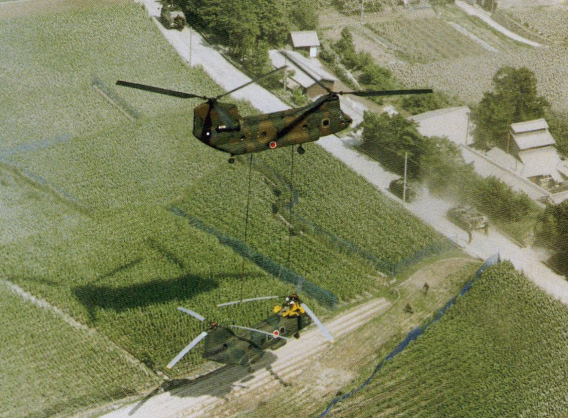 (Photo: 1st Helicopter Brigade via Twitter @1st_helb)
(Photo: 1st Helicopter Brigade via Twitter @1st_helb)
After having crash landed in a field of crops near Mt. Unzen, Nagasaki Prefecture, in June 1991, a KV-107II most likely from the Western Army Helicopter Squadron is itself ignominiously airlifted back for repairs by a CH-47J of the 1st Helicopter Brigade. At the time of the crash, in which nobody was hurt, the aircraft had been carrying newsmen sent to report on the aftermath of the Mt. Unzen eruption, which had claimed the lives of 43 people, including journalists and scientists.
Amazingly, a YouTube video of a Nagasaki TV news report (link) places the viewer on board the aircraft at the time of the accident, which was caused by the ingestion of volcanic dust into the engines.
July 9–10, 2013 / Forest Firefighting, Misato, Miyazaki Prefecture
 (Photo [July 10, 2013]: Japan Ministry of Defense/JGSDF)
(Photo [July 10, 2013]: Japan Ministry of Defense/JGSDF)
The Chinook-equipped 3rd Flight of the Western Army Helicopter Squadron made the news by being called into fight a fire in the Higashi-Usuki District of the town of Misato alongside UH-1Js from its neighbour at Takayubaru, the 8th AvSqn. Requested by the Miyazaki Prefecture governor mid-afternoon on July 9, an operation that had involved a total of around 200 personnel and 18 helicopters could be wound up before lunchtime the following day.
July 5 to August 20, 2017 / Northern Kyushu Torrential Rainfall
Initiated by the governors of Fukuoka and Oita prefectures contacting local JGSDF elements in the city of Fukuoka (4th Division) and the town of Kusu, respectively, this major rescue and disaster relief operation drew in elements of all three SDFs.
The final Ministry of Defense report stated that a total of nearly 82,000 personnel, 7,200 vehicles and around 170 aircraft had been involved. Even the Tokyo-based Eastern Army Helicopter Squadron was drafted in to assist its western counterpart and the locally based 4th AvSqn.
April 12, 2018 / Forest Firefighting, Misato, Miyazaki Prefecture
A fire having broken out once again in the Higashi-Usuki District of the town of Misato, fire service and JGSDF vehicles had been to the scene on the evening of April 11 and in the early hours of April 12. As the situation had demanded, two UH-1Js from the Western Army Helicopter Squadron lifted off from Takayubaru to gather information and relay TV images at around 06:20. Having received a request from the Miyazaki Prefecture governor, three firefighting-equipped Western Army Helicopter Squadron Chinooks and a WH forward air controller UH-60JA were dispatched at roughly 10-minute intervals from around 08:10.
The 8th AvSqn continued the forward air control function, launching single UH-60JAs into the fray later that morning and in the middle of the afternoon before the operation was called to a halt at 19:00. A total of 465 tonnes of water had been used in a total of 93 drops.
Western Army Helicopter Squadron Markings
1st Flight
 (Above and below) UH-1Hs of the Western Army Helicopter Squadron’s 1st Flight at Takayubaru in
(Above and below) UH-1Hs of the Western Army Helicopter Squadron’s 1st Flight at Takayubaru in
April 1986. At that time and up until at least the early 2000s, the 1st Flight’s marking comprised a
pilot’s helmet and visor-wearing seagull (with a ‘1’ on its shirt) flying next to a cloud over a
section of the curvature of the Earth, upon which was a plan-view silhouette of a dove.
 (Photos: Takao Kadokami)
(Photos: Takao Kadokami)
Now equipped with UH-60JAs, the 1st Flight was using this marking (link), seen on an aircraft a long way from home at Kisarazu, in October 2008.
2nd Flight
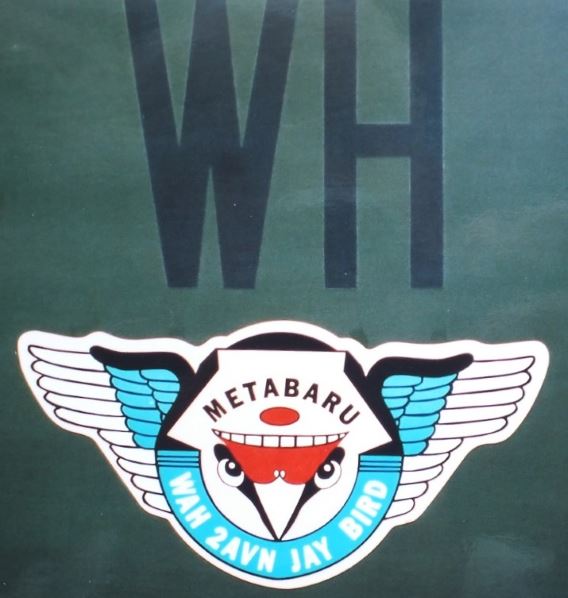 The marking of the 2nd Flight of the Western Army Helicopter Squadron
The marking of the 2nd Flight of the Western Army Helicopter Squadron
(Photo: Takao Kadokami [Takayubaru, April 2003])
3rd Flight
 The kingfisher marking seen on the tail of former Western Army Helicopter Squadron KV-107IIA-4
The kingfisher marking seen on the tail of former Western Army Helicopter Squadron KV-107IIA-4
51818 at Kasumigaura in May 2002. This was the aircraft that had been decorated with the
markings of all the units with which it had served during a career that had started in 1966
(See top of this page).
First seen in April 2001, the marking adopted by the 3rd Flight comprises a black kingfisher holding what has been described as a black and white prosthetic claw (link). The name KINGFISHERS appears in white-shadowed black lettering beneath.
 The same kingfisher marking of the now Chinook-equipped 3rd Flight of the Western Army
The same kingfisher marking of the now Chinook-equipped 3rd Flight of the Western Army
Helicopter Squadron seen on an aircraft at the unit’s Takayubaru home base in April 2003.
(Photo: Takao Kadokami)
 Following its return from overhaul at Kawasaki’s Gifu plant in 2016, the CH-47JA photographed at
Following its return from overhaul at Kawasaki’s Gifu plant in 2016, the CH-47JA photographed at
Metabaru in March 2017 (above) had been decorated with a different version of the kingfisher
marking. Twitter “twitchers” and others have sighted pink and black and, in February 2021,
blue and black versions of the same design.
(Photo: グりペン [Gripen] via Twitter @gripendemo)
|
Special Transport |
Formed | (As Dedicated Government Helicopter Sqn) Sept. 1985 (As Special Transport Helicopter Sqn) Dec. 1986 |
| Current Base | Kisarazu |
Placed under the command of the 1st Helicopter Brigade, the Special Transport Helicopter Squadron (Tokubetsu Yusō Herikoputa Hikōtai) received its first of three AS332Ls in December 1986. All these were placed in storage at Kasumigaseki following the service entry of three EC-225LPs in March 2006; it was to be 11 years before buyers were successfully found for two of them.
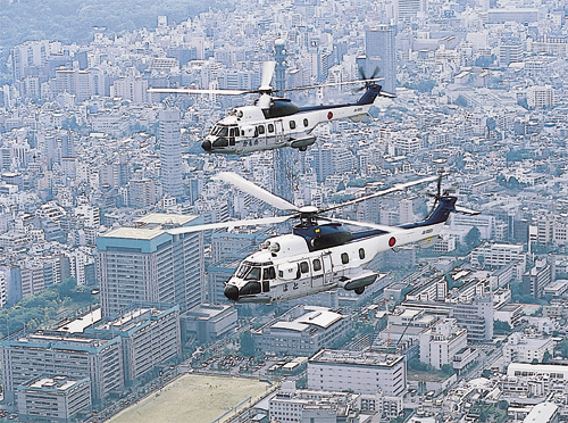 Two Aérospatiale AS332L Super Pumas overfly what was then the Japan Defense Agency (left,
Two Aérospatiale AS332L Super Pumas overfly what was then the Japan Defense Agency (left,
now the Ministry of Defense) circa 2001. Three aircraft of this type were acquired for the
Special Transport Helicopter Squadron in 1986 and placed in store after their withdrawal
from use in 2006. Two departed to join the fleet of an operator in New Zealand early
in 2018. (Photo: Japan Ministry of Defense)
Upon the formation of the 1st Transport Helicopter Group in place of the unit’s former parent 1st Helicopter Brigade on March 28, 2008, the special transport unit’s English designation remained the same, but in Japanese was changed from hikōtai to tai.
 An Airbus Helicopters H225 Super Puma at Tachikawa in November 2013. Carrying the unit code
An Airbus Helicopters H225 Super Puma at Tachikawa in November 2013. Carrying the unit code
STH instead of ST, three of the then Eurocopter EC225LPs replaced the AS332Ls during the
course of 2006.

The JGSDF symbol and English motto (above) have been applied to both sides of the current Super Puma aircraft. Depicting a stylized map of Japan being held in cupped hands, the design more closely matches the Japanese version of the motto, which expresses the desire of JGSDF personnel to protect and, should it ever be necessary, defend the country. According to the official Japanese explanation of the design on the Ministry of Defense website (link), the left hand expresses “robustness and strength”, the right “benevolence”. The design is slanted forward by 10 degrees to instill a “sense of movement and symbolize the forward-looking advances Japan is making”.
 September 2019. After Typhoon No. 15 had caused significant damage in parts of Chiba Prefecture,
September 2019. After Typhoon No. 15 had caused significant damage in parts of Chiba Prefecture,
Defense Minister Taro Kono was flown by Special Transport Helicopter Sqn Puma to JMSDF
Tateyama. From there he travelled to the disaster-affected city of Kimitsu to observe at
first-hand the relief operations then under way. (Photo: JGSDF/1st Helicopter Brigade)
|
Transport |
Formed | March 26, 2020 (Kisarazu) |
| Current Base | Kisarazu |
Formed on the CH-47J/JA in anticipation of the commencement of V-22B deliveries, the first two Ospreys were ferried from Iwakuni to Kisarazu on July 11, 2020. Flight operations commenced early in November 2020. (See 107th Sqn and 108th Sqn.)
The plan currently calls for all 17 Ospreys to be based at Kisarazu until July 2025, at which time the unit will be relocated to a base in Saga Prefecture.
 New additions to the JGSDF’s ranks in the summer of 2020 were the first two V-22B Osprey tiltrotors,
New additions to the JGSDF’s ranks in the summer of 2020 were the first two V-22B Osprey tiltrotors,
which were destined to join the Transport Aviation Group. As seen above and in this video (link),
the aircraft had been operated alongside U.S. Marine Medium Tiltrotor Training Squadron 204
(VMMT-204) MV-22s at MCAS New River, North Carolina, from summer 2019.
(Photo: JGSDF Public Affairs Office [@Japan_GSDF])
MAIN AVIATION SCHOOL/BRANCH SCHOOLS (UNIT CODES)
Main Aviation School, Akeno (S)
The Hōantai Aviation School that formed at Hamamatsu on October 15, 1952, became the JGSDF’s Aviation School on July 1, 1954. Training operations were commenced from Akeno in August 1955, following the relocation of the training units from Hamamatsu.
 Having originally been operated by the National Security Force in the 1950s, an L-21B bearing the
Having originally been operated by the National Security Force in the 1950s, an L-21B bearing the
S marking of the Main Aviation School was part of a Self-Defense Force exhibition held in
Oita City in 1968. (Photo: Takao Kadokami)
Placed under Main Aviation School control, an Air Training Support Squadron formed at Akeno on March 25, 1977, and has subsequently operated from both Akeno and the Fuji live-firing range.
Akeno Aviation School Special Markings
In October 2004, an AH-1S assigned to the Akeno school simply carried large white shapes (link). These were possibly to indicate to others that a newly qualified pilot was at the controls, as was common practice with the OH-6.
October 2015 Akeno Aviation School 60th Anniversary UH-60JA 43117 (link)
This aircraft was decorated with slogans, the kanji for dragon on the left (link) and right (link) sides of the fuselage, and with a dragon motif on the tail (link).
October 2016 JGSDF Akeno Camp 61st Anniversary OH-1 32609
 (Photo [October 2016]: kai via Twitter @kai21629430)
(Photo [October 2016]: kai via Twitter @kai21629430)
In October 2016, it was the turn of an Aviation School-assigned OH-1 (see photo above) to be displayed in special markings, on this occasion for JGSDF Akeno Army Camp’s 61st anniversary. The main elements of the design were: a large white nose marking that featured the kanji 忍 (nin) from ninja in combination with a large shuriken, the weapon more popularly known as a ninja star; a red-and-white disc on the rear fuselage, actually a rebus that decodes into the kanji for Akeno (明野), the well-known design that formed the tail code crest of the wartime Akeno Army Fighter School; and, on the tail, a silhouette map of Mie Prefecture and three rotors signifying the three JGSDF training schools (at Takigahara, Utsunomiya and Kasumigaura) located outside the prefecture.
November 2018 JGSDF Akeno Camp 63rd Anniversary
AH-1S 73478 / CH-47JA 52951 / UH-60JA
 (Photo: ばう via Twitter @bau610)
(Photo: ばう via Twitter @bau610)
Still bearing IVATH markings, the AH-1S (link) had a large white snake on its left side and a black version of the same design on its right side.
 (Photo: シリウス via Twitter @sirius_P)
(Photo: シリウス via Twitter @sirius_P)
The fuselage of the Akeno-based Chinook on static display featured a novel line of white bowing silhouettes depicting 11 JGSDF aircraft though the years. The design is more clearly visible here (link).
 (Photo: カリス[は休暇を続けたい] via Twitter @TeamCaris)
(Photo: カリス[は休暇を続けたい] via Twitter @TeamCaris)
An anonymous based UH-60JA carried the kanji 飛龍 (hiryū, [as in World War II bomber] meaning flying dragon, the radio call-sign for the type) on its rear fuselage, dragon-like designs, and the words Aviation School Maintenance Department The 3rd Section on the cabin door.
November 2019 JGSDF Akeno Camp 64th Anniversary
AH-1S 73489 / TH-480B 62355 / UH-60JA 43115
 The AH-1S featured ornate wing and feather designs on either side of its fuselage and crossed
The AH-1S featured ornate wing and feather designs on either side of its fuselage and crossed
silhouettes of an AH-1S and AH-64 on its tail. The tail of the white snake on the lower
fuselage (link) formed the ‘C’ of Celebration.
 (Photos: [Top] むいむい via Twitter @R1ffP1w1aX1b7BA;
(Photos: [Top] むいむい via Twitter @R1ffP1w1aX1b7BA;
[above] へいごろー via Twitter @heygoro384)
 The tail boom of a colourful TH-480B was used as a canvas on which to chart the school’s
The tail boom of a colourful TH-480B was used as a canvas on which to chart the school’s
training helicopter equipment history. (Photo: むいむい via Twitter @R1ffP1w1aX1b7BA)
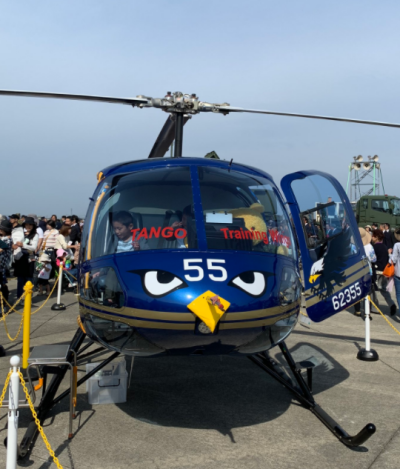 (Photo: へいごろー via Twitter @heygoro384)
(Photo: へいごろー via Twitter @heygoro384)
 For the November 2019 event, a based UH-60JA once again carried the kanji for
For the November 2019 event, a based UH-60JA once again carried the kanji for
hiryū, but this time the unit wording was emblazoned on its tail boom.
 (Photos: [Top] むいむい via Twitter @R1ffP1w1aX1b7BA;
(Photos: [Top] むいむい via Twitter @R1ffP1w1aX1b7BA;
[above] へいごろー via Twitter @heygoro384)
Iwanuma Branch School
Located in Sendai, Miyagi Prefecture, the Iwanuma Branch School formed on August 1, 1964 for fixed-wing aircraft pilot training and closed on March 19, 1973.
Kasumigaura Branch School (SK)
Opened on December 4, 1959.
 A Branch School-based UH-1H comes into land at Kasumigaura in late May 1983.
A Branch School-based UH-1H comes into land at Kasumigaura in late May 1983.
(Photo: Akira Watanabe)
It was at a Kasumigaura event in April 1996 that a “shark mouth” AH-1S (73476) made its debut (link), to be followed by a repeat performance on a different aircraft (73477) the following year (link).
Then, after a two-year gap, 73475 was painted up with a shark mouth and the Japanese 創立40周年記念 on its rotor mast to commemorate Kasumigaura Army Camp’s 40th anniversary in 2000 (link). On the left side, the crew member’s names were painted in white along the lower rim of the cockpit canopy framing, and a list of presumably the maintenance team’s names was on the fuselage beneath the exhaust.
In 2001, a large, white-edged red lightning flash was added to either side of the fuselage of the shark mouth AH-1S. On the left side only, its tail marking comprised a red and blue cobra’s head superimposed on two solid white triangular shapes. The aircraft can be seen from 5:10 to 7:05 on this long amateur video of the day’s events (link). Photo references are included on page 57 of the photo collection that carries the sloppy English title Wings of Japan Ground Self Defence Force, published by Hobby Japan early in 2020.
The AH-1S (like in 2000, 73475) that gave a flying display at Kasumigaura in April 2002 (link) was decorated with a shark mouth, a cheetah on the tail and a distinctive dual-stripe chevron on its rear undersides (link).
 An OH-1 is towed out of the hangar prior to a display flight at Kasumigaura in May 2008.
An OH-1 is towed out of the hangar prior to a display flight at Kasumigaura in May 2008.
(Los688 via Wikimedia Commons)
JGSDF Branch School Kasumigaura Aircraft (May 2014)
 AH-64D Apache
AH-64D Apache
 CH-47J Chinook
CH-47J Chinook
 AH-1S Cobra
AH-1S Cobra
Utsunomiya Branch School (SU)
Assumed responsibility for fixed-wing training on March 19, 1973, the day on which the Iwanuma Branch School was closed.
UtSUnomiya Residents over the Years
A look at some of the various types of aircraft that have worn the SU identifying letters of the Utsunomiya Branch School since the 70s.
 An Utsunomiya-based T-34A seen on a visit to Akeno in August 1977. (Photo: Takao Kadokami)
An Utsunomiya-based T-34A seen on a visit to Akeno in August 1977. (Photo: Takao Kadokami)
 Sporting additional high-visibility dayglo areas on its fuselage, an OH-6J lifts off from the flight line
Sporting additional high-visibility dayglo areas on its fuselage, an OH-6J lifts off from the flight line
at Utsunomiya in April 1977. (Photo: Akira Watanabe)
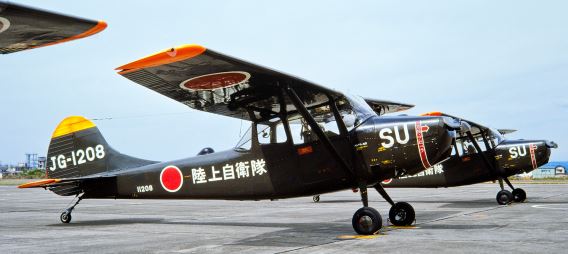 Two of the 14 L-19E-1s built under license at Fuji Heavy Industries’ Utsunomiya factory in 1957–58
Two of the 14 L-19E-1s built under license at Fuji Heavy Industries’ Utsunomiya factory in 1957–58
that were still in service at the adjoining base in April 1977. (Photo: Akira Watanabe)
 Fuji also built 27 of the LM-1 five-seater version of the T-34A. One of these is seen at
Fuji also built 27 of the LM-1 five-seater version of the T-34A. One of these is seen at
Utsunomiya in April 1977. (Photo: Akira Watanabe)
 An LR-1 at Utsunomiya in May 1984 displays a low-vis colour scheme applied for experimental
An LR-1 at Utsunomiya in May 1984 displays a low-vis colour scheme applied for experimental
purposes only. Not surprisingly featuring a matt instead of the previous gloss finish as well as
black rather than white markings, the size of national markings was reduced and
dayglo areas removed. (Photo: Akira Watanabe)
 Obtained direct from Hughes, the TH-55J was the JGSDF’s basic rotary-wing training workhorse
Obtained direct from Hughes, the TH-55J was the JGSDF’s basic rotary-wing training workhorse
from 1972 to 1995. Seen at Utsunomiya in May 1984, this example continued to provide training
as an instructional airframe at the Japan Aviation Academy’s Wajima Noto Airport Campus
in Ishikawa Prefecture until around 2019. (Photo: Akira Watanabe)
 Strongly influenced by the U.S. Army’s airborne cavalry concept and operations in the Vietnam
Strongly influenced by the U.S. Army’s airborne cavalry concept and operations in the Vietnam
War, the JGSDF received 90 Fuji-built UH-1Bs between 1962 and 1971 and bestowed on them
the unofficial name Hiyodori; this pair of “bulbuls” were native to Utsunomiya in May 1984.
The aircraft in the background was last seen, in a somewhat derelict state, at a tonkatsu (pork
cutlet) restaurant in Ogawamachi, Ibaraki Prefecture, in 2004. (Photo: Akira Watanabe)
 One of the two Fuji TL-1s based at Utsunomiya seen on a visit to Tachikawa in November 1989.
One of the two Fuji TL-1s based at Utsunomiya seen on a visit to Tachikawa in November 1989.
Originally built as KM-2s for the JMSDF, these aircraft were diverted to JGSDF use for
fixed-wing pilot training in 1981 and passed on to their initially intended recipient in
the early 1990s. (Photo: Akira Watanabe)
 (Photo: Akira Watanabe)
(Photo: Akira Watanabe)
The above photo shows the JGSDF Sky Hornets display team performing at Utsunomiya in May 1981.
Formed in 1974 and made up of instructor pilots, the team initially flew four OH-6Js but by the end had long since transitioned onto the OH-6D and was choreographing five-aircraft routines and, unlike the Blue Impulse, using coloured smoke. In addition to its Utsunomiya home base, the team also participated at Kasumigaura and Tachikawa events.
A 10-minute YouTube video exists of their 2012 performance at Utsunomiya (link). J-HangarSpace was present for the 2013 display (below), which comprised two displays interspersed by a rest and refuelling break.




Following the cessation of new OH-6D pilot courses, the team performed its last display at Utsunomiya on May 25, 2014, bringing its 40-year history to an end.

Featuring a box art photo by Hajime Ishihara, plastic model maker Hasegawa marked the end of an era by bringing out a limited edition kit (above) of the specially adorned aircraft that was on static display that day.

To end with the commemorative marking theme, an OH-6D had been painted and placed on display (above) to commemorate the 40th anniversary of JGSDF Kita-Utsunomiya in May 2013.
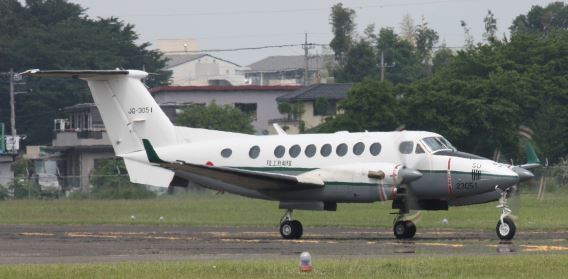 This Raytheon (Beechcraft) LR-2 became the latest fixed-wing aircraft to wear the SU unit
This Raytheon (Beechcraft) LR-2 became the latest fixed-wing aircraft to wear the SU unit
identification code in 2010.
Special Markings / SU LR-1
In May 2009, LR-1 22016 was seen at Utsunomiya bedecked in several yellow flashes and an as yet unidentified white tail marking (link).
 (Photo [posted Jan. 2024]: オポッサム via X [formerly Twitter] @Opossum787)
(Photo [posted Jan. 2024]: オポッサム via X [formerly Twitter] @Opossum787)
At Kita-Utsunomiya three years later, in May 2012, LR-1 22019 was given an exotic scheme (above and link) incongruously featuring flames around the nose and what appeared to be a bird of paradise on the tail, its tail “streamers” extending along the fuselage. More than a year after the Great East Japan Earthquake and tsunami, slogans on the wingtip tanks said: DON’T GIVE UP, TOHOKU DON’T GIVE UP, JAPAN TO THE SHINING FUTURE. A message on the nosewheel door (link) announced that it would be last time that an LR-1 would be present at a Kita-Utsunomiya Army Camp commemoration day event, that its mission would be entrusted to its successor, an LR-2, and ended with a final arigatō gozaimashita.
Special Markings / SU UH-1J
May 2015 Kita-Utsunomiya Snake Design UH-1J 41819 (link)
May 2017 Utsunomiya School 44th Anniversary UH-1J 41803
Right side (link); left side (link)
May 2018 Kita-Utsunomiya UH-1J 41819
Whole aircraft, right side (link); right side art (1) (link) ; right side art (2) (link)
JGSDF Training Helicopter Cavalcade
 Former JGSDF H-13H (Kawasaki-Bell 47G-2) 30124 ended its days at the Dai-ichi Institute of
Former JGSDF H-13H (Kawasaki-Bell 47G-2) 30124 ended its days at the Dai-ichi Institute of
Technology in Kirishima, Kagoshima Prefecture. First delivered in December 1959, its flying
career at the Akeno Main Aviation School had ceased in October 1973.
(Photo [March 1976]: Takao Kadokami)
 On the baking hot apron at Akeno in August 1977, a maintenance crew member appears to be
On the baking hot apron at Akeno in August 1977, a maintenance crew member appears to be
receiving some ground engine run tuition on an H-13KH (Kawasaki-Bell 47G-3B/KH-4). 30201
was the first of a total of 19 of this variant operated by the JGSDF. In service at the very start
of the JGSDF in July 1954, the H-13 soldiered on until 1982. (Photo: Takao Kadokami)
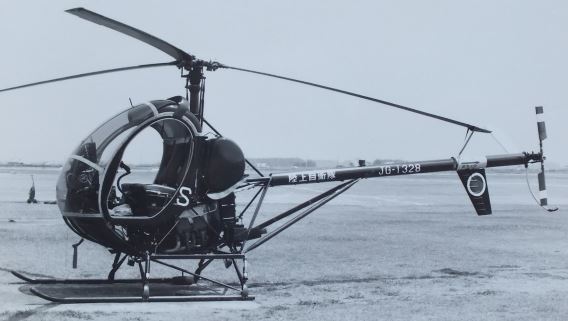 Also present at Akeno that same hot day in August 1977 was TH-55J 61328. A total of 38 aircraft of
Also present at Akeno that same hot day in August 1977 was TH-55J 61328. A total of 38 aircraft of
this type were delivered from 1971 to 1975 for use at all JGSDF helicopter training bases; the last
was withdrawn from service in the mid-1990s. This example is now in the storage hangar at the
Tokorozawa Aviation Museum, Saitama Prefecture, where it is given an annual public airing.
(Photo: Takao Kadokami)
 Akeno was naturally home to a number of OH-6Js, the type selected to replace the H-13 and L-19
Akeno was naturally home to a number of OH-6Js, the type selected to replace the H-13 and L-19
and to be the JGSDF’s standard observation helicopter; a total of 117 were delivered between
1969 and 1977. Training examples sported high-visibility orange tails and in some cases, as
here, orange fuselage undersides. (Photo [August 1977]: Takao Kadokami)
 The sun glinting off the top of its fuselage like navigation lights, a shiny new TH-480B lifts off from
The sun glinting off the top of its fuselage like navigation lights, a shiny new TH-480B lifts off from
Utsunomiya in May 2013. Hastening the end of OH-6D training in the JGSDF, manufacturer
Enstrom delivered the last 28 of the total of 30 TH-480B helicopters in double-quick
time over three years in response to a Defense Ministry concentrated procurement
programme. The last entered service early in 2015.
 At the Akeno Army Camp 60th anniversary event in 2015 event was this based TH-480B.
At the Akeno Army Camp 60th anniversary event in 2015 event was this based TH-480B.
The artwork aft of the cockpit depicts the sacred Meoto Iwa (Married Couple Rocks) that are
located just off the shore at Futami, Mie Prefecture, and over which the sun rises in summer.
(Photo: なすとろ[Nasutoro] via Twitter @geeta2526)
 The first of two U.S.-built AH-1S helicopters on display at Yokota AB in July 1982. These aircraft
The first of two U.S.-built AH-1S helicopters on display at Yokota AB in July 1982. These aircraft
were to U.S. Army AH-1E standard, identified by the upward-pointing exhaust, while the 90
built under licence by Fuji were equivalent to the AH-1F and have rearward-facing exhausts.
Delivered in June 1979, this aircraft is now on display at the JGSDF Public Information
Center at Asaka, Saitama Prefecture. (Photo: Akira Watanabe)
TRAINING SUPPORT ORGANISATION (SD)
After 42 years, the Air Training Support Squadron was reformed as the Aviation School Unit (official translation currently unknown) on March 26, 2019.
Each of 11 main disciplines within the JGSDF has its own School Unit, the task of which is to provide educational support at each discipline-specific training school, using the same equipment that trainees will encounter at the units to which they will be assigned.
In the case of JGSDF aviation operations, the in overall command Aviation School Unit has not surprisingly remained at Akeno, and one of the units that reports directly is the Fuji Flight Group at Takigahara Army Camp in Gotemba, Shizuoka Prefecture. The Group consists of three subgroups: headquarters, maintenance and communications.
The Fuji Flight Group’s mission is to use its helicopters in support of the education and training of the officer echelons and the various research programmes undertaken at JGSDF aviation schools and at the Fuji school. In view of the Fuji school’s distance from Akeno, the Group’s remit covers in particular the provision of on-the-spot support for that school’s operations, which include the exercises conducted at the Higashi-Fuji Training Ground.
 A Fuji-Bell UH-1H assigned to the Air Training Support Squadron.
A Fuji-Bell UH-1H assigned to the Air Training Support Squadron.
(Undated photo: Japan Ministry of Defense)
Established as the Fuji School Aviation Group in 1955, the unit was renamed the Fuji Flight Group at the time of its transfer to the Eastern Army Aviation Group in 1962 and transferred to come under the command of the then newly formed Air Training Support Squadron in March 1976. Its equipment has ranged from the initial fixed-wing L-19 to the current UH-1J helicopter, which was preceded by the H-13, KV-107II, OH-6, CH-47J and OH-1.
Air Training Support Squadron Aircraft at Akeno (August 1977)
 L-19A (Photo: Takao Kadokami)
L-19A (Photo: Takao Kadokami)
 KV-107II-4 (Photo: Takao Kadokami)
KV-107II-4 (Photo: Takao Kadokami)
 UH-1H (Photo: Takao Kadokami)
UH-1H (Photo: Takao Kadokami)
 Delivered in 1986 as one of five aircraft supplied by Boeing in kit form, the JGSDF’s first CH-47J
Delivered in 1986 as one of five aircraft supplied by Boeing in kit form, the JGSDF’s first CH-47J
is seen at Kisarazu in October 1987 during its time with the Training Support Squadron.
Operated by the Naha-based 101st AvSqn from 1996, 52901 was flown for the
last time on March 3, 2009. (Photo: Akira Watanabe)
Fuji Flight Group, Takigahara Army Camp
 (Photo [undated]: JGSDF/Takigahara Army Camp [link])
(Photo [undated]: JGSDF/Takigahara Army Camp [link])
Fuji Flight Group Marking
 (Photos [undated]: JGSDF/Takigahara Army Camp)
(Photos [undated]: JGSDF/Takigahara Army Camp)
Just about visible in the above UH-1J photos, close-up photos of this unit’s white, Mt. Fuji-inspired marking can be clearly seen in these photos from August 2005 (link).
EXPERIMENTAL FLYING UNIT (TE)
Most recently, the Test and Evaluation Command (TECOM) has been working with the Acquisition, Technology and Logistics Agency (ATLA) to conduct test flights of the XUH-2 from JGSDF Camp Akeno.
 (Photo [October 2015]: なすとろ[Nasutoro] via Twitter @geeta2526)
(Photo [October 2015]: なすとろ[Nasutoro] via Twitter @geeta2526)
Assigned to the JGSDF’s Test and Evaluation Command (TECOM), the specially marked OH-1 shown above was also present for the Akeno Army Camp’s 60th anniversary in 2015. The large kanji on the fuselage 飛実 are short for flight test. The inscription on the forward fuselage, 開発実験団 meaning Test and Evaluation Command, can be seen better in this shot (link).
 The kanji for hayabusa (peregrine falcon), the name adopted for the type, was
The kanji for hayabusa (peregrine falcon), the name adopted for the type, was
carried on the nose of the XUH-2 for the Akeno open day in November 2019.
(Photo: Hunini via Wikimedia Commons)
(All photographs on this website are copyright J-HangarSpace
unless otherwise stated.)
|
Japan Self-Defense Force Squadron (Ikaros, 1996) Watanabe, Akira, Japanese Air Arms, 1952–1984, (self-published in English), 1984 Japanese Wikipedia
|


